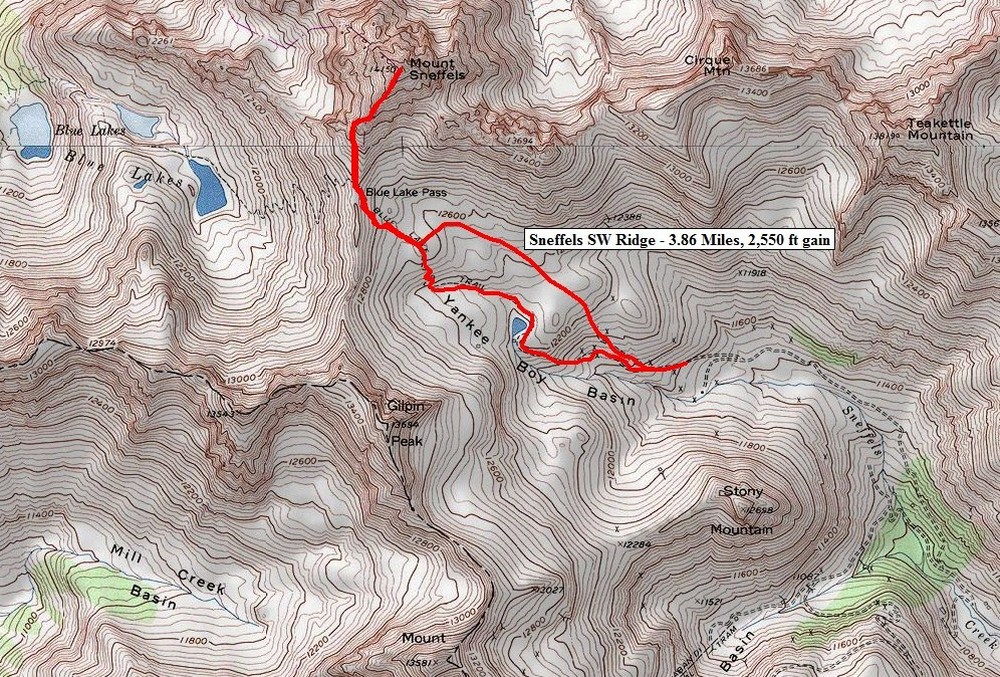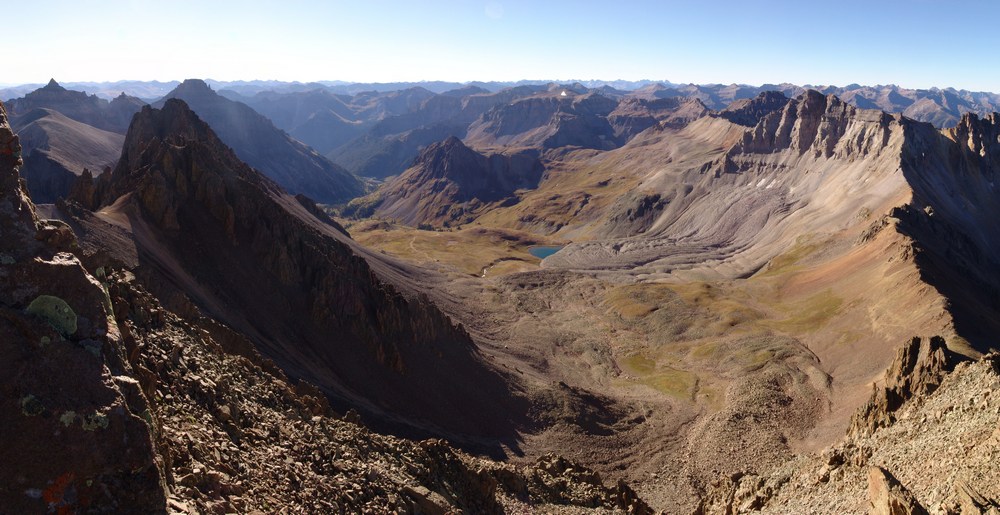Displaying items by tag: Mount Sneffels
Mount Sneffels - A taste of the Southwest Ridge
I've had my eye on Mount Sneffels for quite some time. This gem of a mountain located near Ouray, CO, is one of the most splendid-looking mountains in all of Colorado. Sneffels first caught my attention back in February, when I snowshowed on Miller Mesa, to the North of Sneffels.
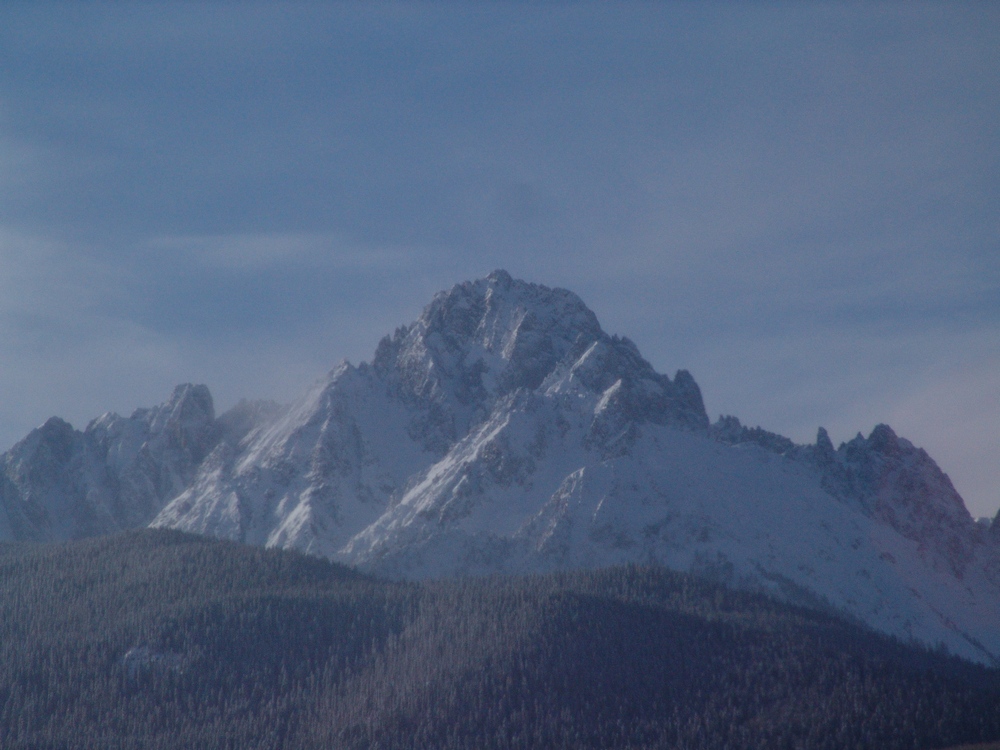
Mount Sneffels as seen in February, 2010.
Additionally, I was able to get great views of Sneffels and the surrounding rugged peaks back in June from the summit of Handies, and in July from the summits of Arrow and Vestal.
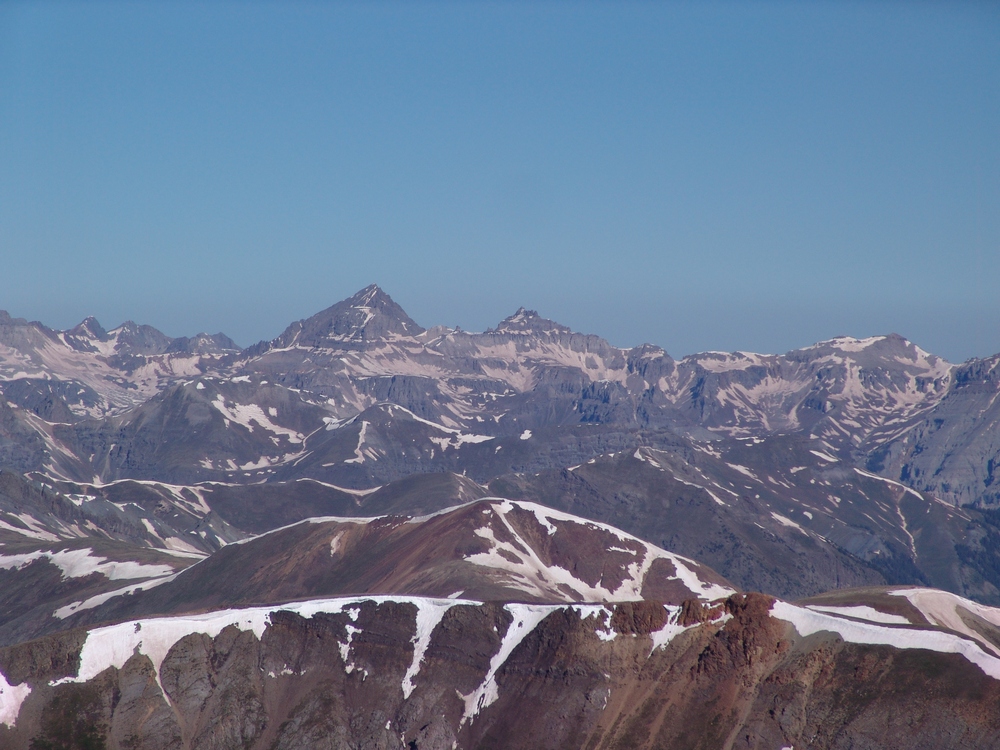
Sneffels and Teakettle as seen from Handies. Sneffels' pinnacles can barely be seen at the base of the Southwest ridge.
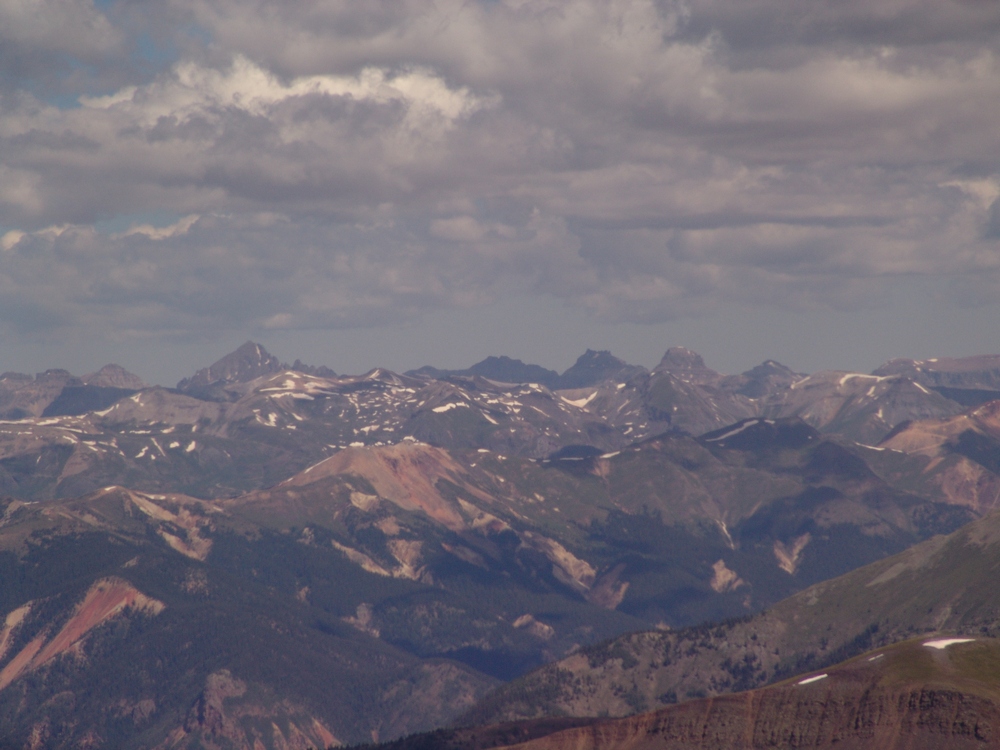
The Sneffels group as seen from Vestal.
The surrounding mountains are all very rugged, and access to the peak is accentuated by the well-traveled and world-famous Yankee Boy Basin.

The Sneffels "sub-range" (seen above) is probably the second most rugged group of mountains in all of Colorado, next to the Grenadier-Needle range. Sneffels is generally climbed via Yankee Boy Basin from the upper trailhead at 11,600 ft and up what is known as the Southeast Couloir route; however, for this trip, I'd had my mind set on the Southwest Ridge route of Sneffels, which follows the same basic start path of the standard route, but instead of going up the couloir, you gain the top of "Blue Lakes Pass" and then continue up the ridge to the top. In fact, the first recorded ascent of Sneffels, on September 10, 1874 (almost exactly 136 years before) was made by the Hayden Survey via the Southwest Ridge. The Hayden Survey had to "climb with care" because this route is "quite steep in some places."1
From Yankee Boy Basin, the Southwest Ridge looks to be unclimbable because of the jagged pinnacles, known as "The Hand." However, these are avoided by going up the back side of the pinnacles and up a series of steep gullies to gain the ridge, and eventually the top of Sneffels.
Here are some meaningful statistics from this adventure:
Peak summited:
Mount Sneffels: 14,150 ft. (ranked 27th in Colorado)
Total elevation gain: 2,550 ft.
Total distance hiked: 3.86 miles
Total time hiking: 5.5 hours
Total photos taken: 330
Total distance driven: 620 miles
14er # 41 for me.
Joining me on this ascent of Sneffels was my wife's best friend's husband - Arron Shaver. Arron is not an experienced mountaineer by any stretch of the imagination; however, he is a very athletic and fit individual with a love for the outdoors. Arron and I made plans earlier in the summer to tackle Sneffels together in September, and when the week we had planned to climb it rolled around, I received a very prompt call from Arron and we finalized our plans. We left Colorado Springs on Friday night and arrived at Yankee Boy Basin at around 10:30 PM. The drive was made more interesting because the power steering of my Jeep had begun to fail on the way over. Fortunately, this did not prove to be a huge problem and we were able to make camp near where the road has a sign that indicates that "short wheel-base 4WD vehicles only past this point." Although my Jeep is very capable, I did not know what to expect up the road, and did not want to test my vehicle in the dark. We set the alarm for 5 AM and crashed very quickly.
When the alarm went off we were both amazed by the huge drop in temperature from the night before. I am guessing that we woke up to 25-30 degree temps in the morning. After a quick breakfast of oatmeal, we were off to the races. We continued up the road another mile to the end of the road and the start of the trailhead. I was not overly impressed with the difficulty of the road and in retrospect, I would have driven much further had I known it was not a very difficult road. Once at the trailhead, Arron and I were greeted there by a few other hikers, about 5 in total. We started up the trail and quickly reached the fork in the trail for the two different routes available from this trailhead: the Southwest Ridge route (Blue Lakes Pass) and the standard Southeast couiloir route (Mt. Sneffels trail). We broke to the left towards Blue Lakes Pass and watched as the rest of the hikers headed up the standard route. From this point until the summit, Arron and I did not see another person the rest of the ascent.
Our route up Mount Sneffels.
Views of the surrounding peaks were outstanding, right from the start. Teakettle Mountain, Gilpin Peak, and Potosi Peak were impressive. Having seen them all at a distance from many vantage points this summer, it was great seeing them up close and personal!
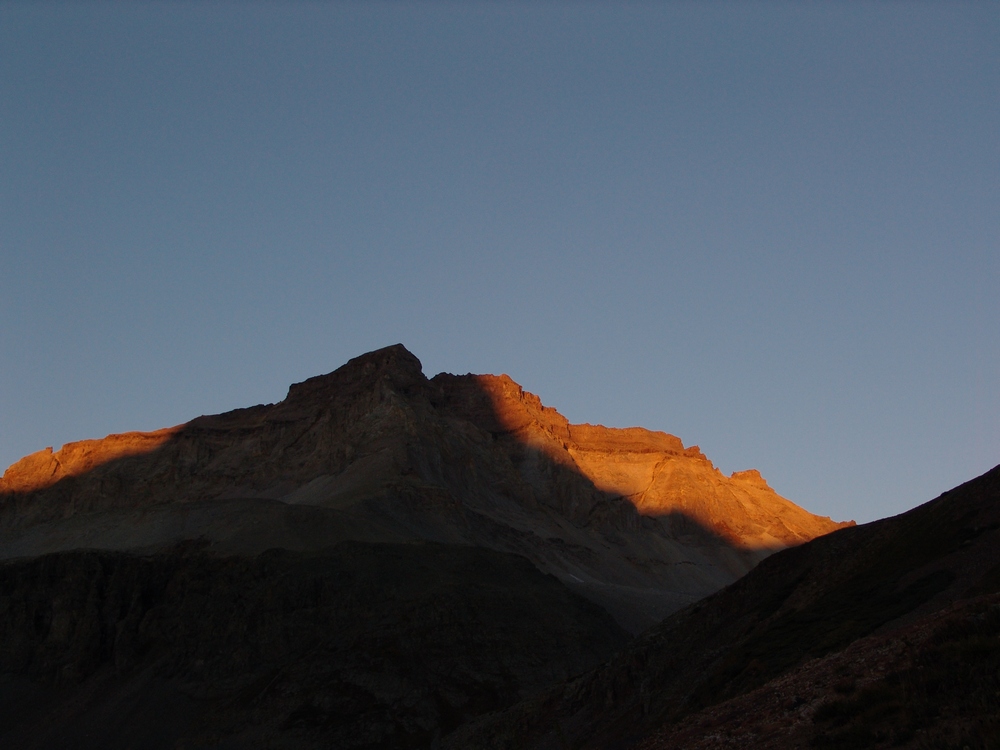
Gilpin Peak in alpenglow.
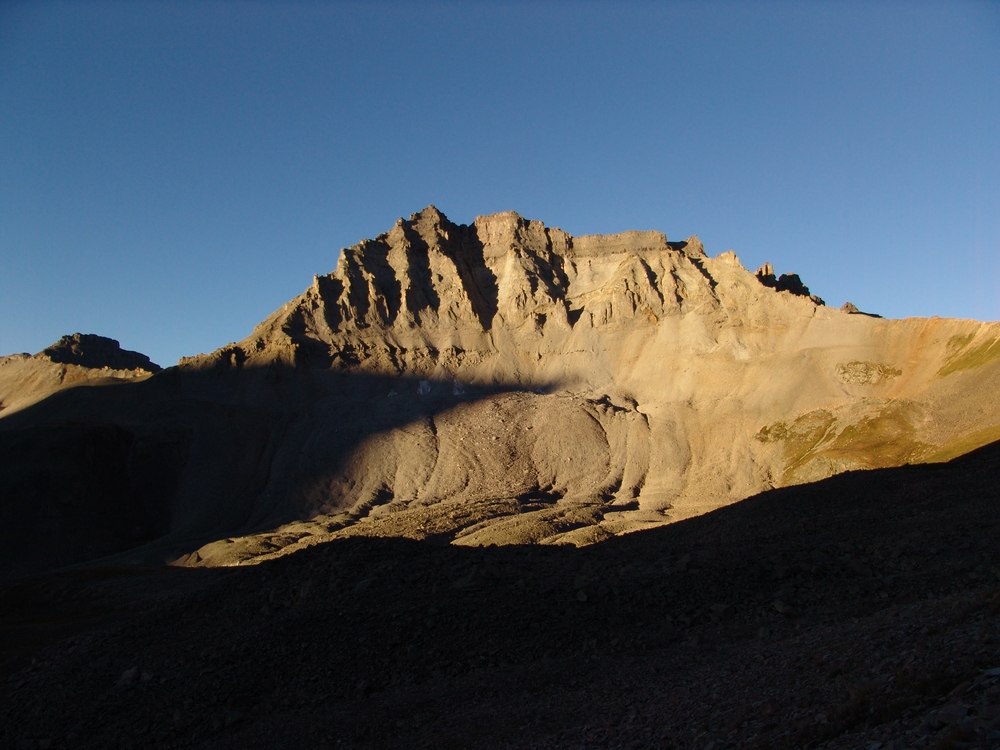
Gilpin Peak at sunrise.
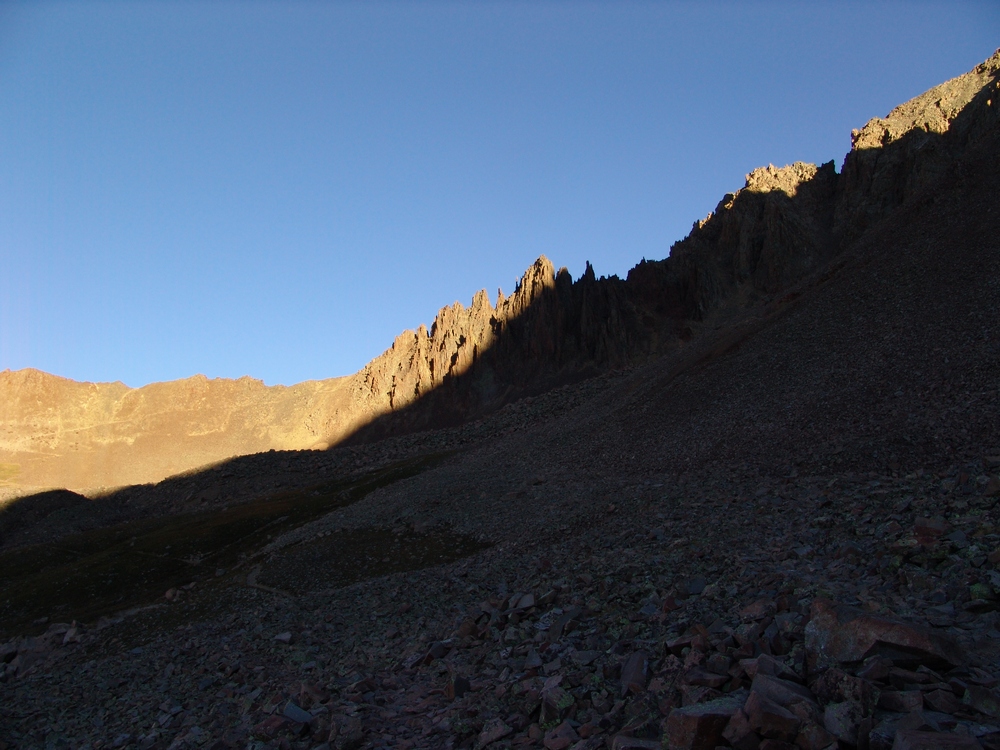
Sneffels' pinnacles.
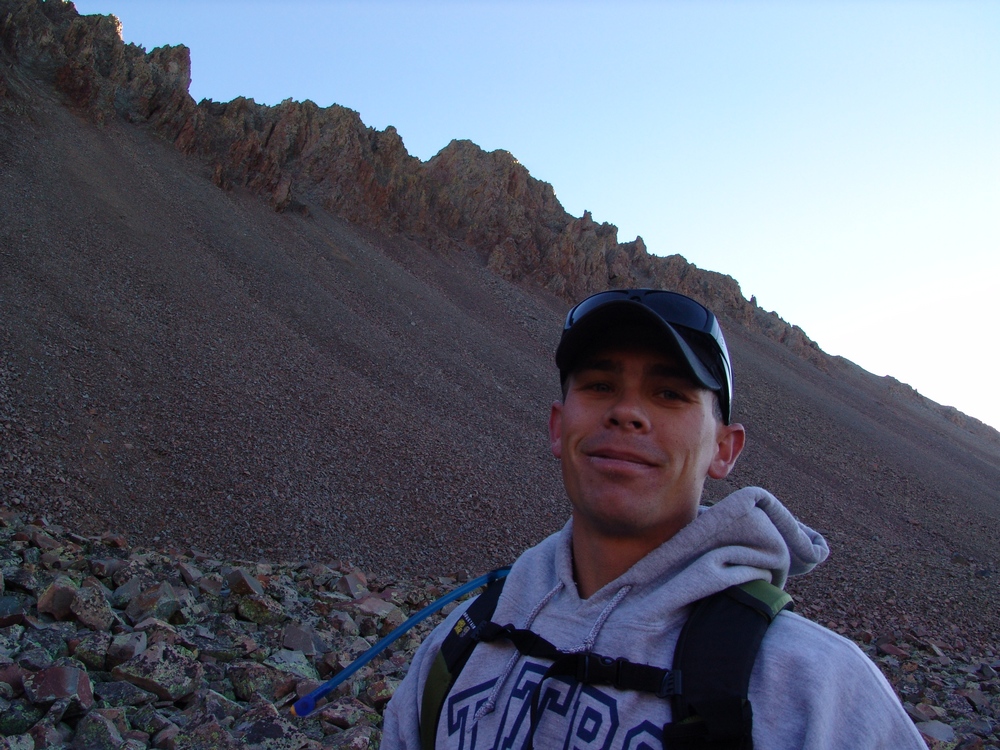
Arron Shaver - trusty hiking partner.
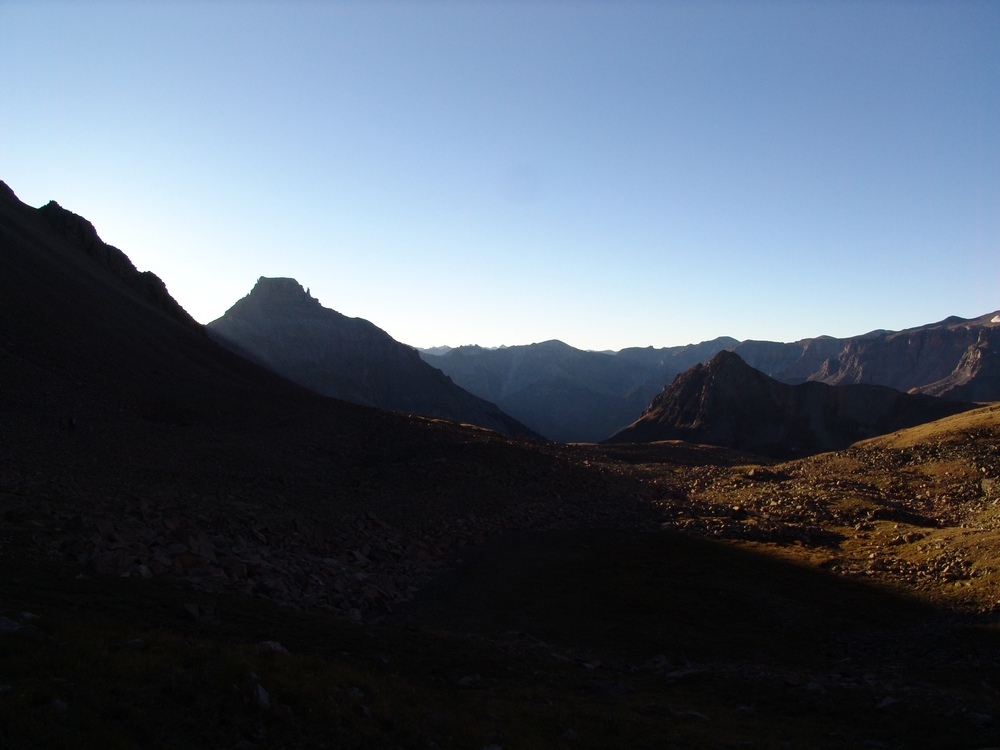
Potosi Peak.

Gilpin Peak in the early sun.
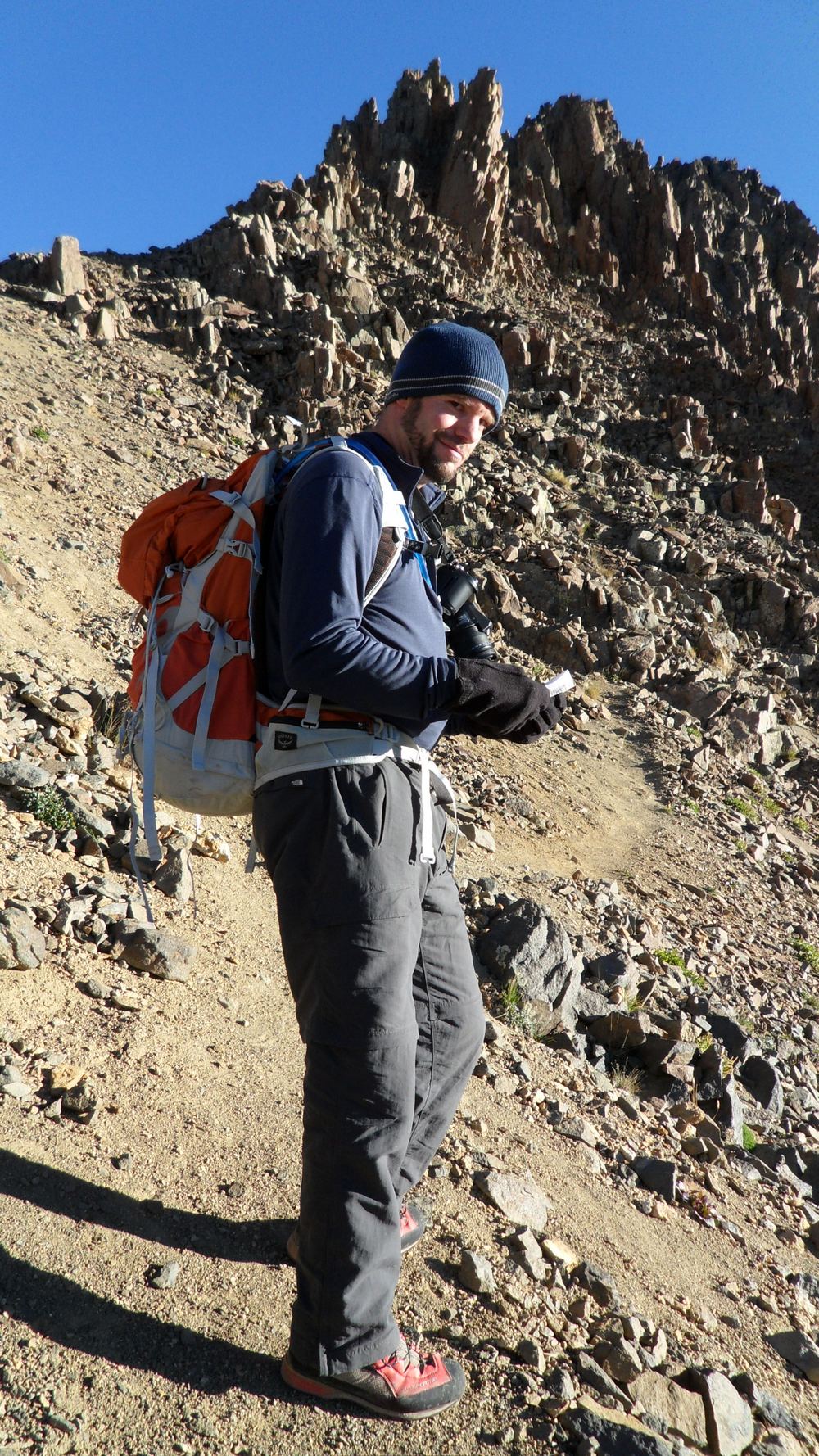
Matt Payne nearing the top of Blue Lakes Pass. The ruggedness of the pinnacles can be seen.
The hike up to Blue Lakes Pass was quick and painless, and before we knew it, we were enjoying intense views of Dallas Peak, West Dallas Peak and "T 0" after crossing into the Mount Sneffels Wilderness Area.

Blue Lakes Pass provided awesome views of Dallas Peak.
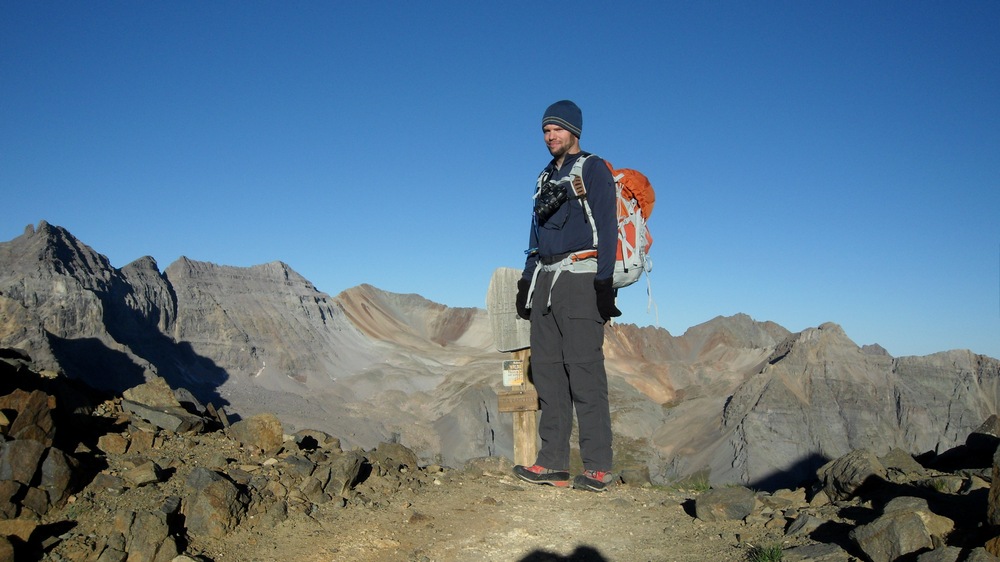
Matt Payne at the top of Blue Lakes Pass.
From the top of Blue Lakes Pass, the route heads directly behind the pinnacles and up a somewhat steep boulder field.
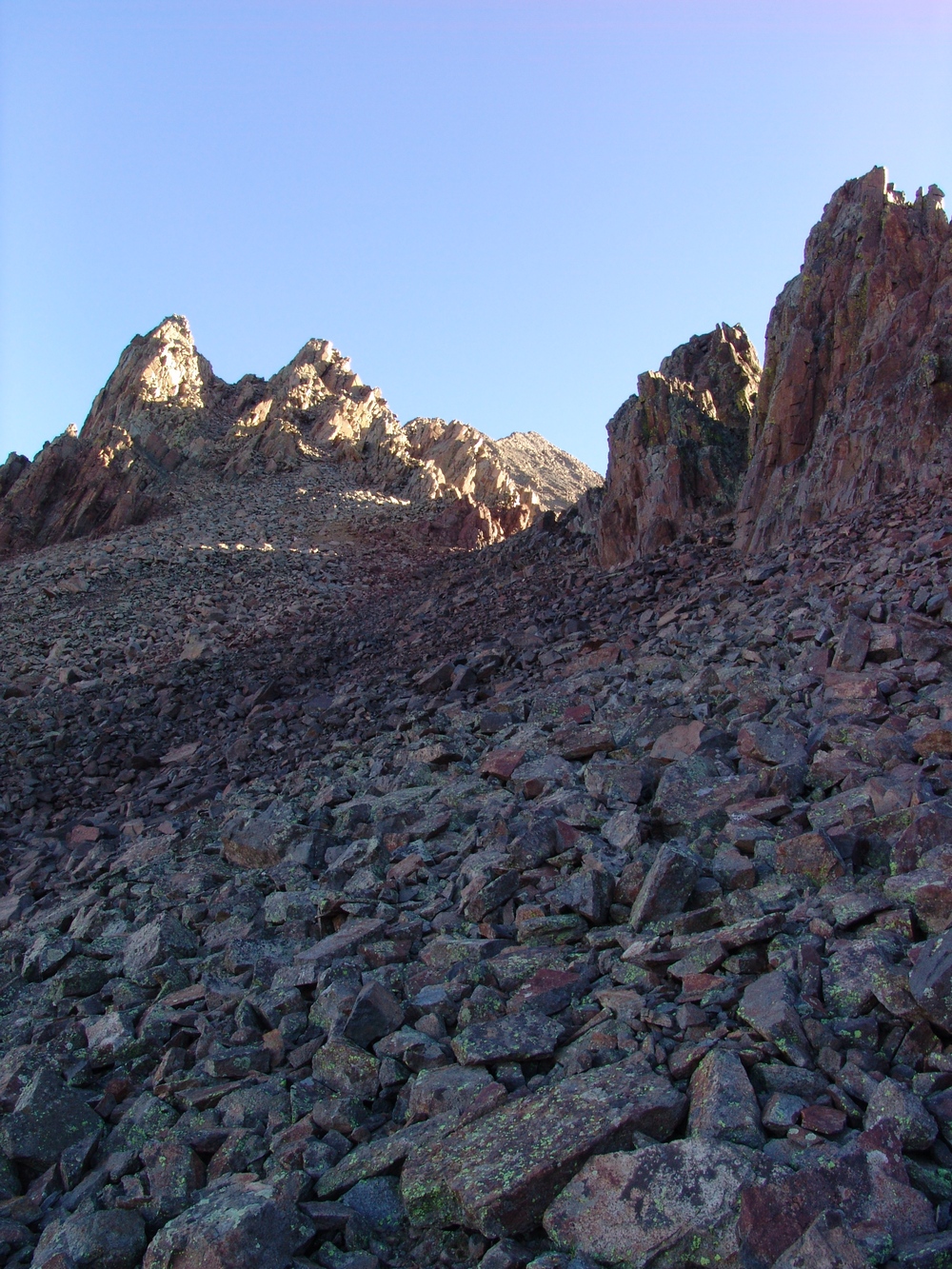
The backside of the pinnacles of Sneffels.
The trail here was fairly easy to find and the route seemed fairly self-explanatory - up! As the sun continued to rise, we could see the awesome Blue Lakes basin below Dallas Peak.
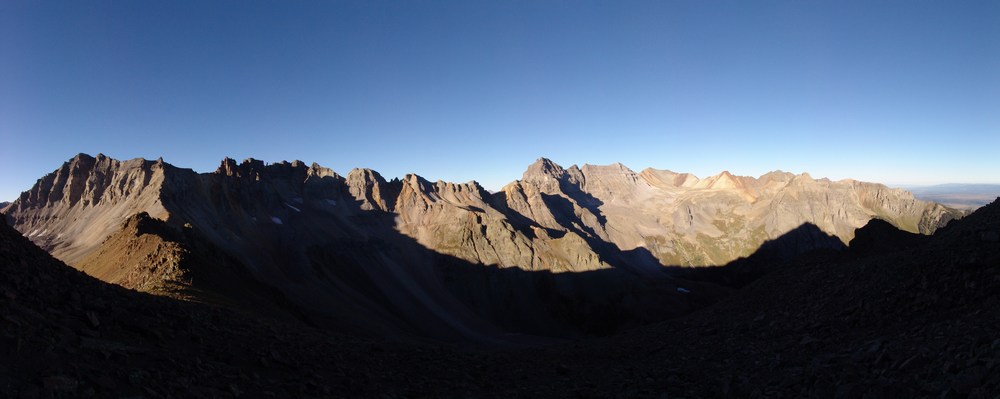
As we continued to climb up the gullies, Lizard Head finally came into view for the first time. Lizard Head is a tall spire near the Wilson group to the Southwest of Sneffels and is only climbed by experienced rock climbers, as the route up it is 5.8 on the YDS. For a great read on the Lizard Head approach and climb, see Sarah Thompson's site, 13ergirl.com.
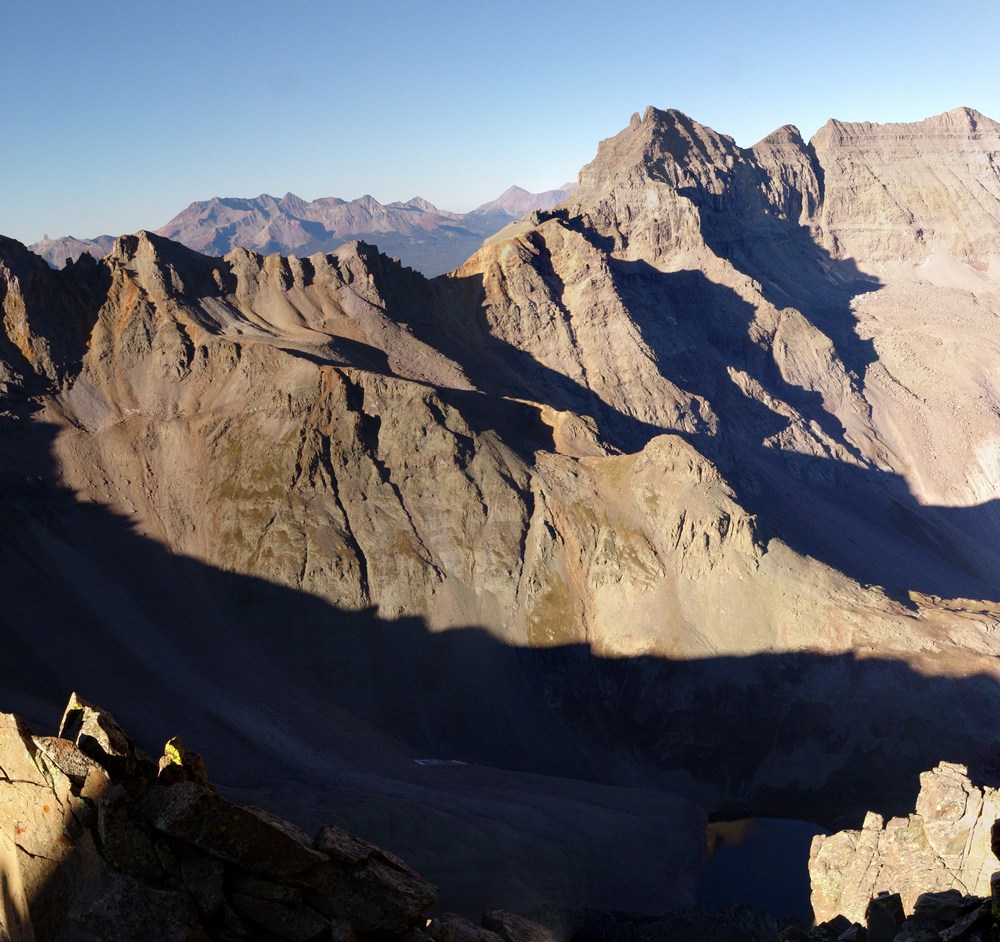
Lizard Head is barely seen at far left, with the Wilson group rising above the ridge between Dallas Peak and Gilpin Peak.
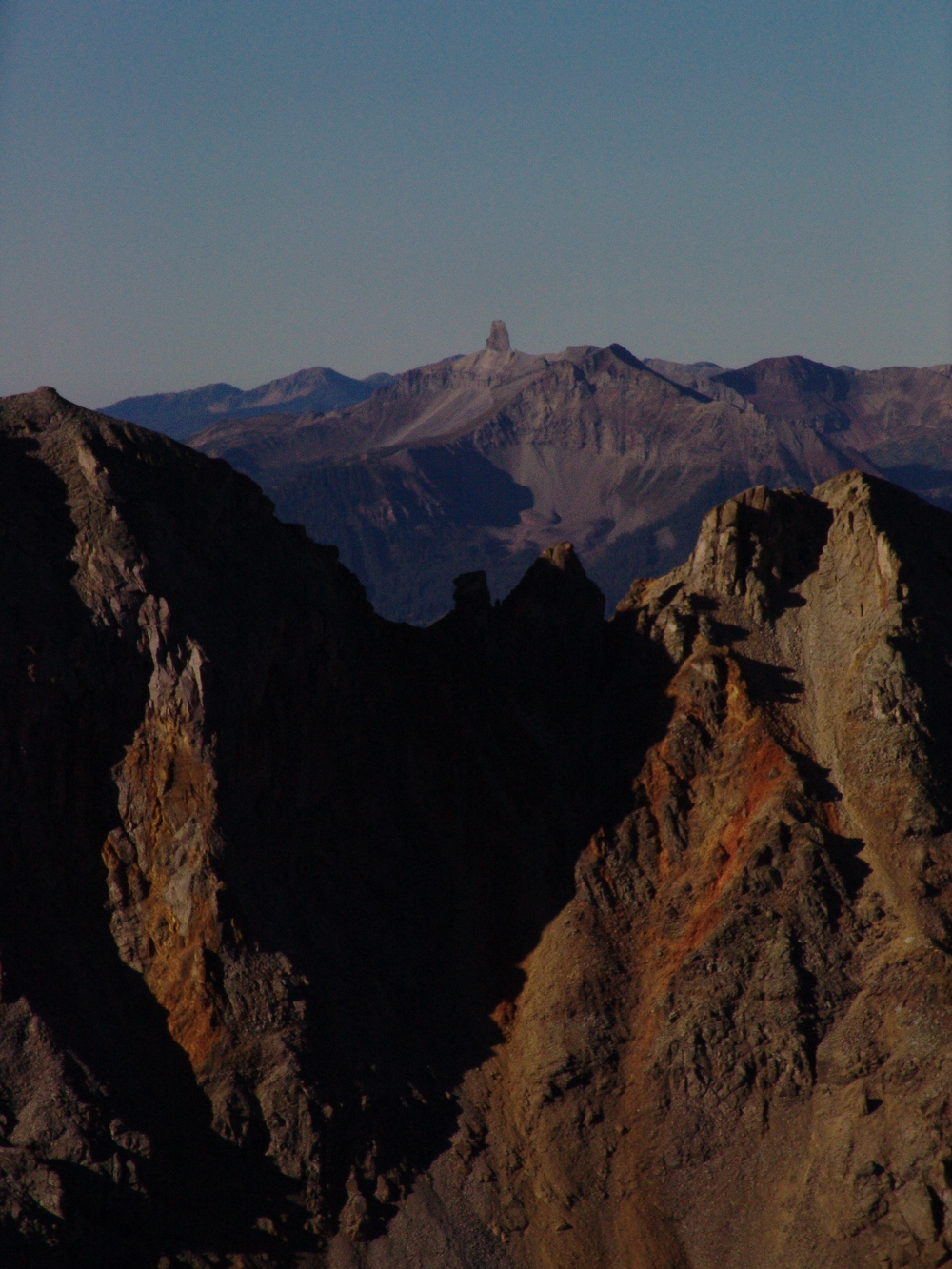
Lizard Head - zoomed-in.
As we continued to climb up the first gully on the Southwest ridge, we finally reached the top of the gully and were forced to down-climb to a ledge, which led us to the base of some class 4 sections just before the obviously last ridge section.
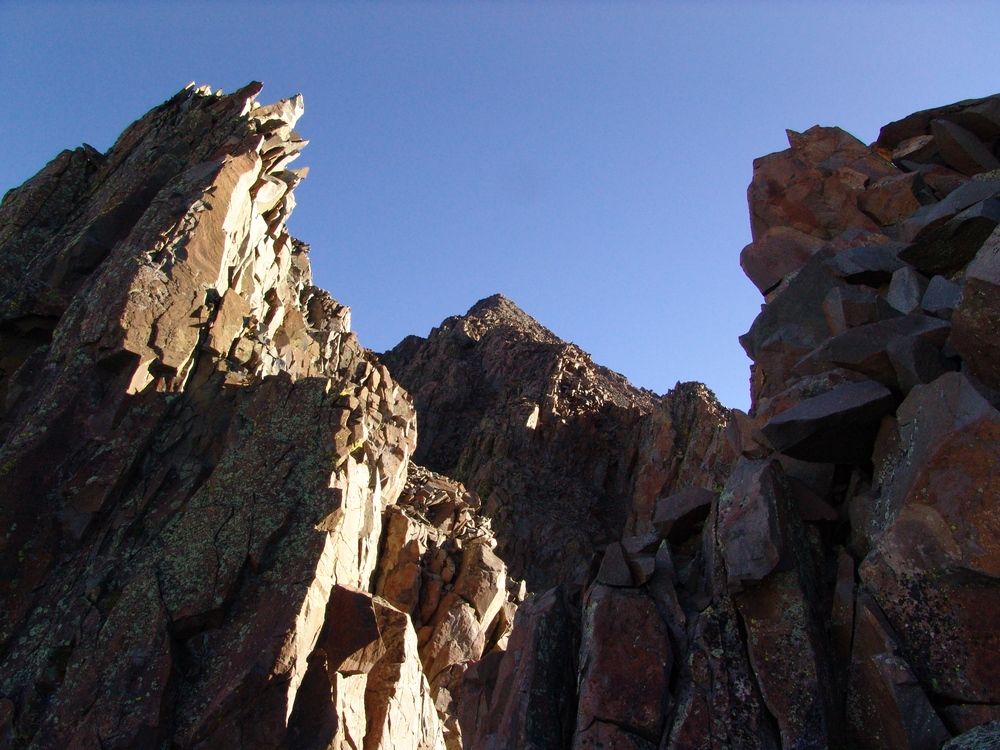
The terrain on the Southwest ridge was crumbly and jagged.
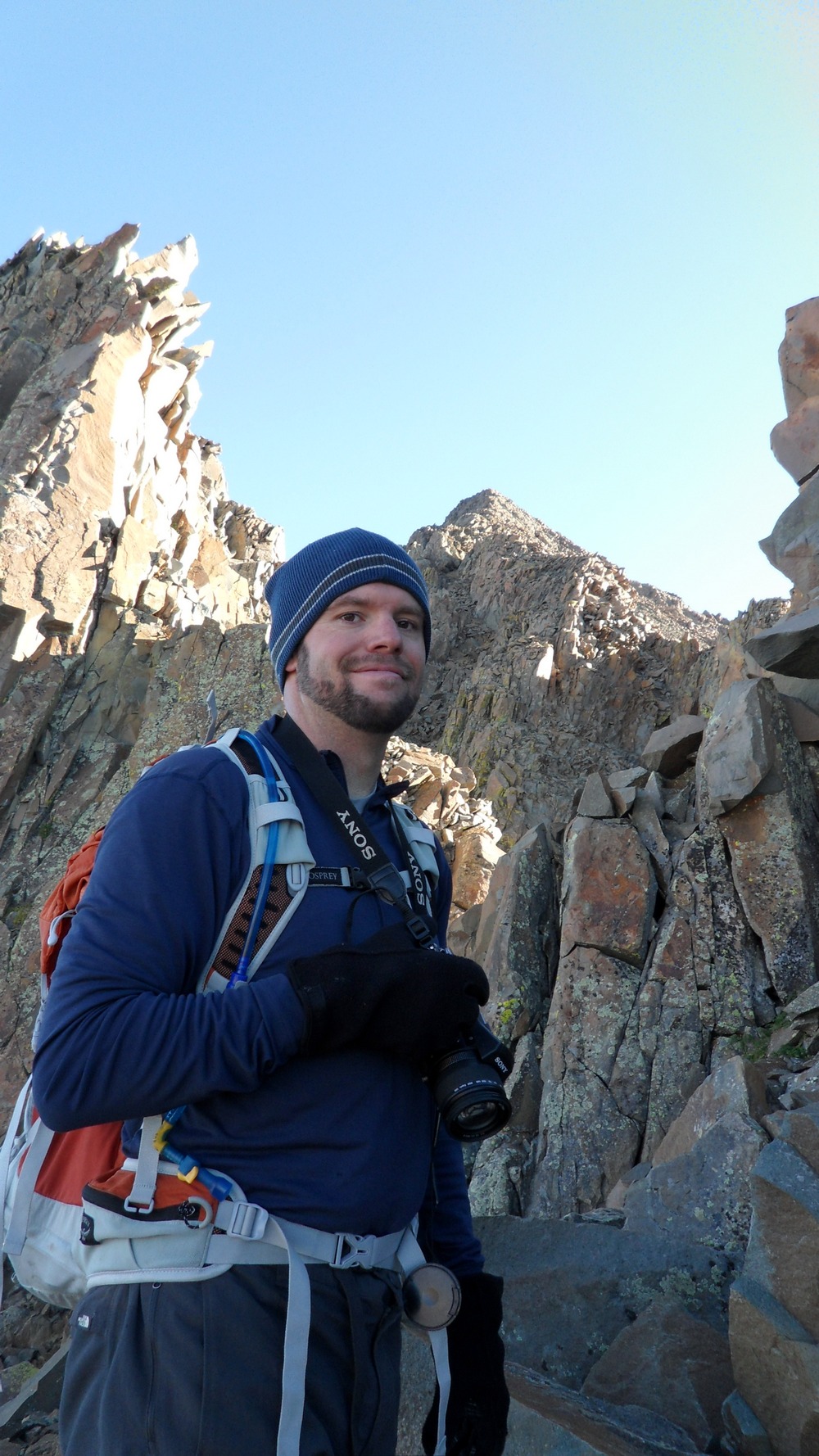
Matt Payne starting the Southwest Ridge of Sneffels.
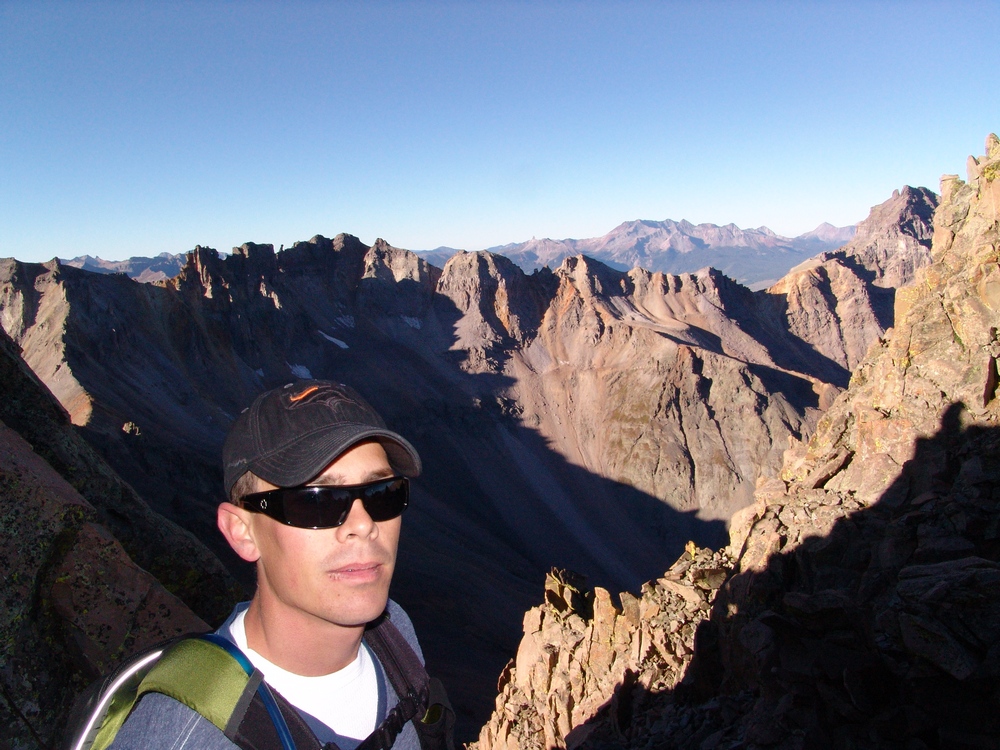
Arron Shaver on the Southwest Ridge of Sneffels.
The climbing up the ridge was quite enjoyable. The rock was quite solid, with ample hand-holds and foot-holds during the class 4 sections. Finally, Teakettle and Potosi came back into view, and they did not disappoint. Teakettle is one of the most appropriatly named mountains in Colorado. Shaped like an actual teakettle, sporting a spout and a handle - Teakettle is both a geologist's and a photographer's dream.

Teakettle Mountain is seen at far left, with it's handle represented as a large hole in the rock. Potosi Peak seen at far right.
I remember being very impressed by Teakettle, even as a child. My dad climbed Teakettle in the 1980's and this photo was taken of him inside the handle of the teakettle:
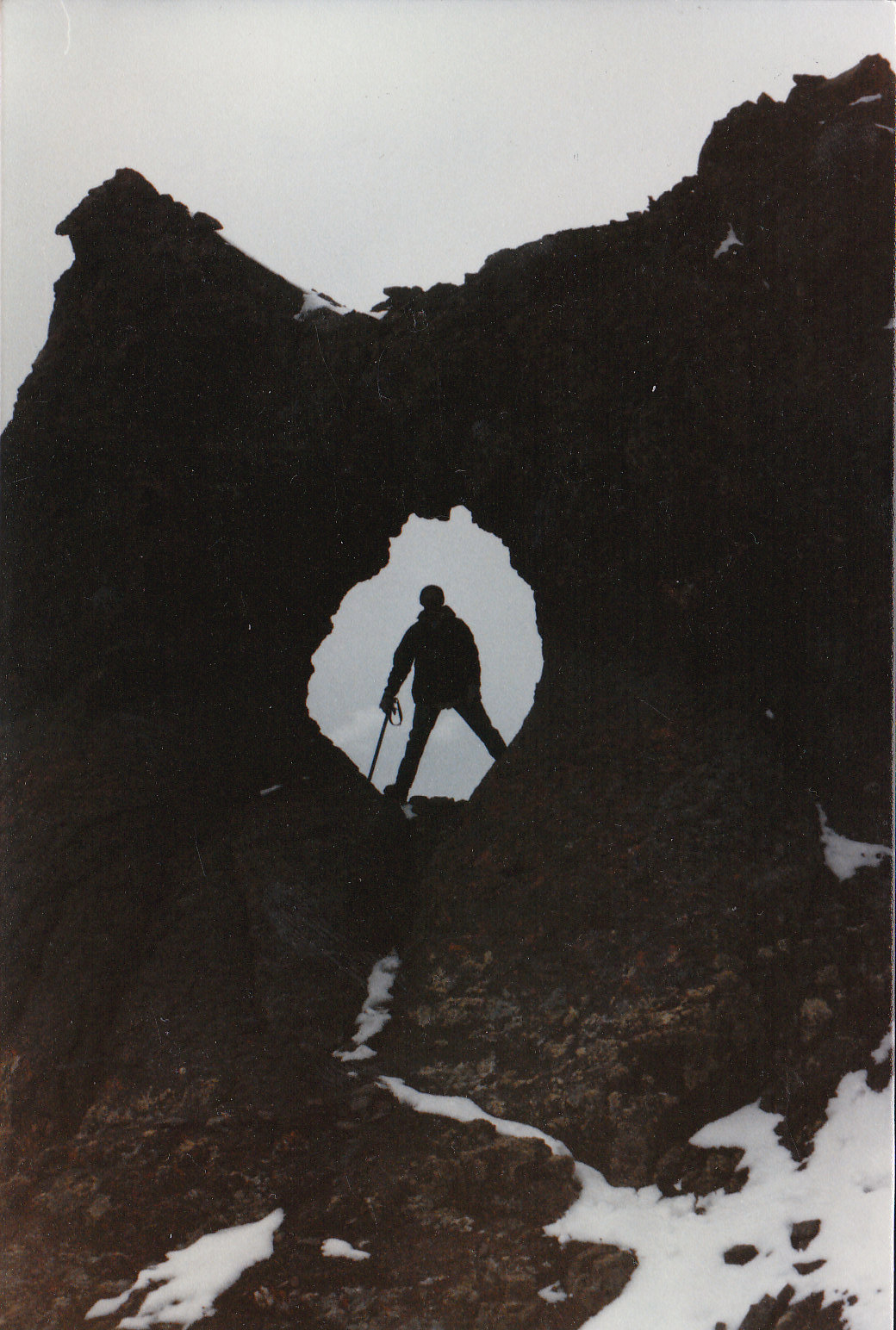
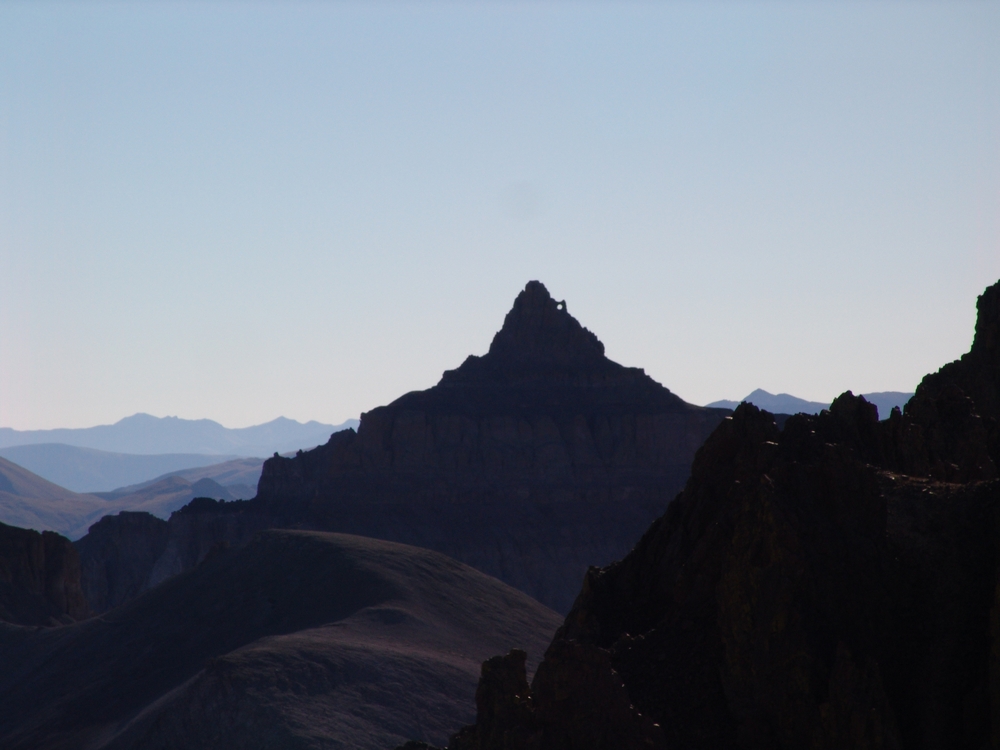
Teakettle Mountain, zoomed-in.
At this point, our views of Yankee Boy Basin below was quite impressive as well, with the golds, browns, yellows and greens of fall accentuating the pristine basin.
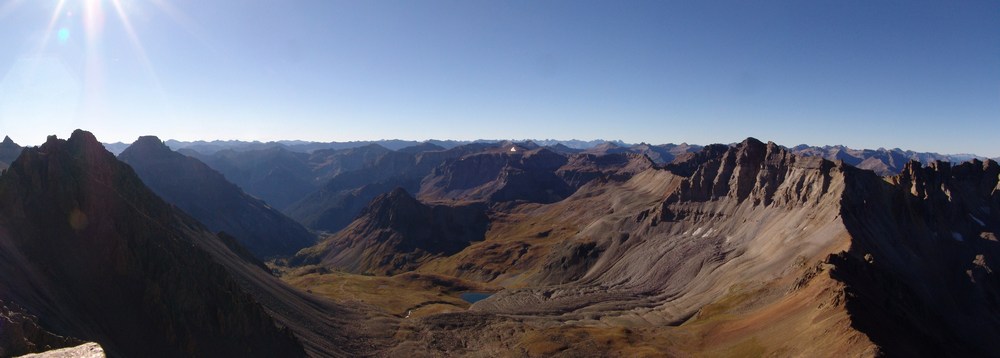
Yankee Boy Basin.
Looking in any direction, we could see some amazing peaks. Teakettle, Potosi, Gilpin, and Dallas made for quite the fall back-drop.

On the way up the ridge, we were able to find the Kissing Camels rock outcropping that is often described on route descriptions for Sneffels. The landmark is almost impossible to miss.
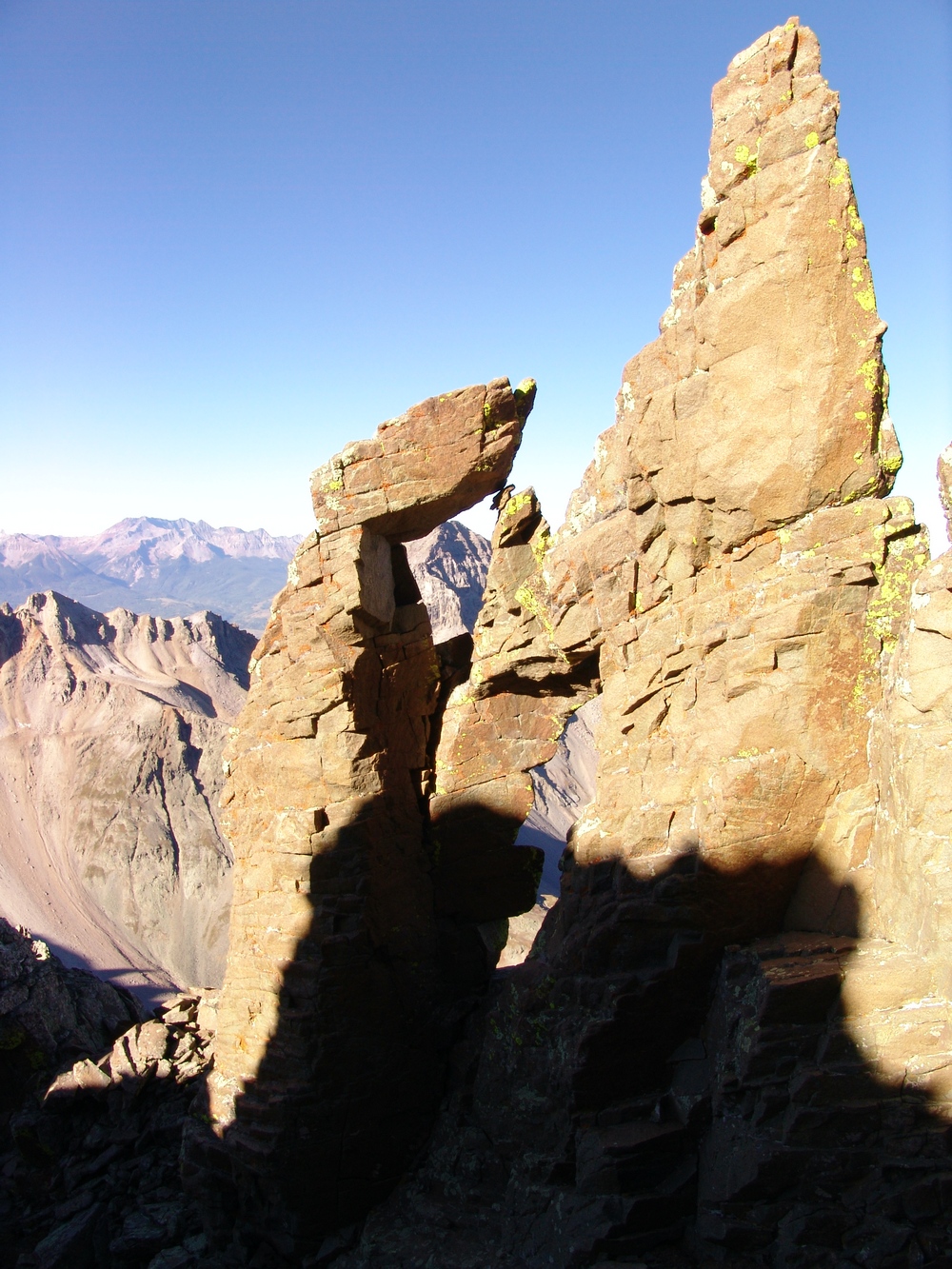
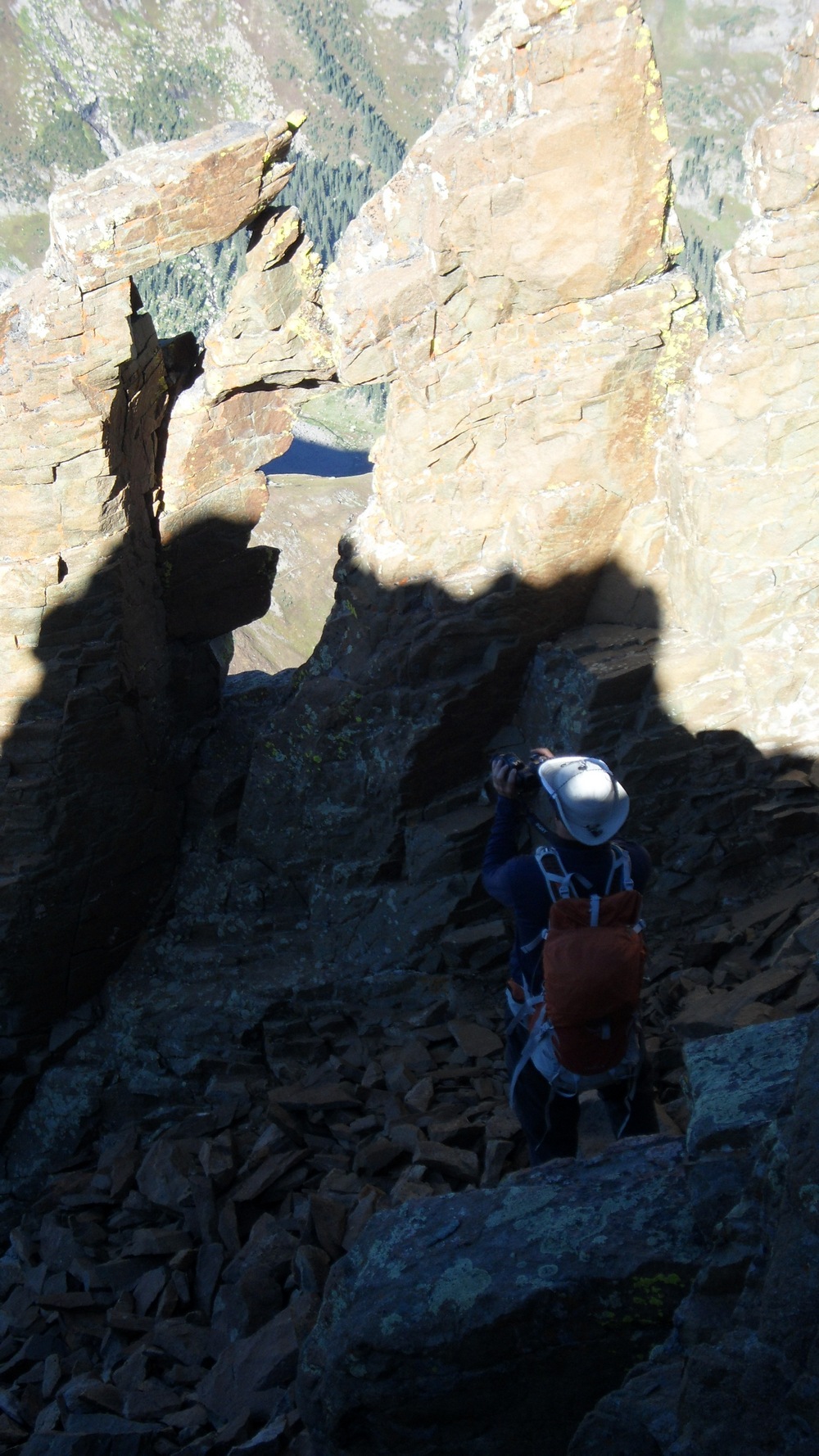
Dallas Peak can be seen through the Kissing Camels rock outcropping. Arron caught me in the act of taking that photo...
Yankee Boy Basin far below.
The climb from the Kissing Camels was very straight-forward - we continued up the steep ridge, appreciating the added difficulty and greater views of the Southwest Ridge route over the standard route.
Teakettle Mountain was difficult to keep from staring at. It truly is one of the more remarkable mountains I've seen. So remarkable, that I had to get a super-zoomed in view of it!
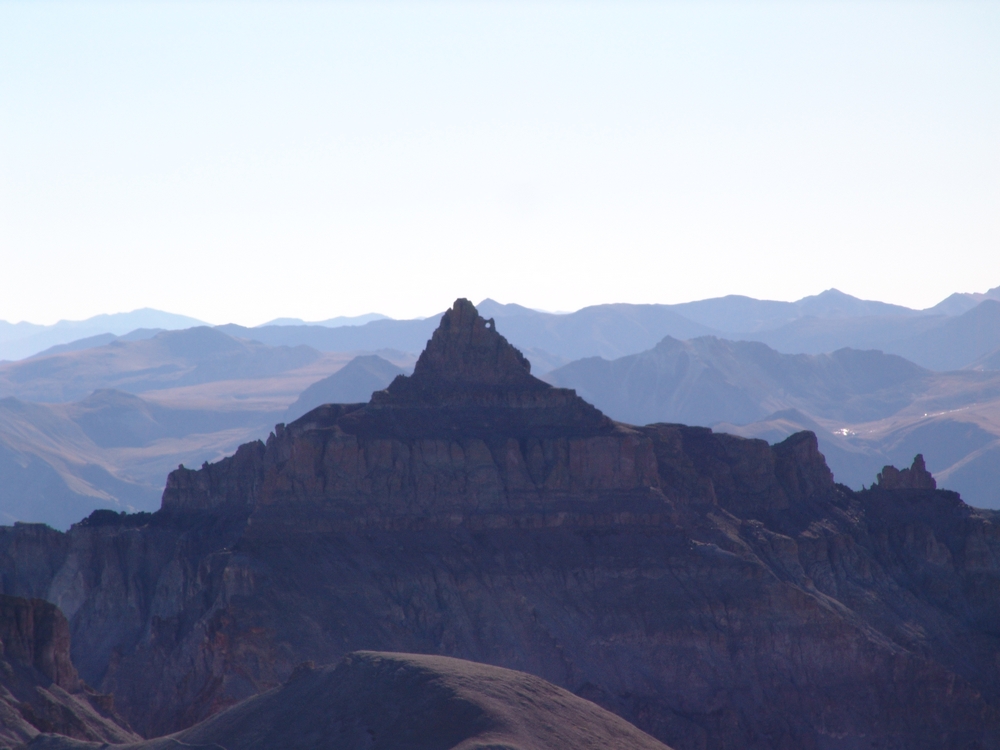
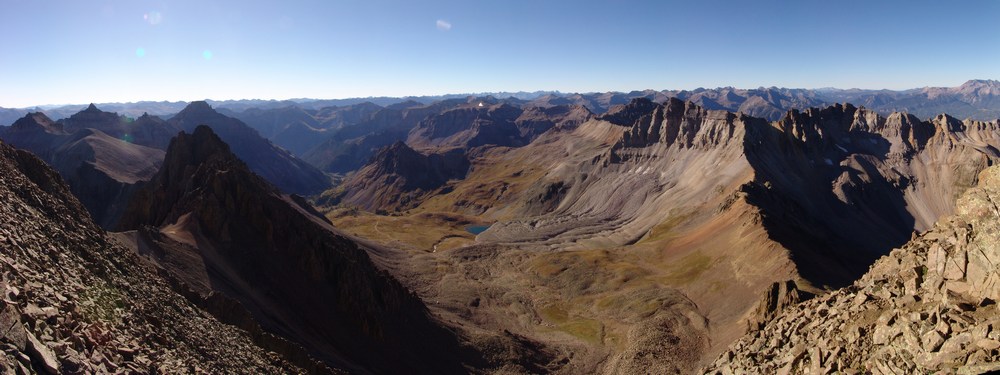
Arron was also excited about the route - being that Sneffels was his first 14er of his life - I think I may have spoiled him with one of the more fun routes of any 14er.
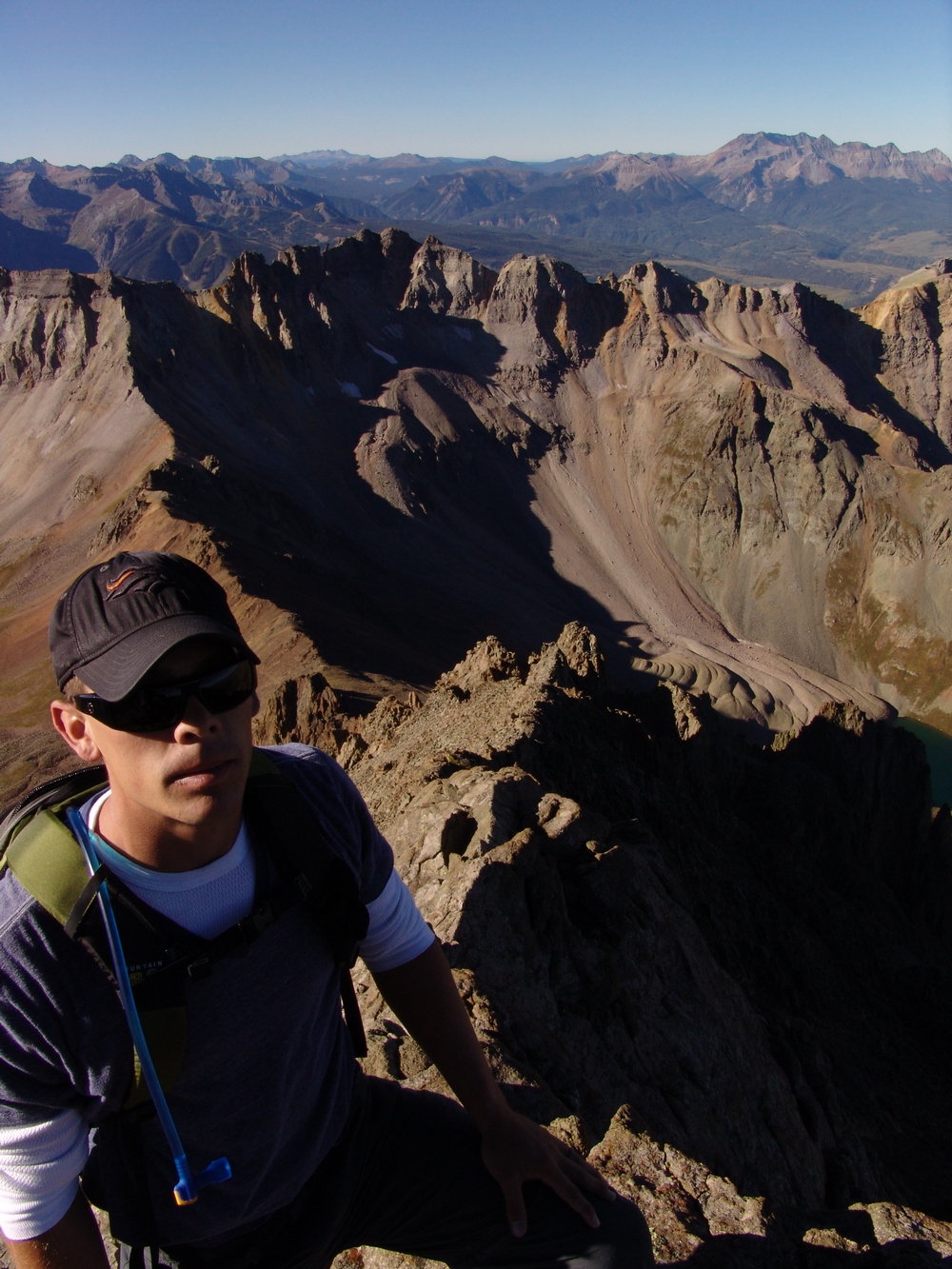
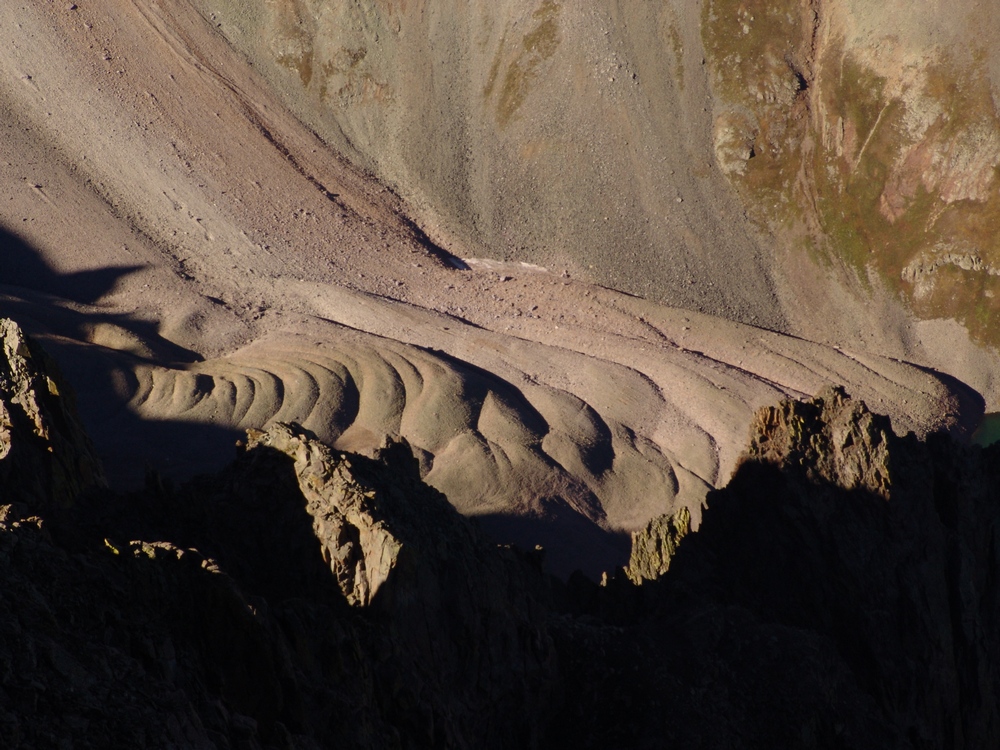
Arron with the ridge behind him. "Cake Batter" spills down the ridge between Dallas and Gilpin. (Zoomed in at right)
I suspect that the "cake batter" looking stuff is probably caused by mud slides during the monsoon seasons that often plague the San Juan Mountains.
We finally reached the summit just as the other group was reaching the top as well. The weather was perfect. No clouds. No wind. Warm. We could not have picked a better day to climb.
As usual, I took several photos from the summit and celebrated with the other climbers.

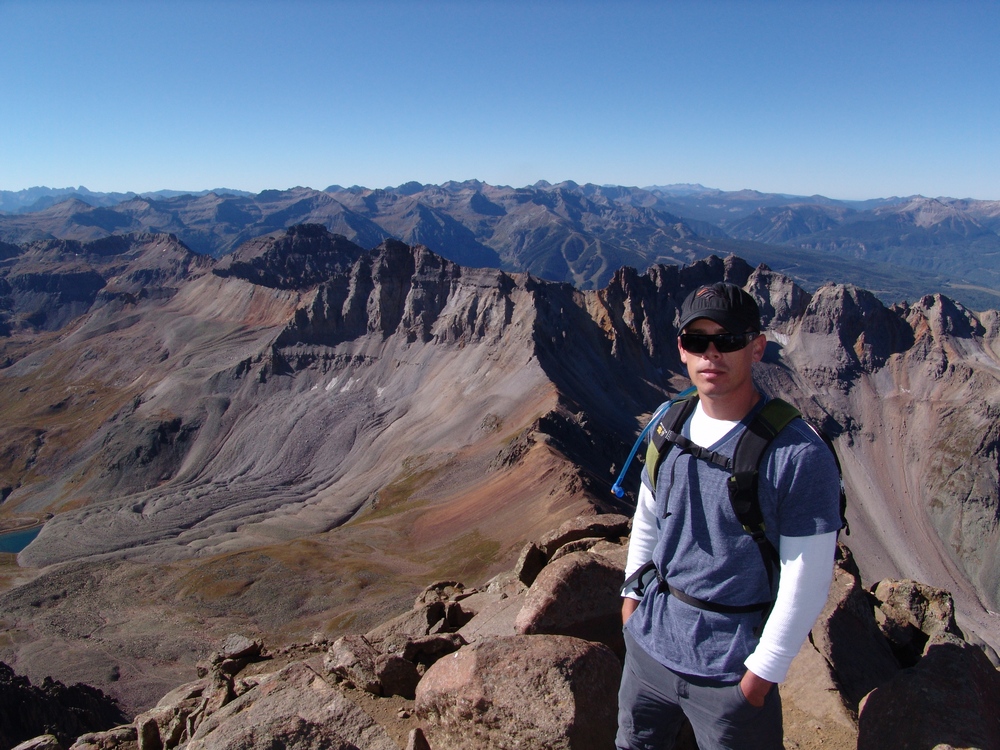
Arron's summit shot.
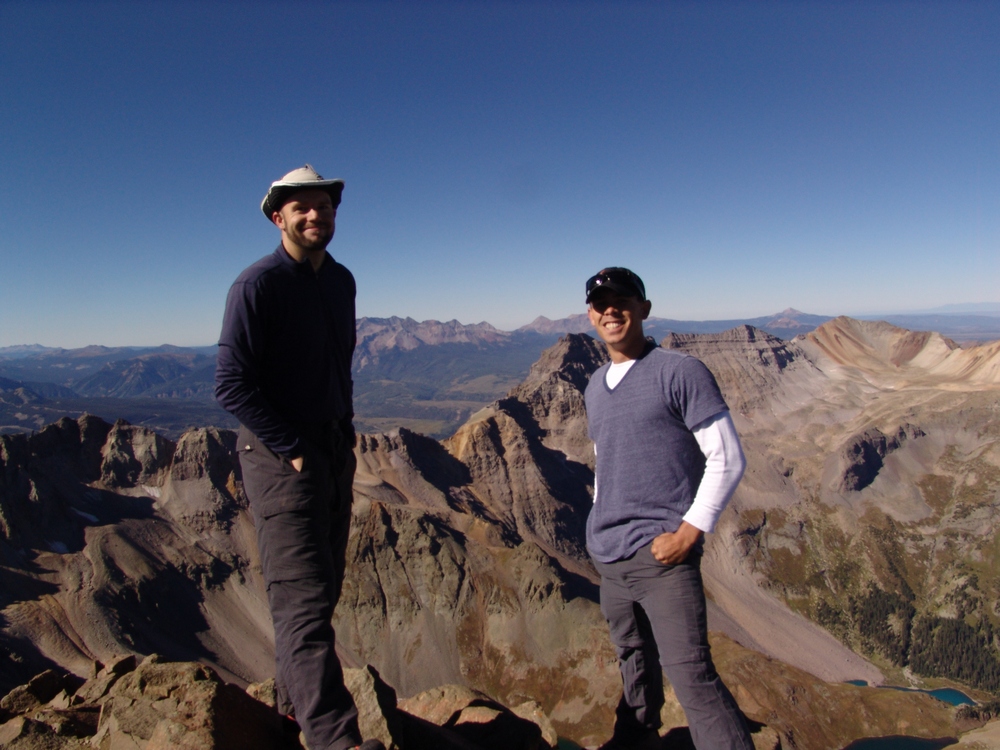
Matt and Arron on the summit of Mount Sneffels.
Views of the Grenadier Range (Vestal, Arrow, etc), and the Needle Range (Eolus, Windom, Sunlight, Pigeon, etc) were great as well as views of Uncompahgre and Wetterhorn. What I was most impressed by was the views of the Grand Mesa and the land between Sneffels and the mesa. The town of Ridgway, Ridgway State Park, and Ridgway Reservoir could all be seen easily as well. What was also impressive were the views of the Telluride Ski Area, the Wilson group (Mount Wilson, Wilson Peak, El Diente, and Gladstone Peak), and the La Plata Mountains.
Mount Sneffels East to West Summit Pano.

Gilpin Peak and Telluride Ski Resort. The Grenadier and Needle ranges seen in the far distance to the left.
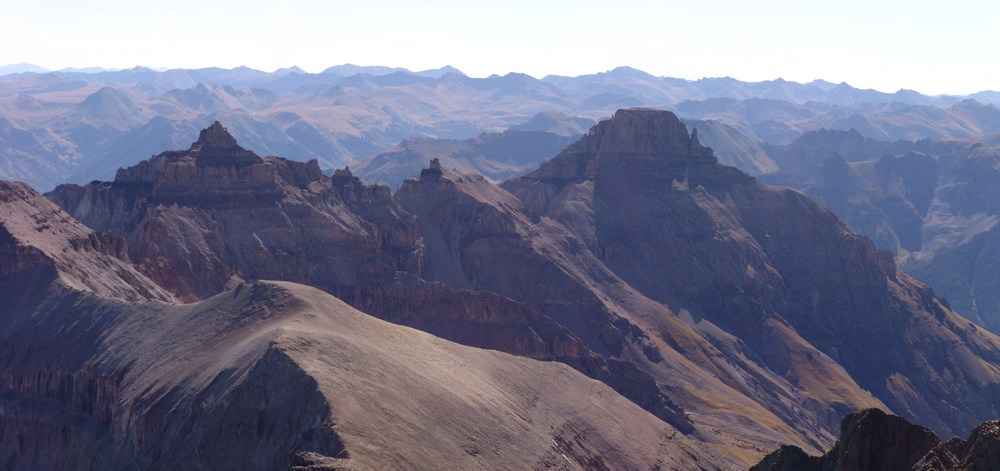
Teakettle Mountain and Potosi Peak zoomed in.

Teakettle, Potosi, Yankee Boy Basin, Gilpin, and Telluride.


360 Degree Summit Pano from Sneffels.
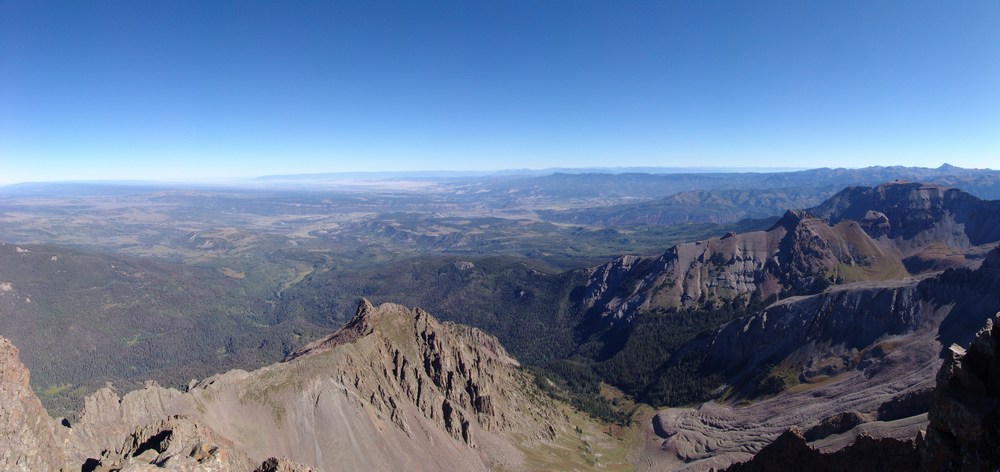
Sneffels summit pano - north and east
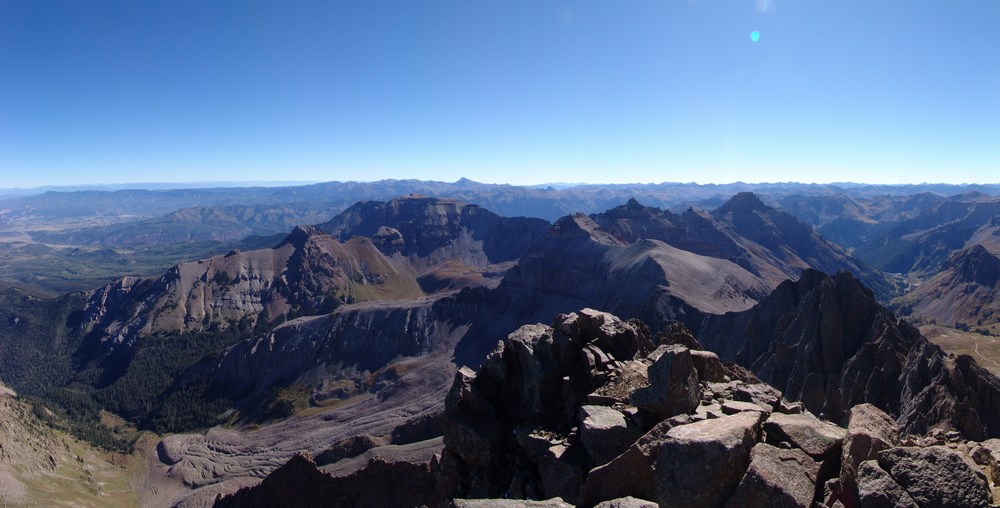
Uncompahgre seen in the distance...

Sneffels Summit - looking south
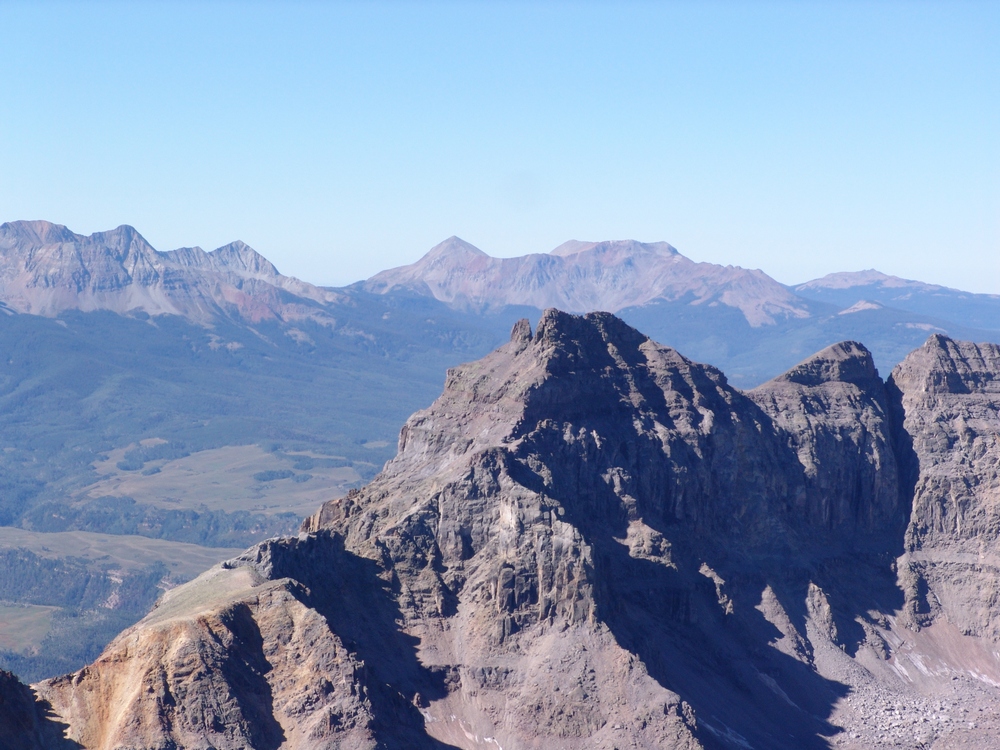
Dallas Peak, Zoomed-in.
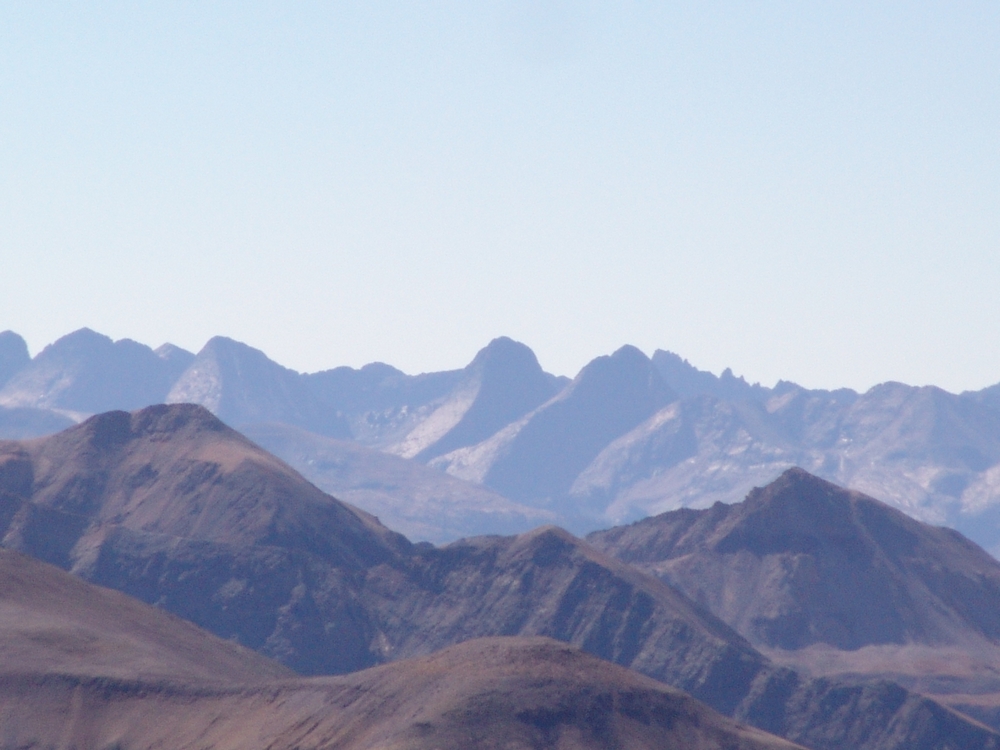
The Grenadier Range - Zoomed-in - including Vestal Peak and Arrow Peak. See that trip report here.
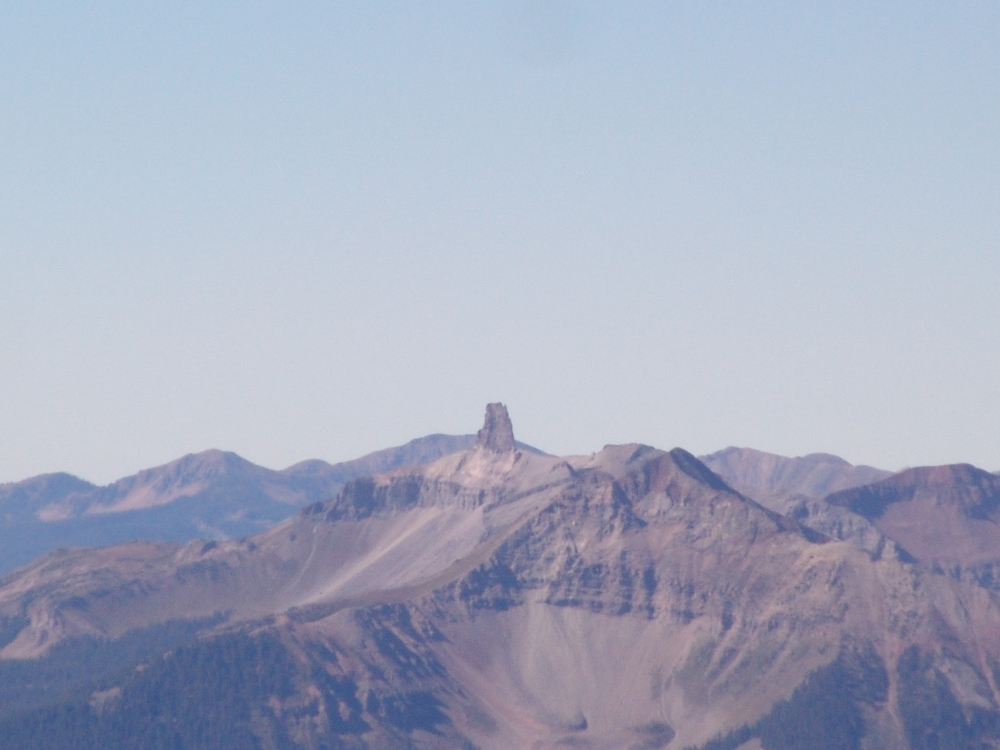
Lizard Head Zoomed-In
And of course, a summit photo is no fun unless I'm posing in a silly way...
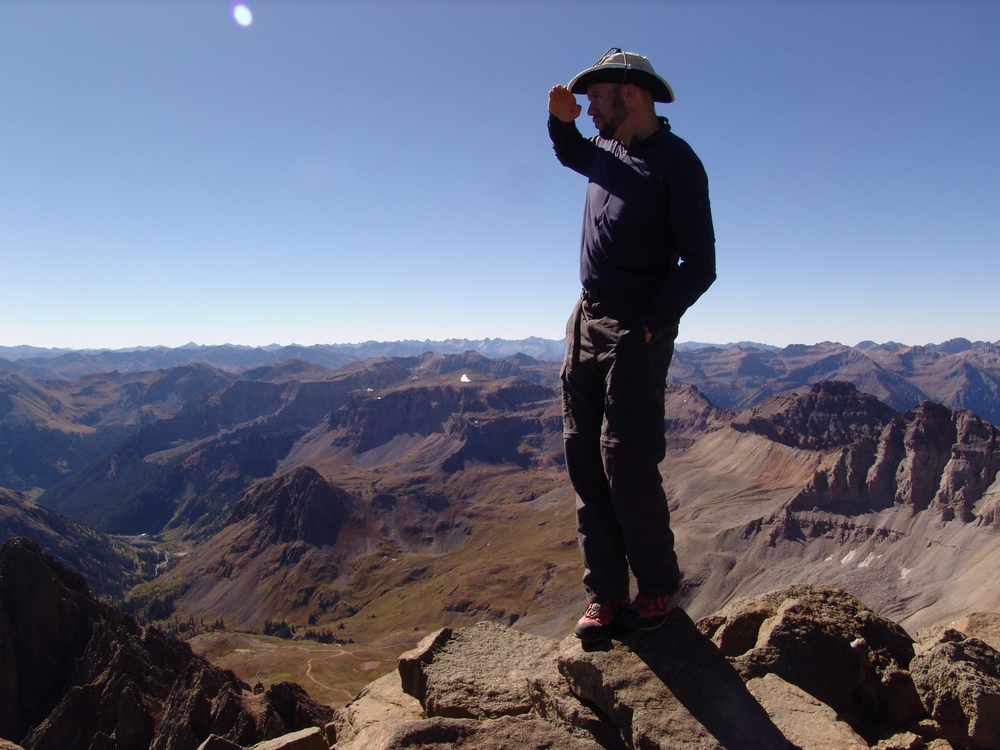
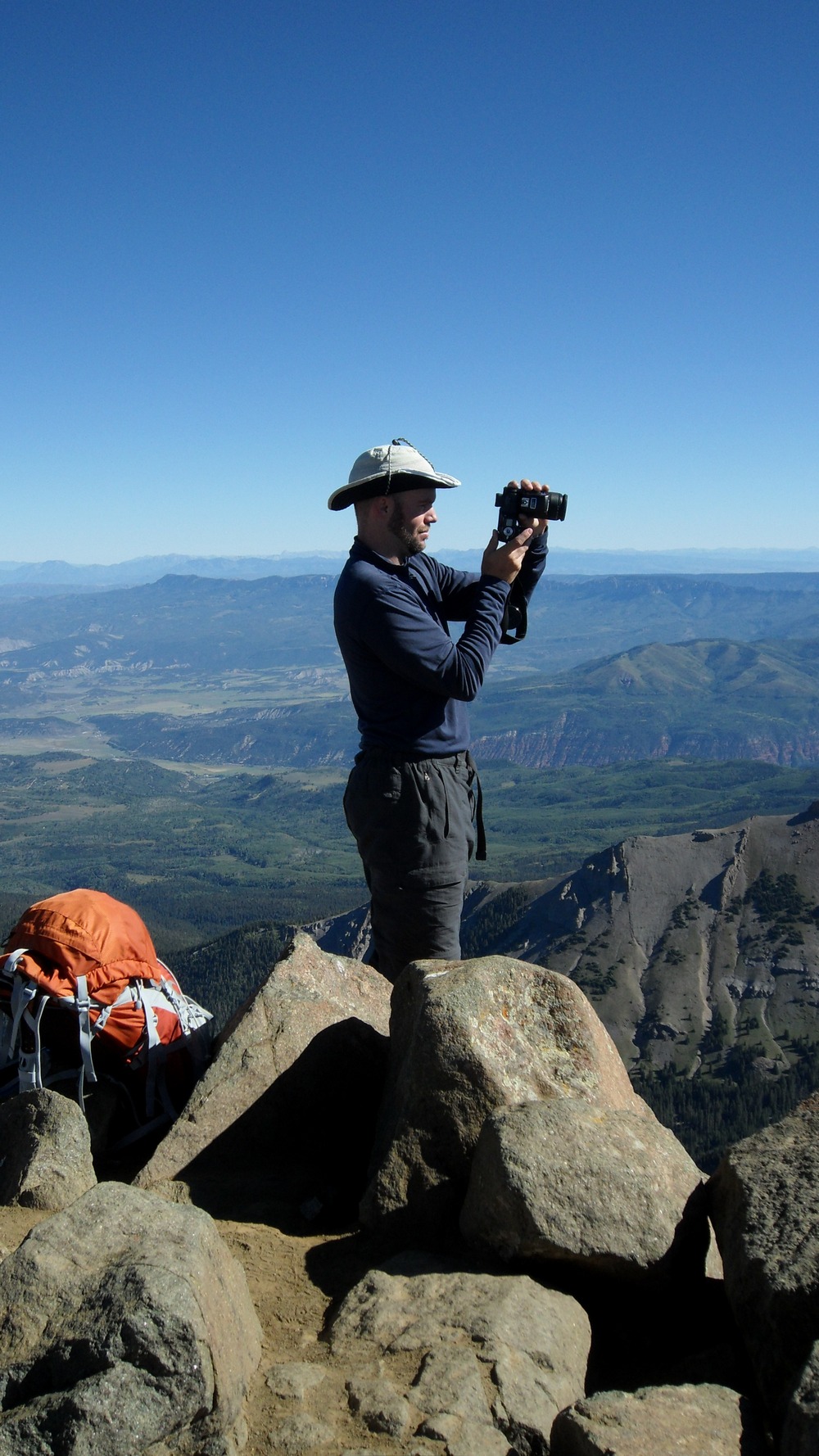
Matt Payne taking photos on the summit of Sneffels.
After quite some time on the top, Arron and I decided to descent the same way we ascended. The down-climb was challenging but solid. There were some tricky sections that required some in-facing down-climbing, and a few spots where we needed to wait for each other to ensure neither of us were hurt by rock-fall from above.
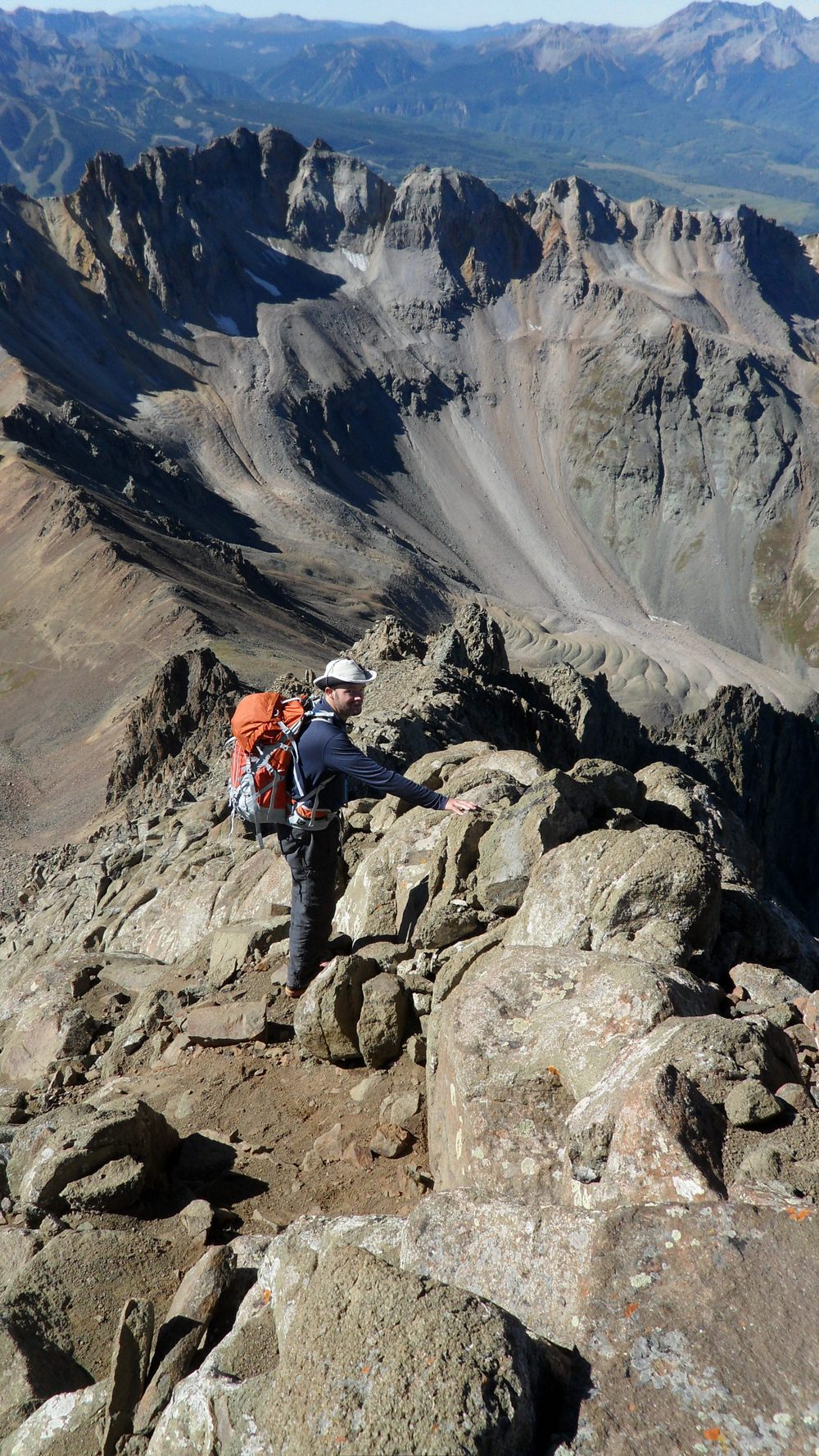
Down the Southwest Ridge!
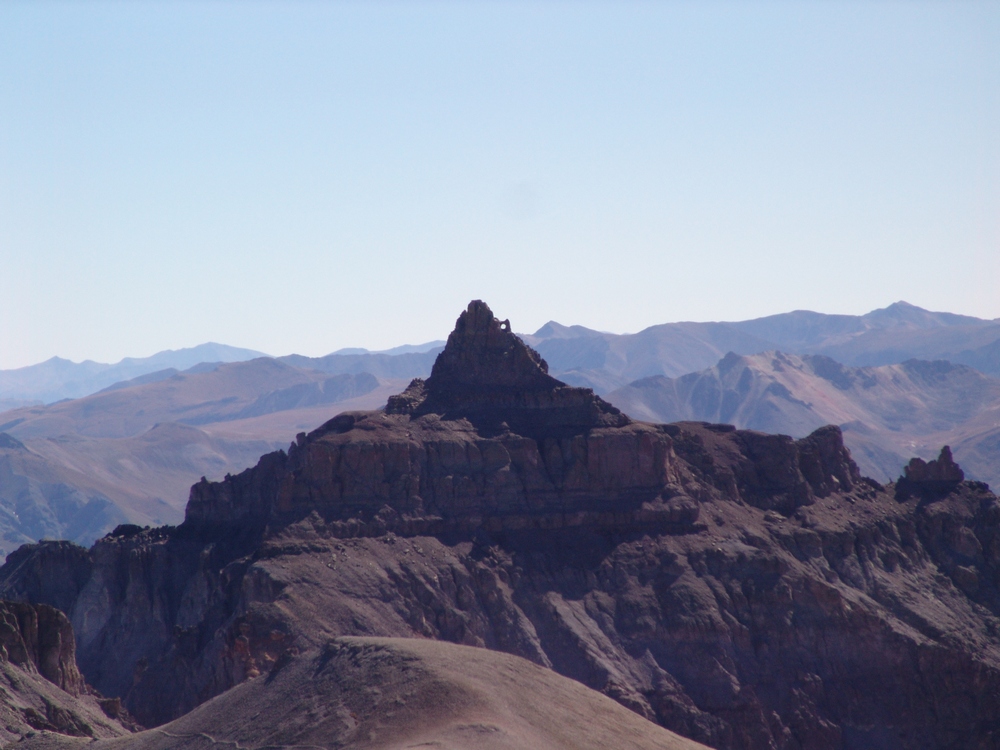
Teakettle Mountain
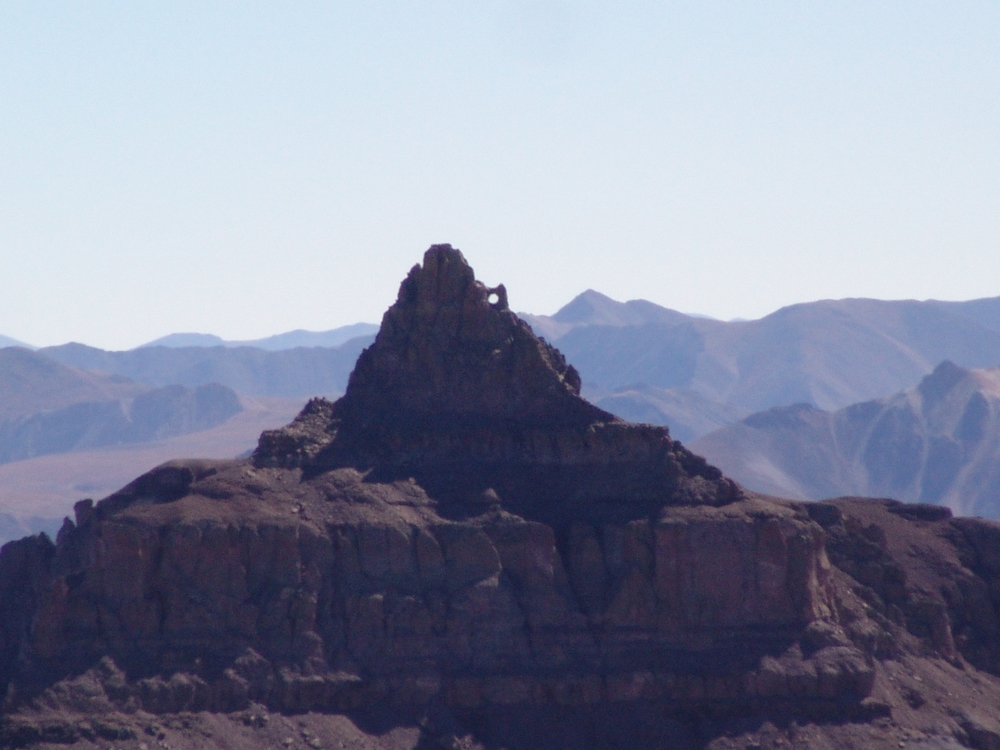
Teakettle with digital zoom.
We reached the camels again in no time and I took one last shot of the Wilson group.
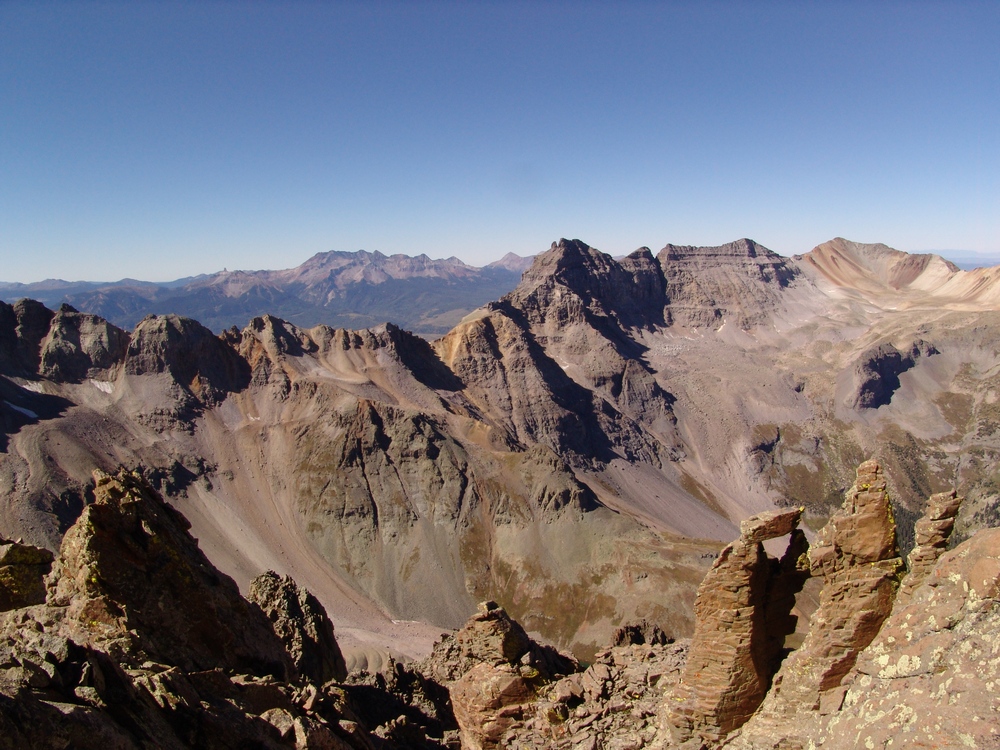
The trickiest part was when we came across some class 4 rock that we had to negotiate. It was a fun challenge for sure.
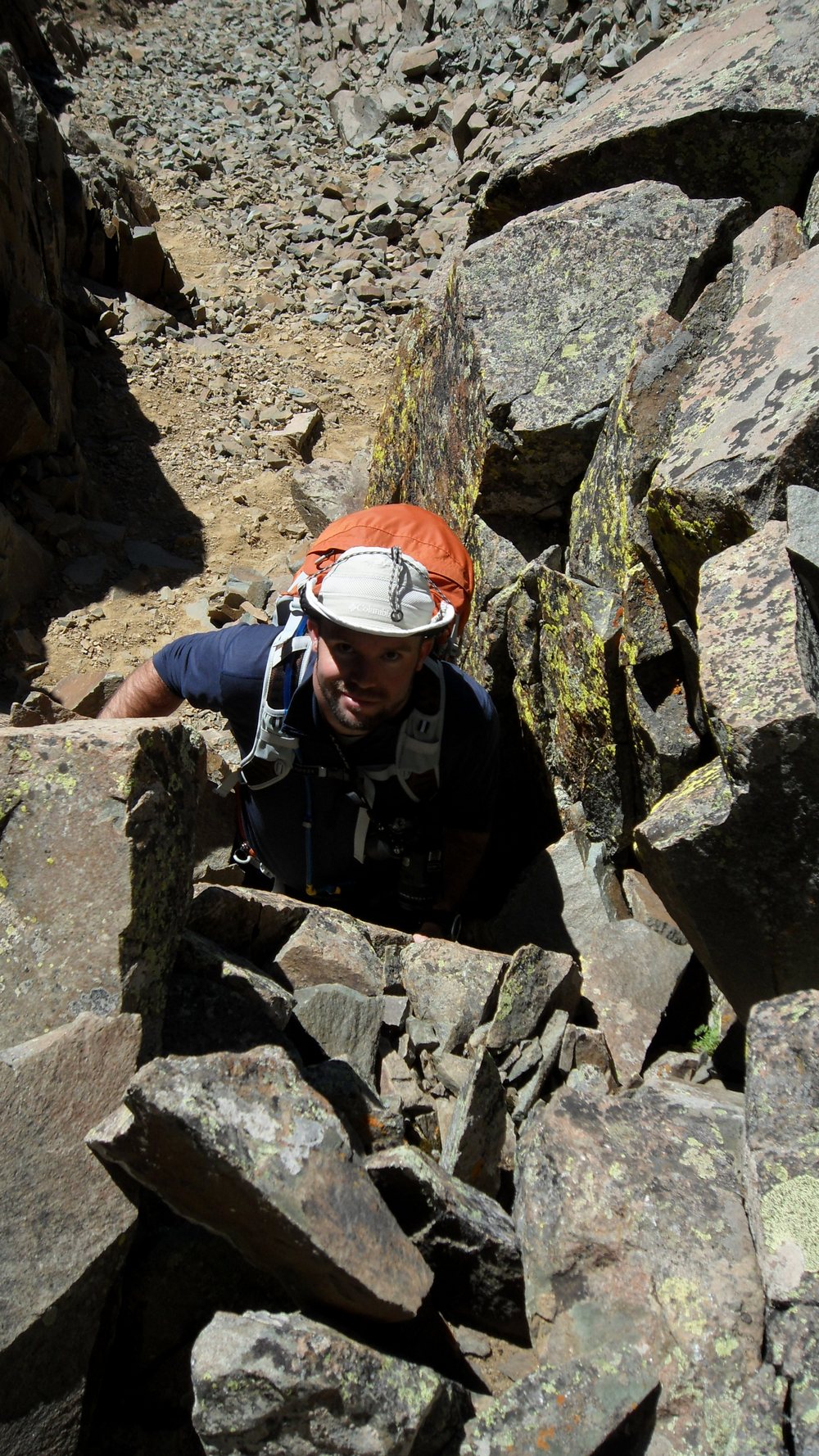
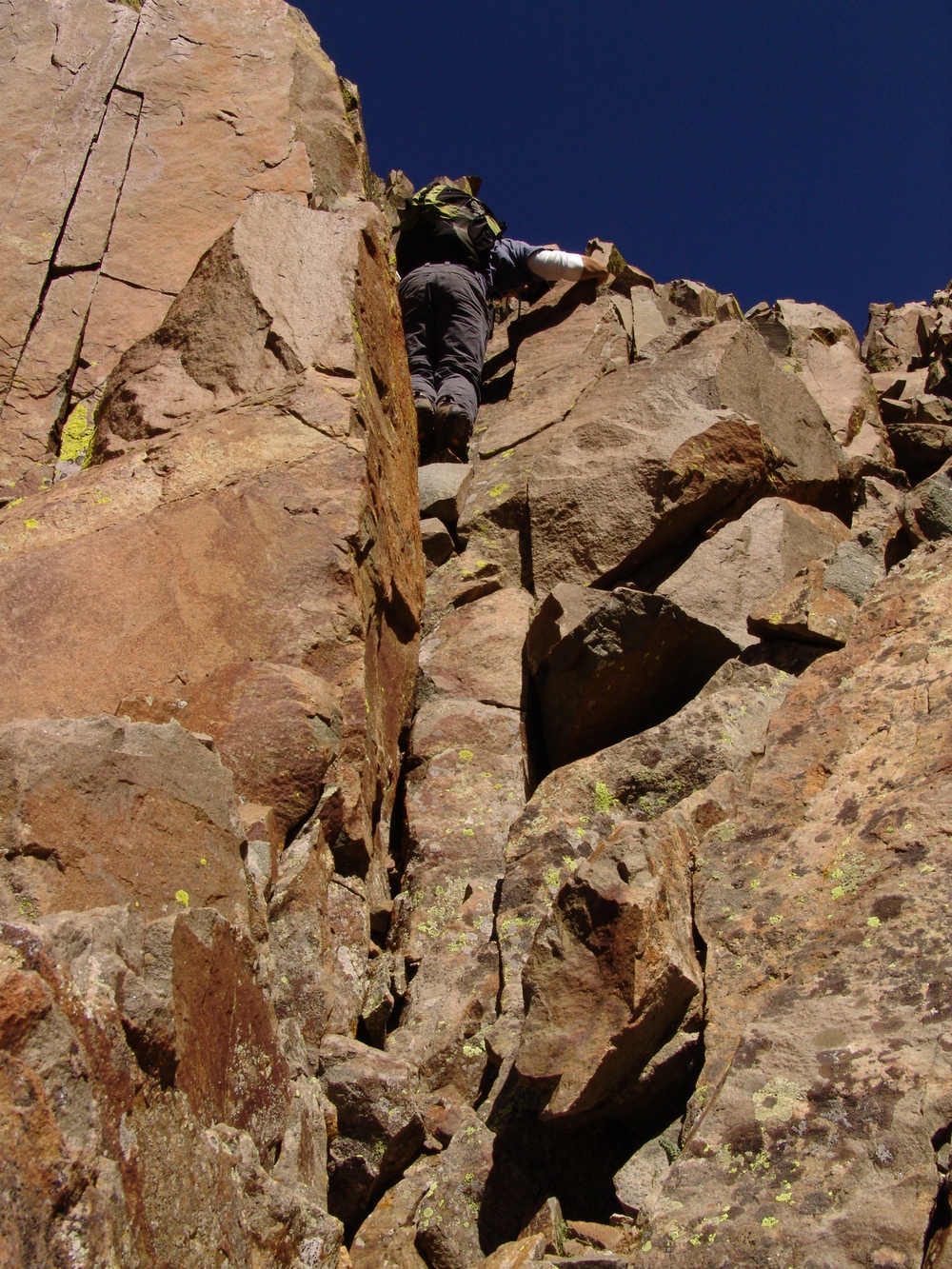
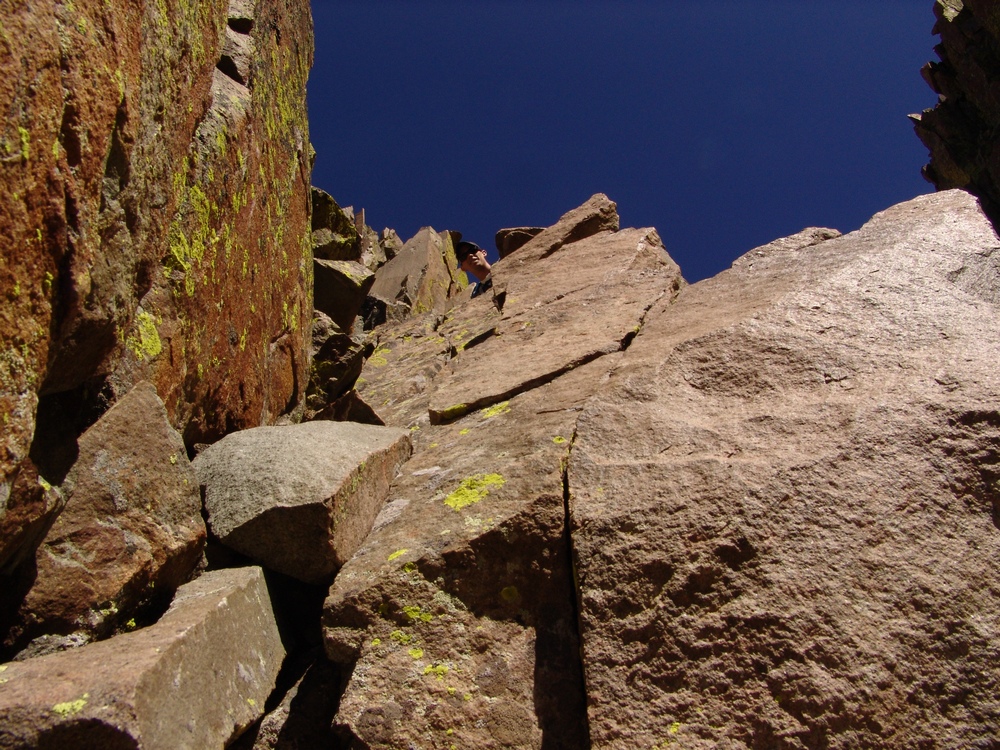
The class 4 section provided some entertainment.
We headed back down to the Blue Lakes Pass ridge without any problems.
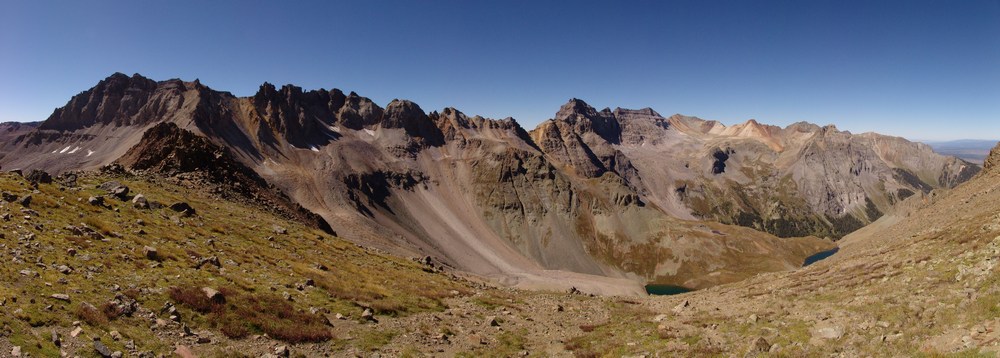
Blue Lakes Pass. I wonder why it is called Blue Lakes Pass?
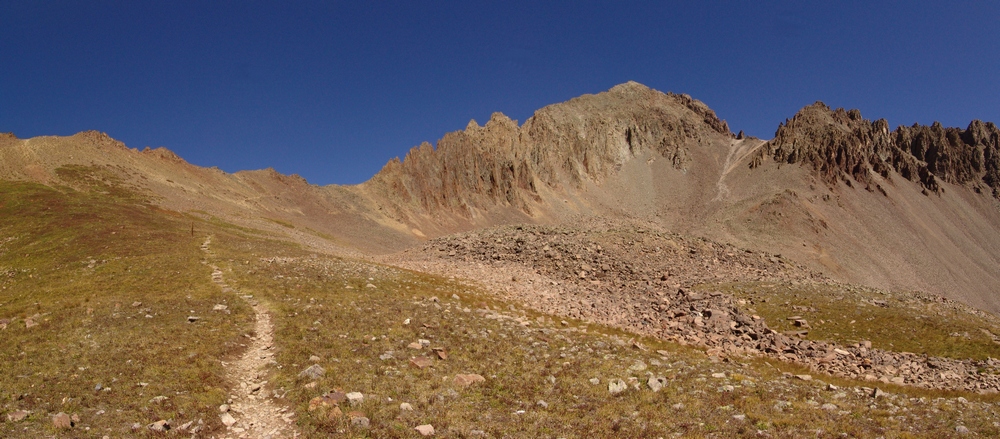
The Blue Lakes Pass trail and Mount Sneffels.
We hiked down the Pass back towards Yankee Boy Basin and decided to take a side trail that led us to a small lake at the base of Gilpin Peak.
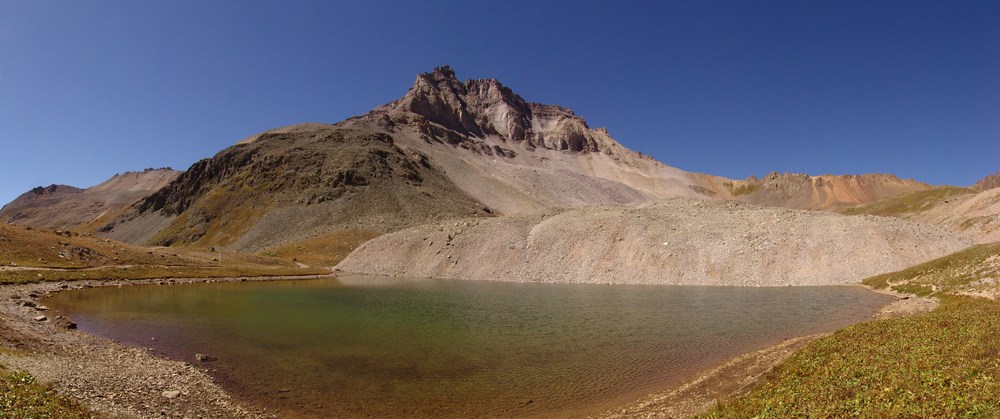
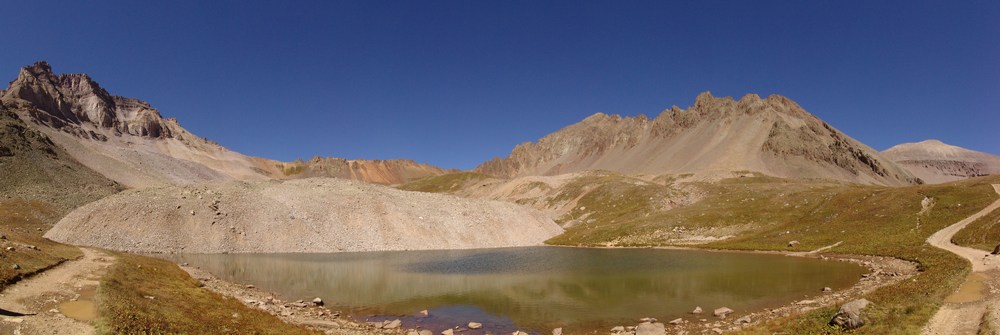
Gilpin Peak and Mount Sneffels.
As we hiked down, we were blessed with one last great view of Yankee Boy Basin.

Yankee Boy Basin
We reached my Jeep at 12:00 PM and drove out. The road was quite enjoyable in 4WD without power steering...
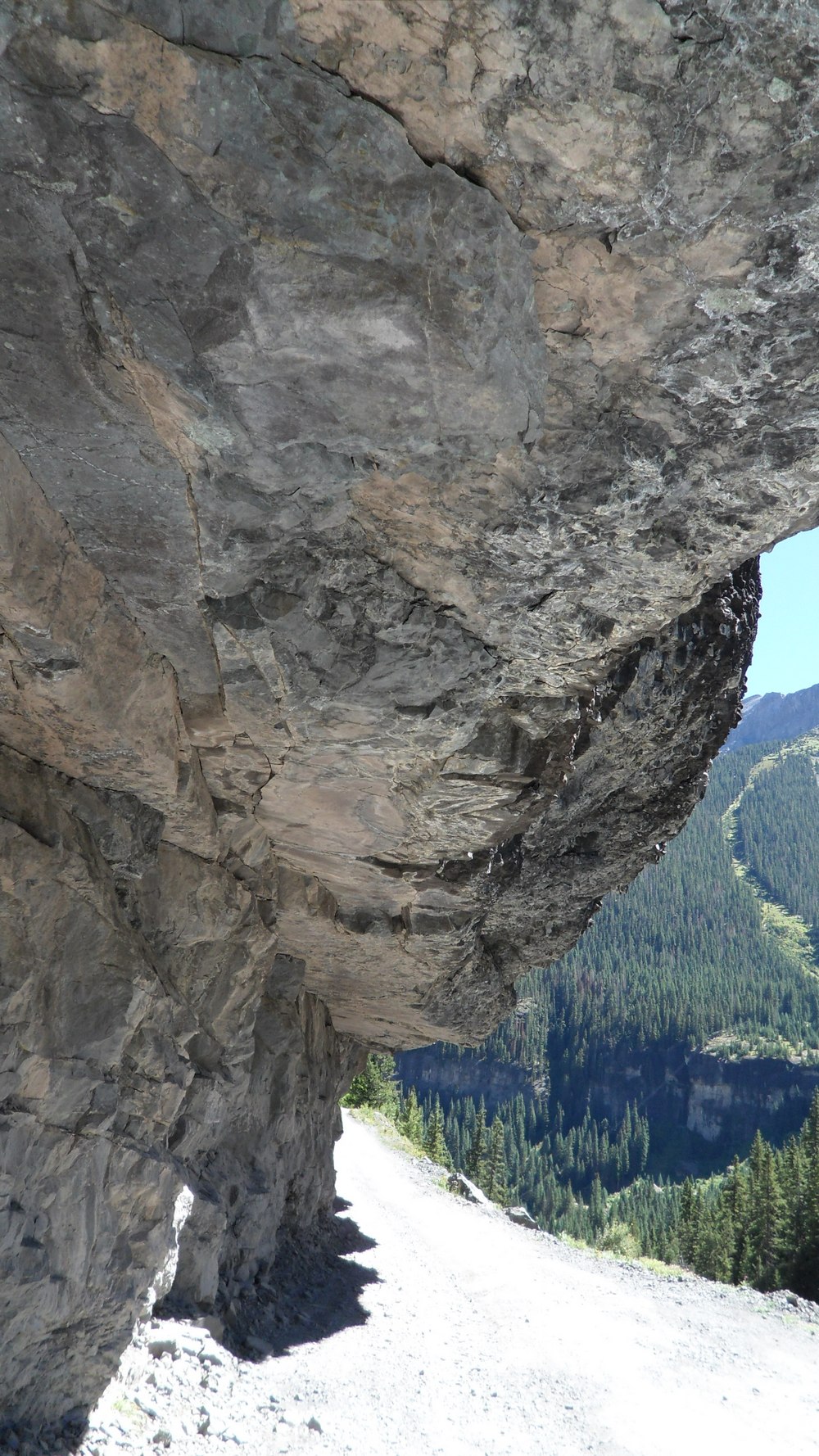
If you've never been up the road, it is worth it to drive up it. There is a really awesome overhang about halfway up the road that is quite impressive.
We drove into Ouray and ate lunch at the Ouray Brewery, which proved to be a great decision because they have a patio on their roof that made for excellent fall weather dining.
I hope you found this trip report useful and / or enjoyable! Thanks for reading!
References:
1 Rhoda, Franklin, Summits to Reach, An Annotated Edition of Franklin Rhoda's "Report on the Topography of the San Juan Country," edited and with preface by Mike Foster, Boulder, Pruett Publishing (1984).
2 Rosebrough, Robert F., The San Juan Mountains: A Climbing and Hiking Guide, Evergreen, Cordillera Press (1986).
Handies Peak and Whitecross Mountain - a sweet San Juan saunter
Hiking in the San Juan Mountains was quite possibly the best gift a dad could get. Make that two dads.
My dad is who introduced me to climbing mountains at the young age of six, and it was fitting that we spend Father's day climbing a mountain that we had both had our eyes on for quite a few years. While my dad had originally planned in the 1980's to save Handies Peak as his last 14er, he decided to give up that idea. The last time my dad climbed a 14er was Uncompahgre Peak in 2001 - another father-son outing in the San Juan Mountains, nearly 10 years ago. Having prepared for the past two months through rigorous training and exercise, my dad, now 60 years old, believed he was ready again for climbing. Since all I talk about anymore is climbing mountains, it was no surprise that his interest in climbing is renewed and I was very pleased that he asked to join me on my attempt of Handies Peak. My dad (Old Climber on this site) and I debarked from Colorado Springs at roughly 5:00 PM on Friday, June 18th 2010, heading straight for the rugged San Juan Mountains in southwestern Colorado. We drove south down State Highway 115 and connected with Highway 50 heading west. We stopped for a bite to eat in Salida and drove to Gunnison and south towards Lake City. The drive up towards Cinnamon Pass from Lake City was a somewhat confusing one in the dark - there are a couple points where you can make a wrong turn - neither intersection having been mentioned on the route description at 14ers.com. To top things off, the road was pretty rough, but my Jeep handled it like a champion. We managed to find our way to the American Basin near Handies Peak and began setting up camp with our headlamps on at around 11:30 PM.
Here are some interesting statistics from this amazing adventure:
Total elevation gain: 3,629 ft.
Total distance hiked: 8.22 miles
Total time hiking: 8 hours, 15 minutes
Total photos taken: 346
Total wildlife sightings: 3
Total distance driven: 480 miles
Trip duration: 28 hours
A map of our driving route to our campsite in the American Basin from Colorado Springs
As we began setting up camp, I turned back towards my vehicle to see two glowing eyes about 20 feet away. These were no ordinary glowing eyes - these were quite large and clearly fit a very large animal. I whispered to my dad, "Ray - look - there is an animal over there!" Ray got out his flashlight and revealed a giant moose! We were both in shock, as neither of us had seen a moose in the wild in Colorado before. The moose walked around our campsite for much of the remainder of the night and at one point got within 5 feet of the tent before walking away. I decided to name the moose "Tim" since I thought it would be funnier and more convenient to refer to the moose by name instead of "it" or "moose."
The moon was about half-full and lit the basin up quite well. We could make out the ridge line of Handies Peak and the American Basin crags (American Peak, ranked 102nd highest in Colorado).
We enjoyed the views of the basin in the moonlight and set the alarm on my Suunto Core watch for 5 AM. The tent was sitting on a lot of wierd bumps, so sleeping was not the easiest of tasks. I think I did get a few hours of pretty spotty sleep before the alarm went off. We woke up and broke down our camp pretty quickly while eating some oatmeal. "Tim" was still hanging around, eating some willow trees 50 or so yards away from our campsite. We prepared our packs and debarked up the road towards the trailhead, but not before taking a photo of the basin around our campsite.

Handies Peak seen at left of center with American Peak at dead center and UN 13,512 at far right. The American Basin is a very peaceful locale.
The plan for the day was to ascend Handies Peak (14,048 ft. and ranked 40th in Colorado) via the standard trail and then to traverse over to Whitecross Mountain (ranked 222) to the northeast of Handies. Starting the hike pretty early and at a respectable elevation, I believed that the itinerary would be quite manageable.
A topo map with my route shown in red. We began the hike near the word "Fork" on the map.
Ray and I quickly began the hike up the trail at 6:15 AM and within minutes, the sun began to light up the surrounding peaks, including American Peak.

American Peak gets a healthy dose of sunlight.
The basin itself was quite serene, with waterfalls everywhere and green slopes and orange mountain tops surrounding us in all directions.

Ray Payne with an awesome waterfall in the background
We probably could have made better time, but I was taking tons of photos the whole way up!
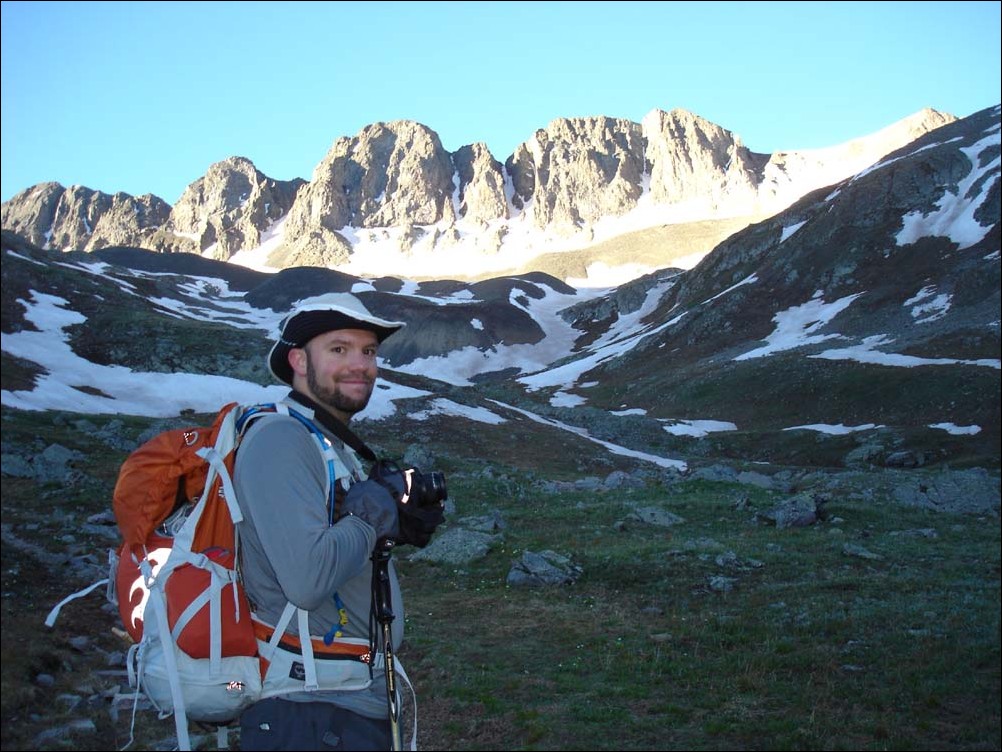
Matt Payne with American Peak in the background.
The trail was mostly snow-free, with a few sections of snow obscuring the trail. We were able to quickly follow the trail up the side of Handies Peak, weaving our way up towards Sloan Lake.
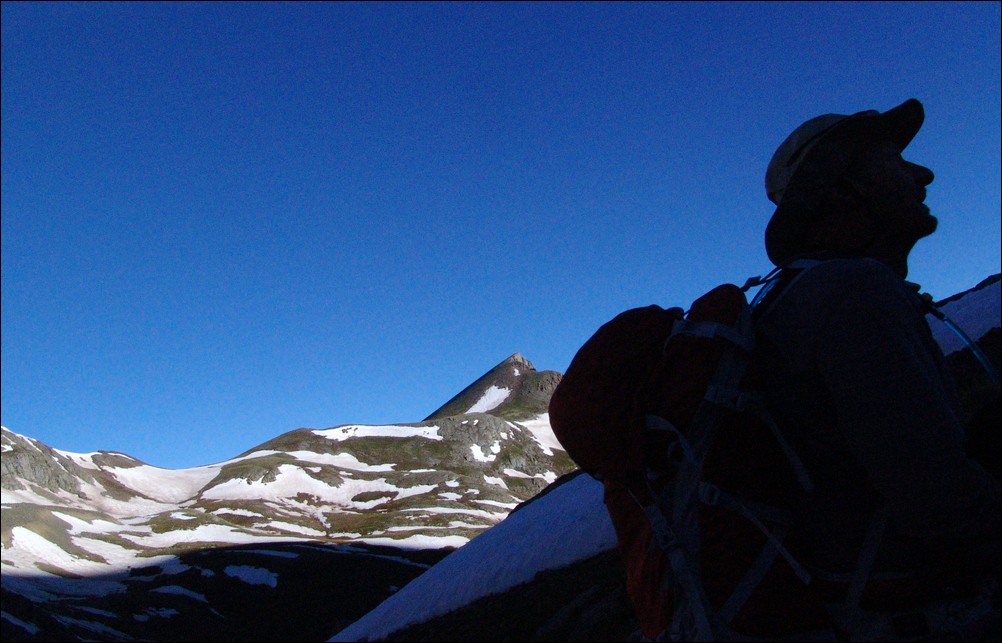
Ray Payne gazes up the side of the relatively steep trail leading up Handies.
Shortly before reaching the turn-off for Sloan Lake, I stumbled across a beautiful ptarmagin, still in the process of changing out of its winter coat and into its summer colors.
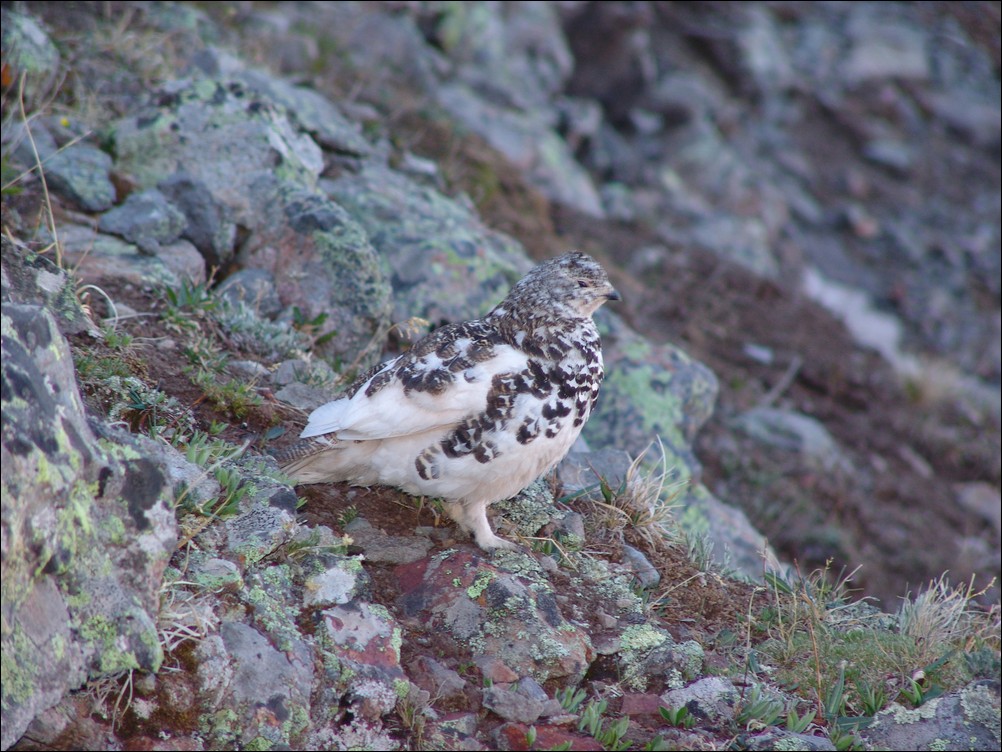
A ptarmigan rests on rocks near the trail leading up Handies Peak.
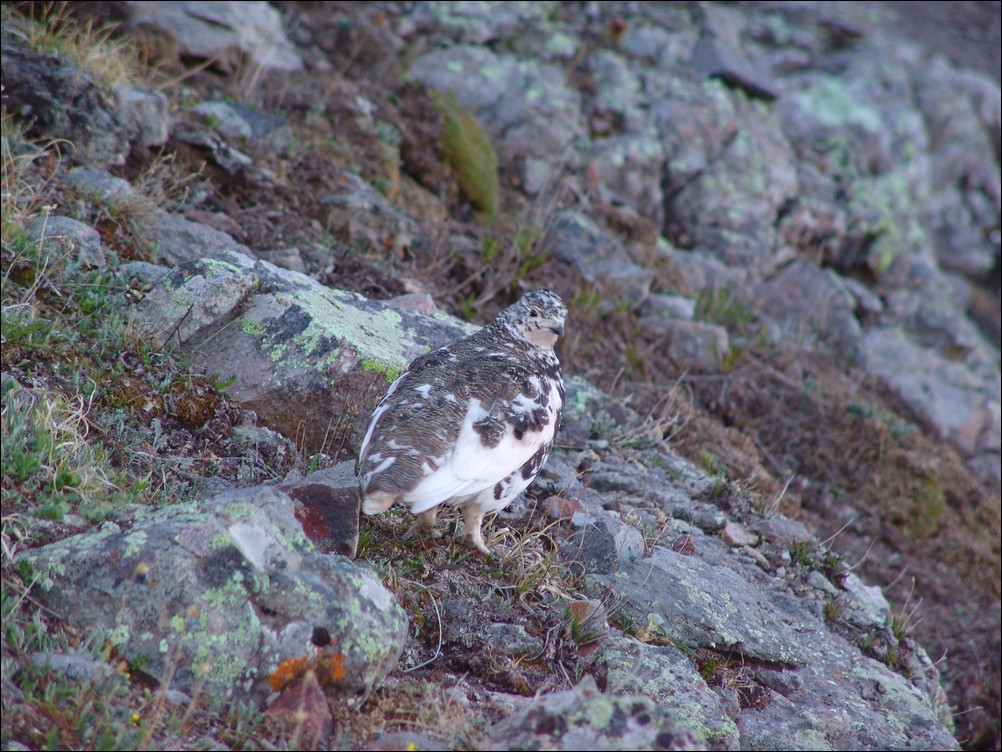
The ptarmigan peers back at me, wondering if it is on the menu for dinner.
The ptarmigan made a loud squak and flew down the trail and away from our threatening gaze. What a pleasure it was to see wildlife!
Shortly after heading away from Sloan Lake, the trail turns back towards Handies and down through a small snowfield. The snow was steep but easy to navigate.
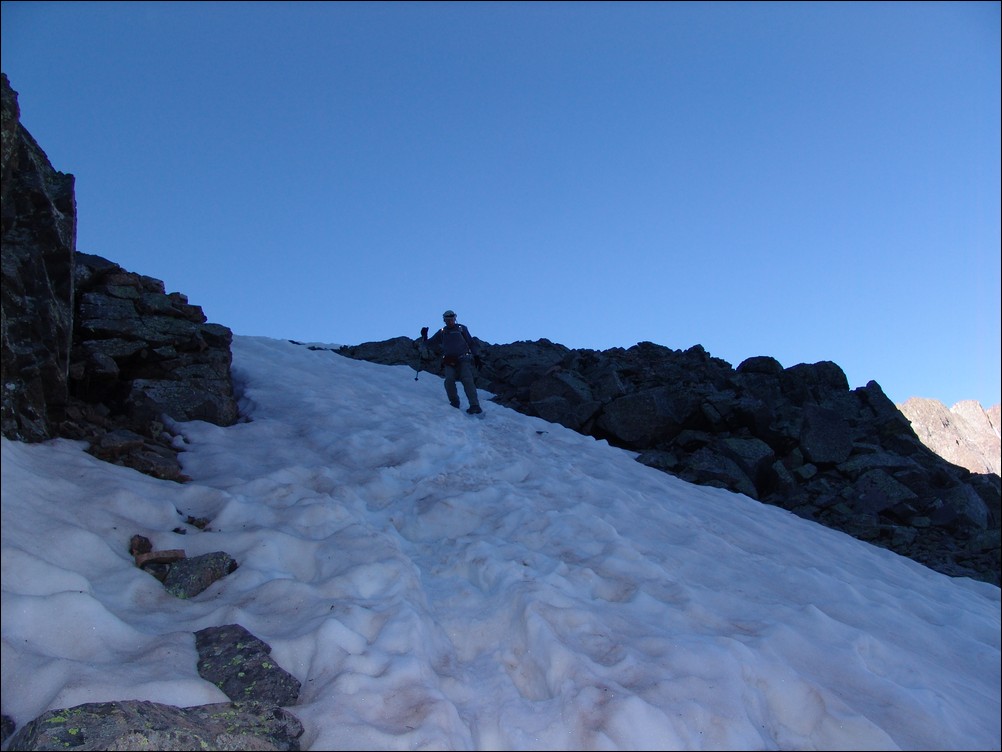
Ray navigates through a steep snow field.
The trail quickly zig-zags up Handies and before we knew it, we gained some incredible views back down into the American Basin.

Sloan Lake sits in front of American Peak, with the Handies standard route trail below. The first view of distant San Juan Mountains is revealed.
We rested in the shadows for a bit and resumed the hike up towards the saddle between Handies Peak and American Peak. Once gaining the saddle, views east into the next valley over were presented with the morning sun welcoming us.

A 360o view from the Handies - American Peak saddle. As a reminder - many images can be clicked on to view the full resolution versions!
We continued up towards the summit of Handies and were wildly surprised with a view of Rio Grande Pyramid, one of the top 100 summits in Colorado (ranked 97).
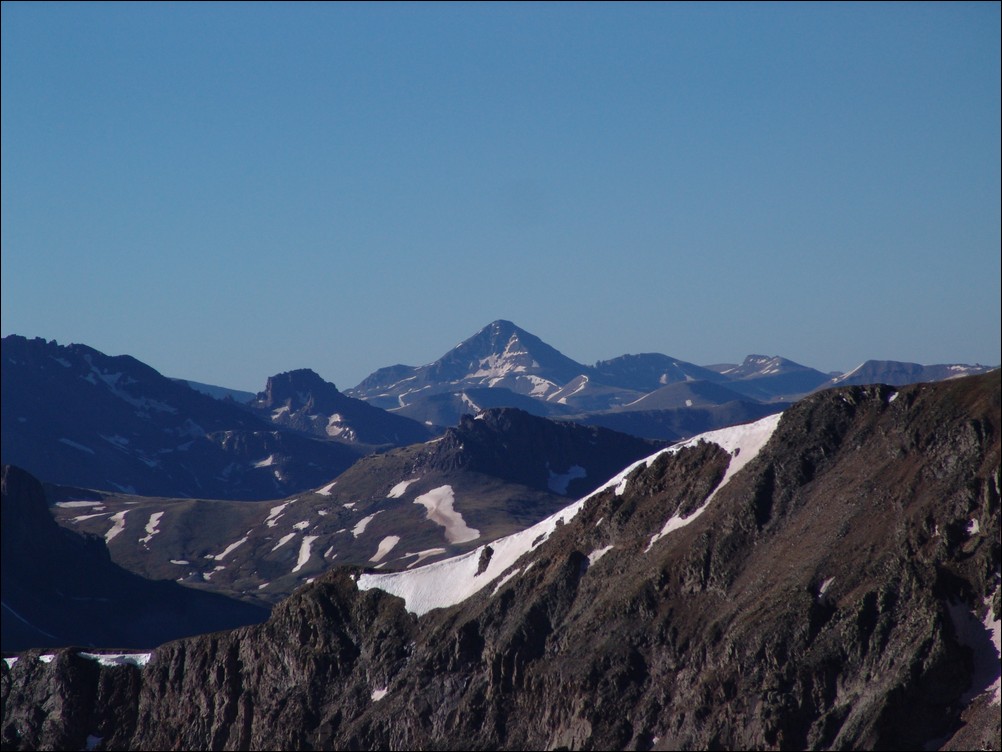
Rio Grande Pyramid sits prominently in the far distance to the south of Handies Peak.
This was a particularly exciting discovery for Ray and I since we are planning to climb Rio Grande Pyramid at the end of August of this year. Getting a first-hand view of this magnificent mountain was quite awesome.
We also could not help but notice the other quite prominent mountain sitting in front of Rio Grande Pyramid Peak on the near side of Pole Creek Mountain (ranked 138th in Colorado) - Half Peak (ranked 86th in Colorado).
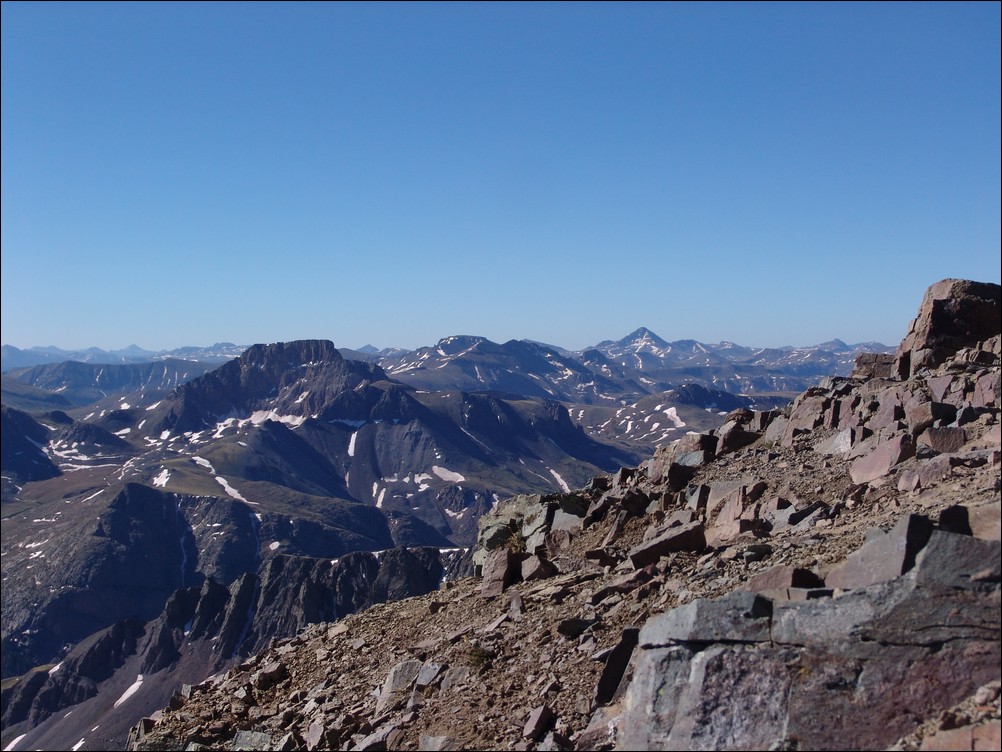
Half Peak (left of center) sits left (northeast) of Pole Creek Mountain, and Rio Grande Pyramid.
Additionally, views of Mount Sneffles (ranked 27th in Colorado) and the surrounding mountains came into view.
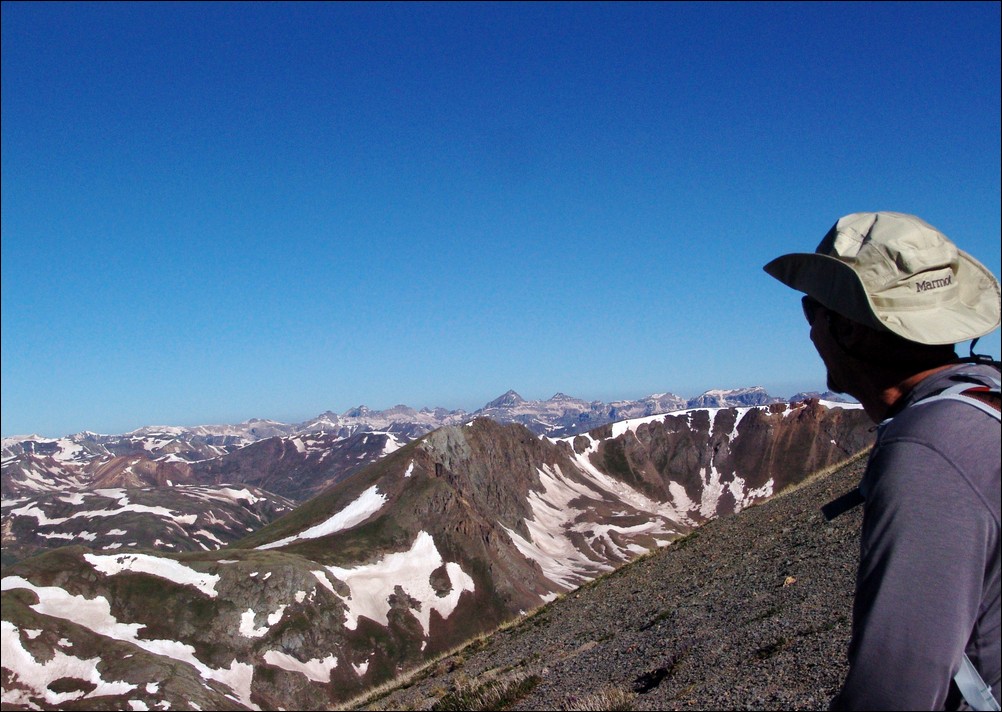
Ray Payne gazes towards Mount Sneffels to the northwest.
Ray snapped a shot of me before I continued up the trail.
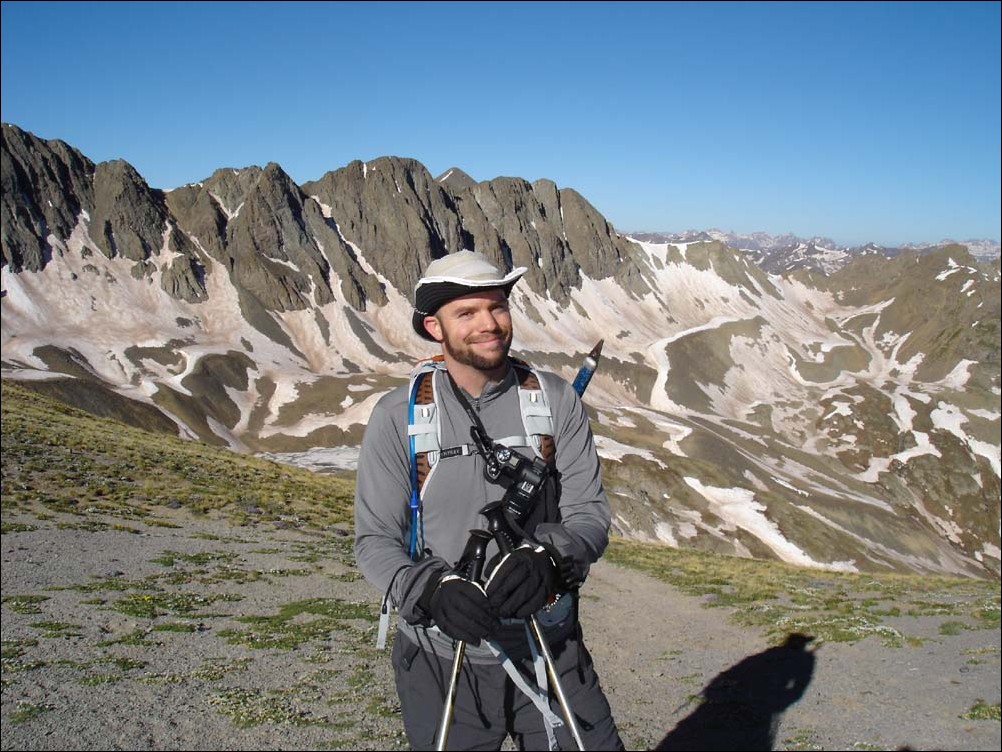
Having gained the amazing views of the San Juans, I was re-energized to hike faster, so I quickly made my way up towards the summit of Handies. I peered back to catch the first glimpse of the Grenadiers and Needle Mountains near Silverton. I have always been completely awe-struck by these mountains, so seeing them from here was quite exciting for me. Views of Pigeon Peak (ranked 57), Vestal Peak (ranked 77), and Arrow Peak (ranked 104) were impressive. Due to the fact that I am climbing Vestal's Wham Ridge and Arrow Peak in three weeks, this view was especially awesome.
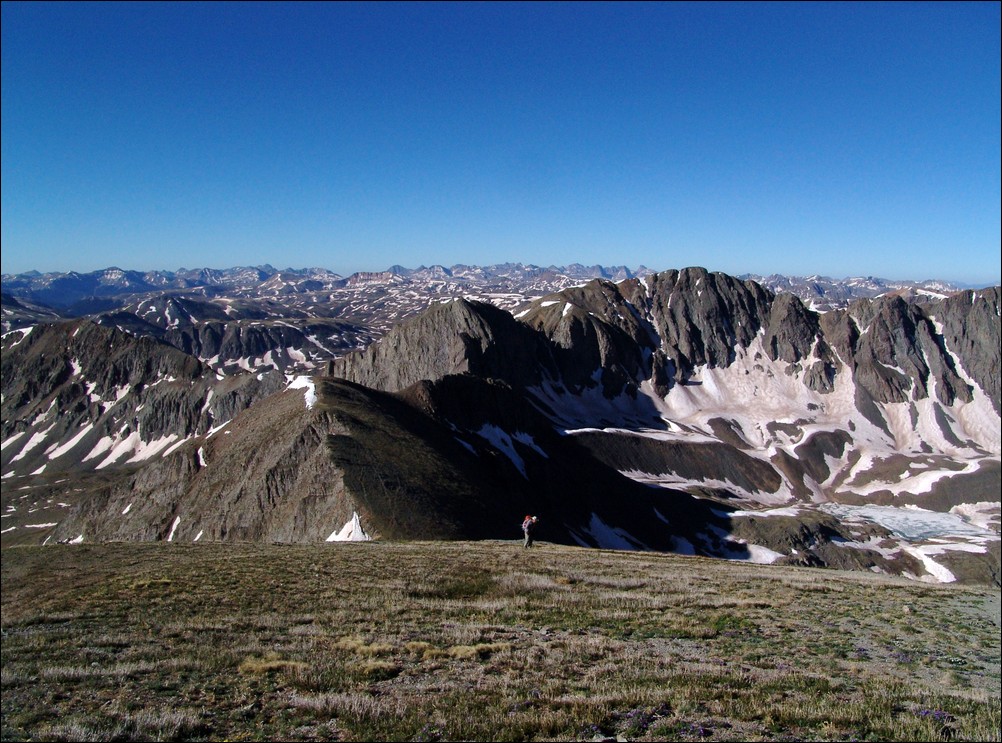
Ray Payne ascends Handies with the Grenadier range and Needle Mountains showing themselves above American Peak. Pigeon Peak seen just above American Peak, with Arrow and Vestal Peaks to its left.
I was able to complete the climb of Handies at 9 AM, a brisk 2 hours and 45 minutes after we started, and was greeted at the top by Ray within minutes. Handies was the 48th 14er for Ray and the 36th 14er for me.
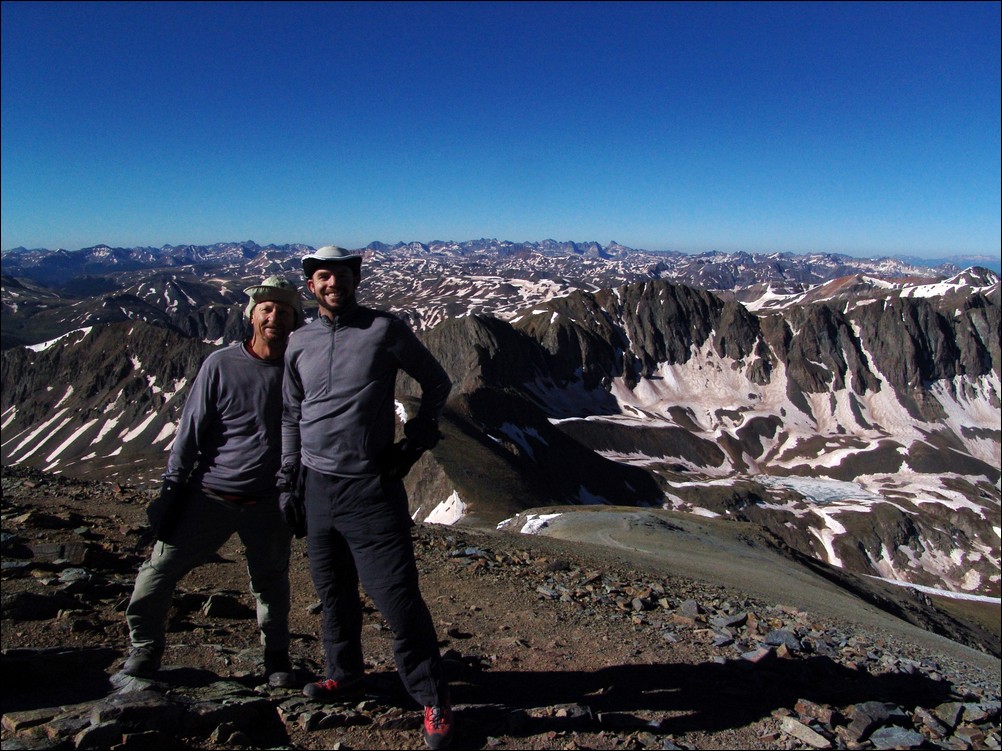
Matt and Ray Payne celebrate on top of Handies with the Grendiers and Needle Mountains in the background.
The wind on top was fairly chilly, so Ray and I found shelter on the eastern side of the summit. Ray got out his topographical maps and I began to take my ritual photos for the 360 degree panoramic photo from the summit. The views from Handies were much more impressive than I could have ever imagined.
A 360o view from the top of Handies Peak. The views of the mighty San Juan Mountains were astounding. Click on the image for the full resolution version (very large).

A 180o view looking northeast to west from Handies Peak.
I continued to marvel at the sheer impressiveness of the Grenadiers. The thought of climbing them in a few weeks seemed very surreal. Vestal's Wham Ridge looked impossible.
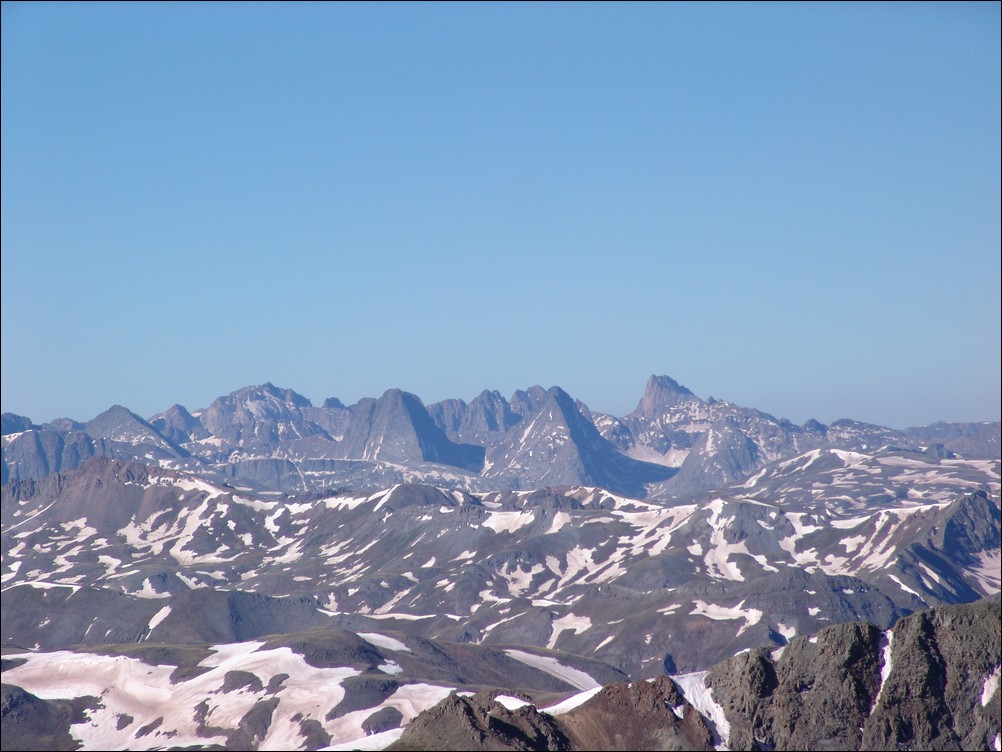
The Grenadiers and Needle Mountains zoomed in.
Views of other areas of the San Juans also did not disappoint. The Ice Lake Basin and Wilson group were quite impressive as well.

Looking west from the summit of Handies Peak
In my office at work, I have a framed topographical map composed of many different 7.5 minute maps of the Grenadiers and Needle Mountains. I had always wanted to capture a comprehensive photo of that area, showing the various summits of the region. I had a great time using the 100summits.com Google Earth plugin tool to attempt to correctly identify all of the mountains in the following giant panoramic photo. I would greatly welcome and appreciate any feedback or corrections to the labels, as the viewpoint from Handies made for a distorting and confusing process for peak identification. Be sure to click on the images to see the full resolution versions and the labeled photo (2nd photo).

A large zoomed-in panoramic photo of the San Juan Mountains.

Many mountains are labeled in this version. Send corrections to This email address is being protected from spambots. You need JavaScript enabled to view it.
For a more natural way of viewing this photo, check out THIS PAGE.
Views of both Wetterhorn Peak and Uncompahgre to the north were also outstanding.
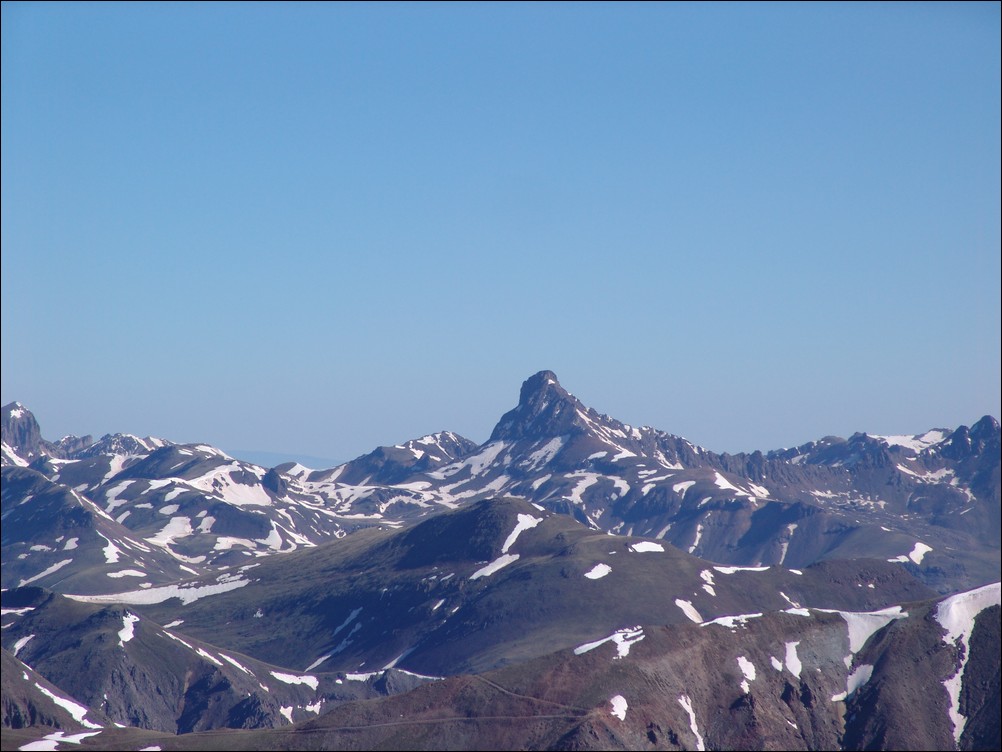
Wetterhorn Peak
Wetterhorn Peak (left of center) and Uncompahgre Peak (right of center) rise up impressively to the north of Handies
Looking further west, were able to identify Mount Sneffels and Teakettle Mountain (ranked 98th).
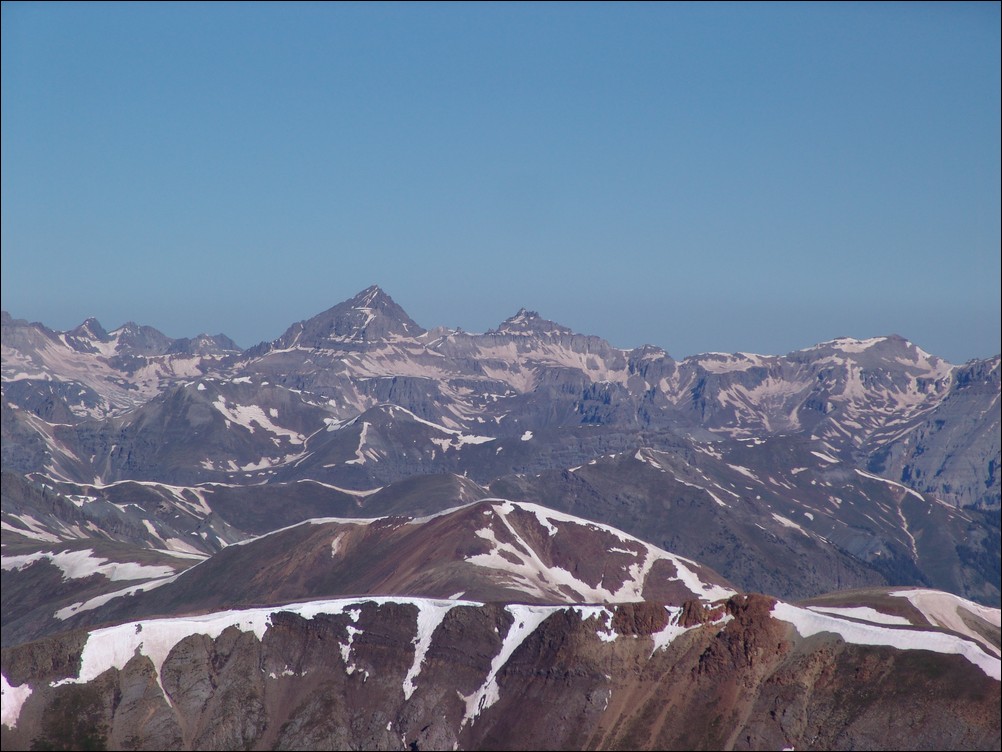
Mount Sneffels (largest at center) and Teakettle Mountain (right of Sneffels)
Due west of our position on Handies, were caught view of the Ice Lake Basin. We originally thought this was the Sneffels group; however, upon further investigation, we believe we have correctly identified the mountains west of Handies as U.S. Grant Peak (ranked 119) et.al.
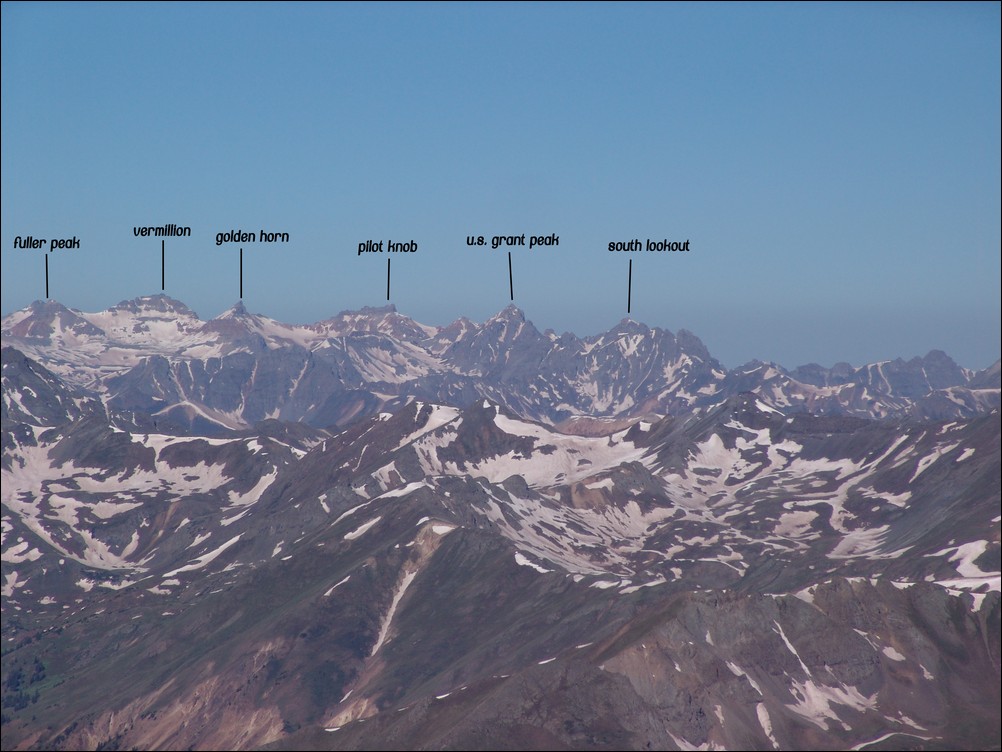
The Ice Lake Basin - send corrections to Matt at This email address is being protected from spambots. You need JavaScript enabled to view it.
After the whirlwind of photo taking, I decided to sit-down and eat some food. Ray ate his hard-boiled egg (apparently a long-standing tradition for him), while I chowed down on a Clif Bar and some cashews.
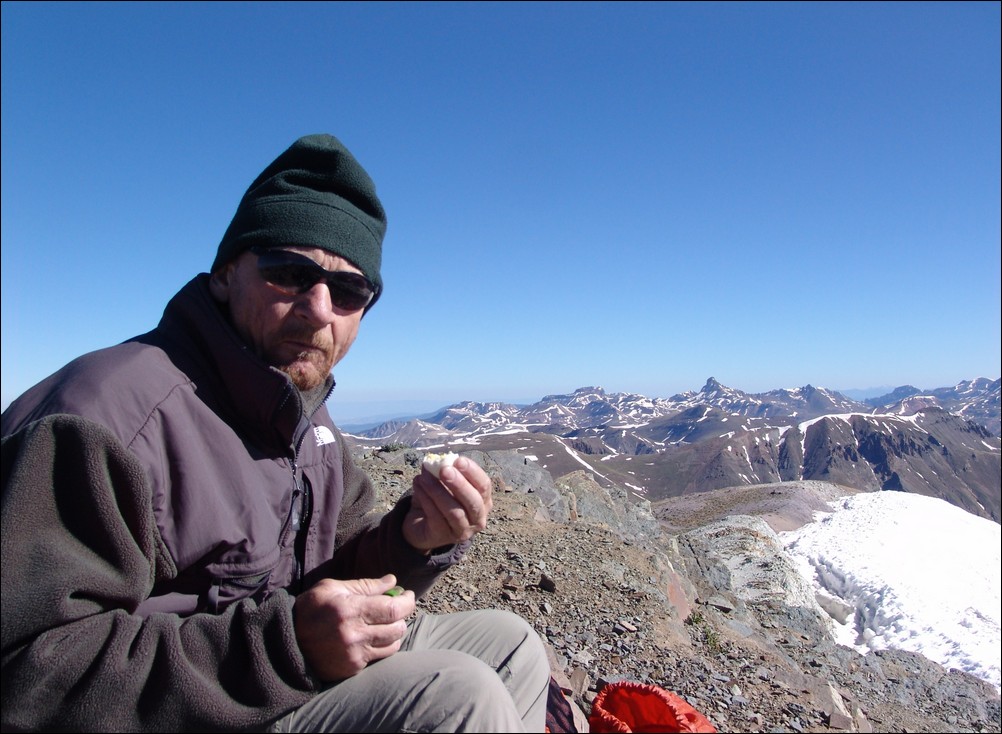
Ray chows down on a hard-boiled egg with Wetterhorn Peak behind him.
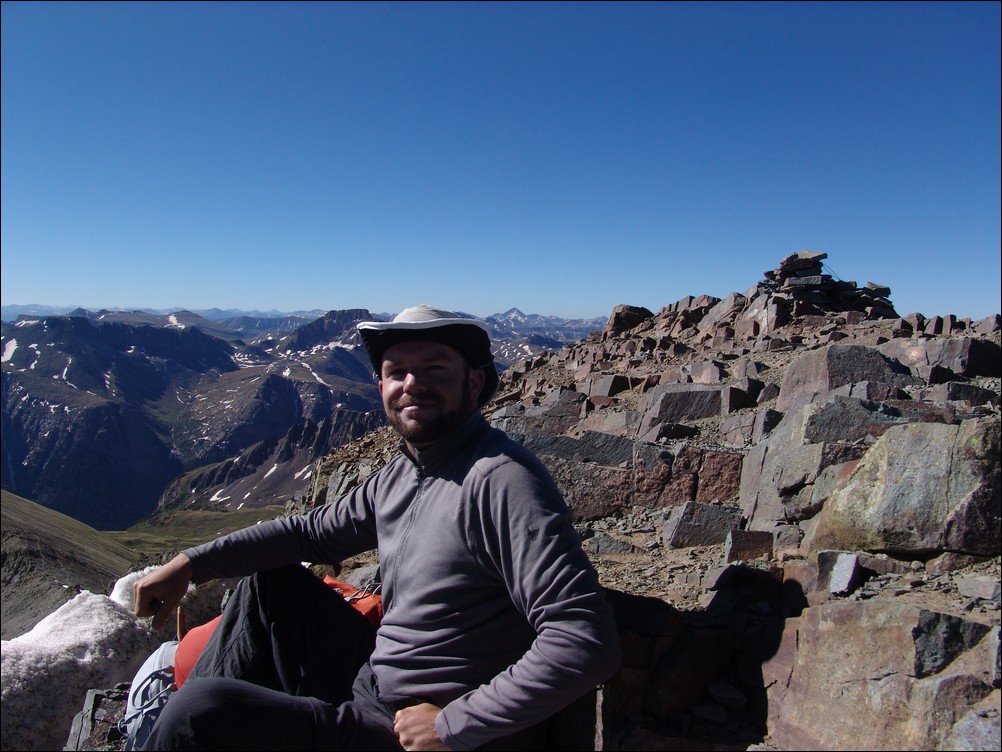
Matt Payne relaxes on the summit of Handies.
Sitting on the east side of Handies to eat, we were able to get a great view of Grizzly Gulch, Sunshine Peak and Redcloud Peak (ranked 53 and 46 respectively).
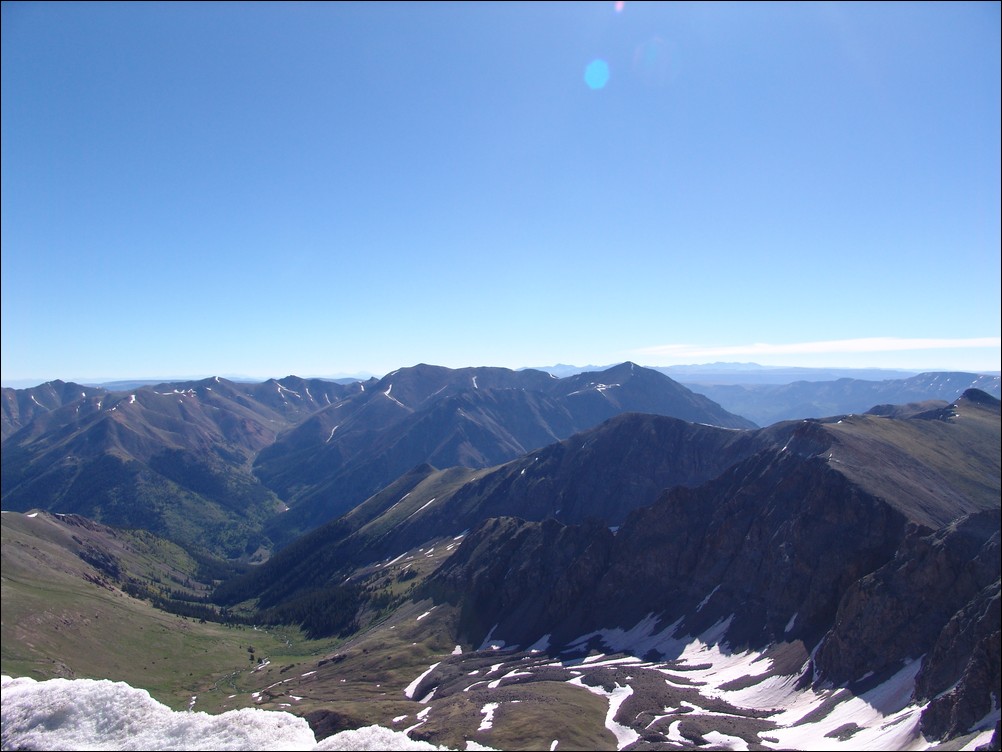
Redcloud and Sunshine Peaks rest just east of Handies.
Additionally, I was able to get a good glimpse of my second objective for the day - Whitecross Mountain. Whitecross looked further away than I thought it would, but with the insanely great weather we had and with my legs feeling superb, I was not concerned.
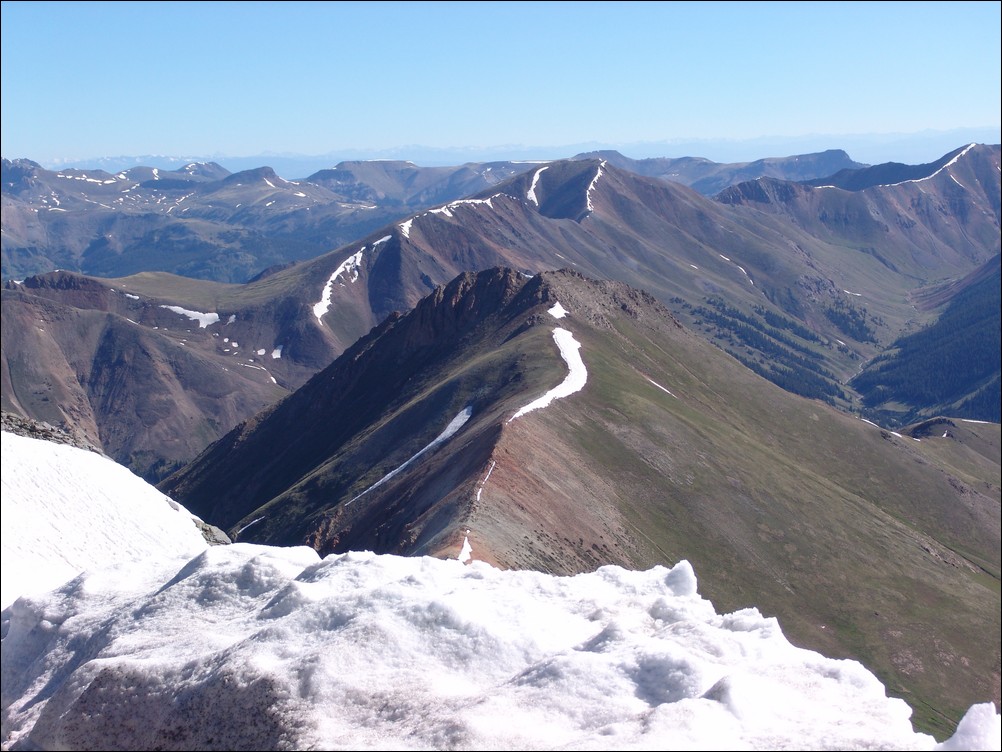
Whitecross Mountain and the traverse to it (partially obscured by snow).
We were joined on the summit by Ben Smith of 14erPlatinumTeam.com. Ben was with his friend Don, and they were quite friendly. We chatted for a bit about our climbing adventures and plans and exchanged website information.
I took more photos of the surrounding peaks.
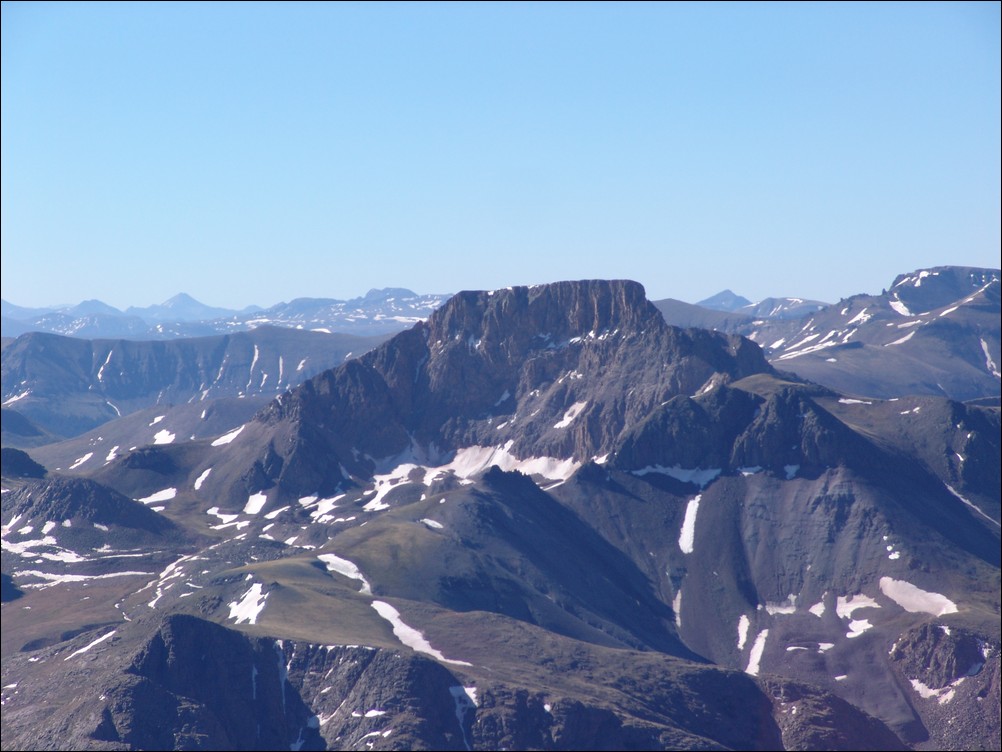
Half Peak
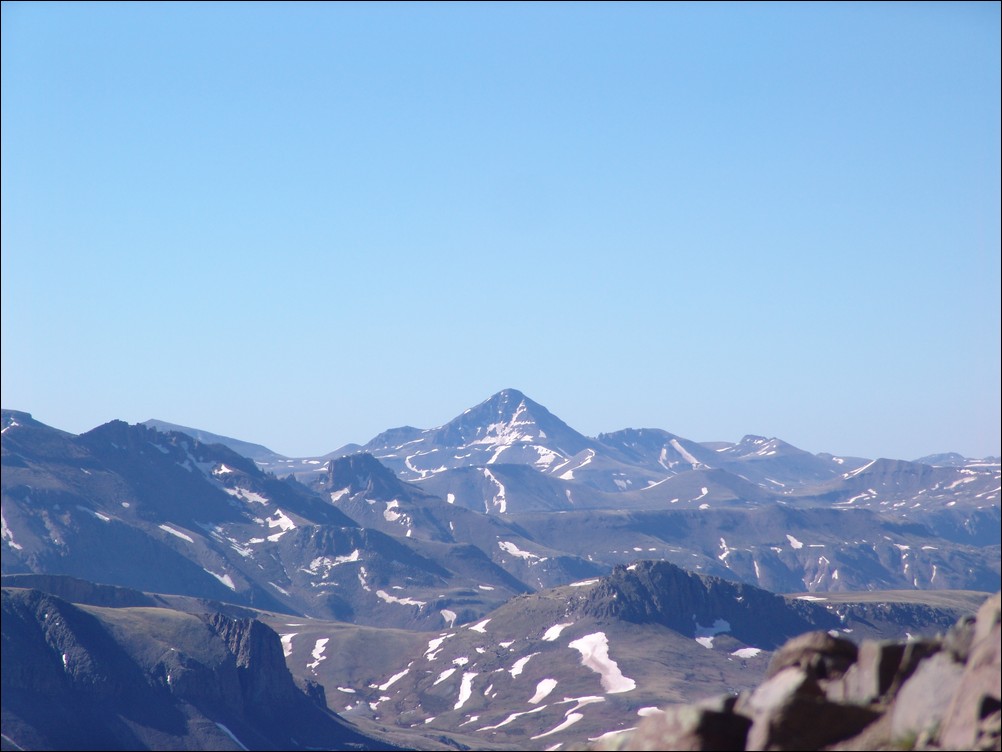
Rio Grande Pyramid
I had Don snap one more photo of my on top and Ben volunteered to take some photos with his camera as well. He was kind enough to email me the photo he took of Ray and I on top.
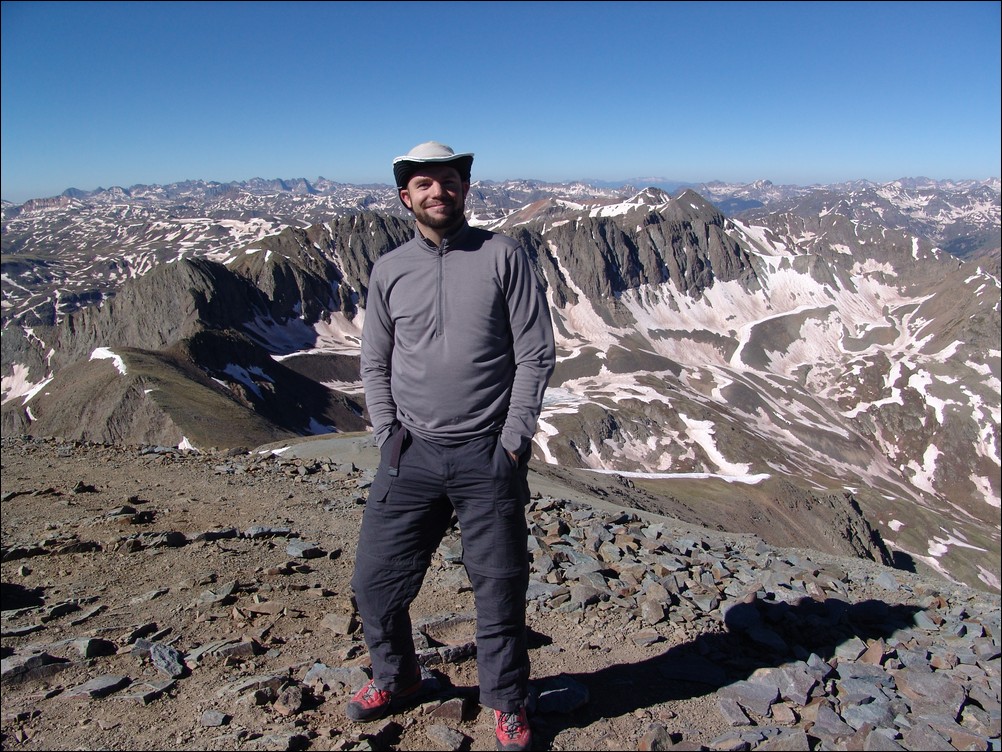
Matt Payne on top of Handies Peak
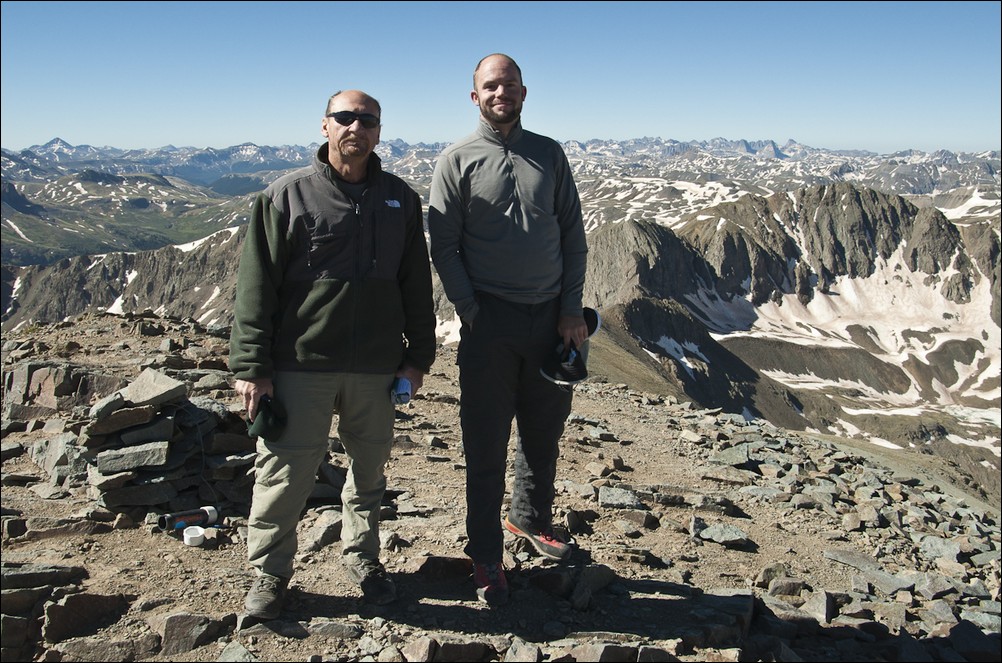
Matt and Ray Payne atop Handies Peak - photo courtesy of Ben Smith.
Ray and I packed up and got ready for our traverse over to Whitecross Mountain. Ray informed me that he would probably not go to Whitecross but would wait for me at the saddle between Handies and Whitecross. This sounded like a good plan and we began to head north after bidding adieu to Ben and Don.
Shortly after making our way down towards the Handies - Whitecross saddle, we gained an excellent view down to the west into the valley we started in. Lo-and-behold we could see my Jeep way down below.
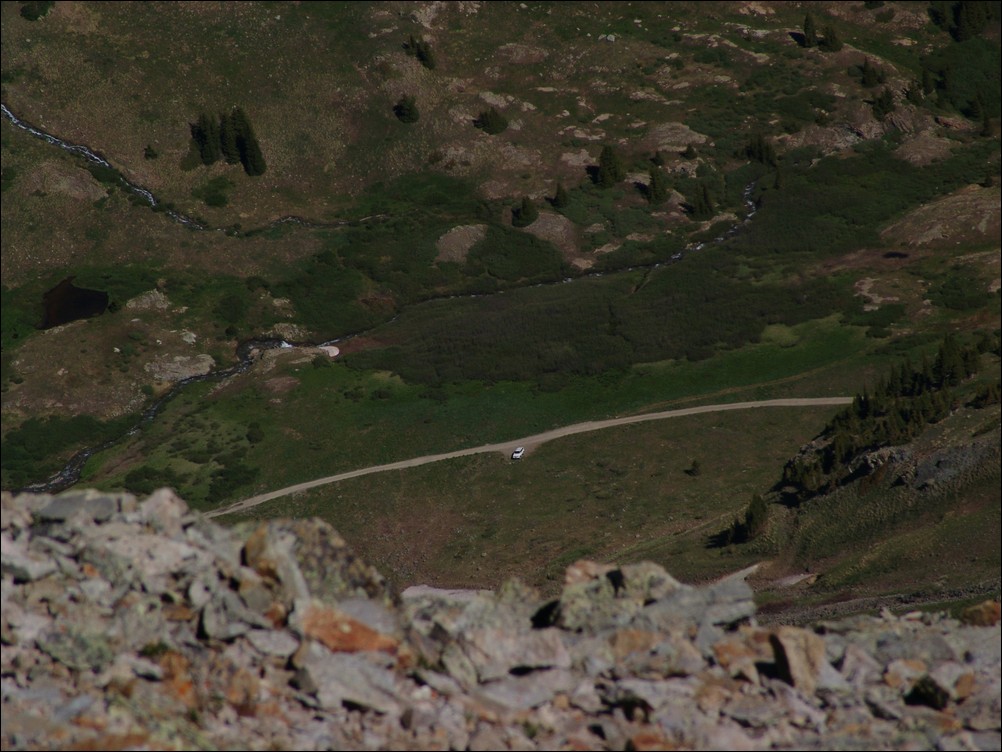
Matt Payne's Jeep far below in the American Basin.
After making it down the steepest section from Handies' summit, we gained excellent views of the Whitecross traverse and the terrain we ultimately needed to navigate across.
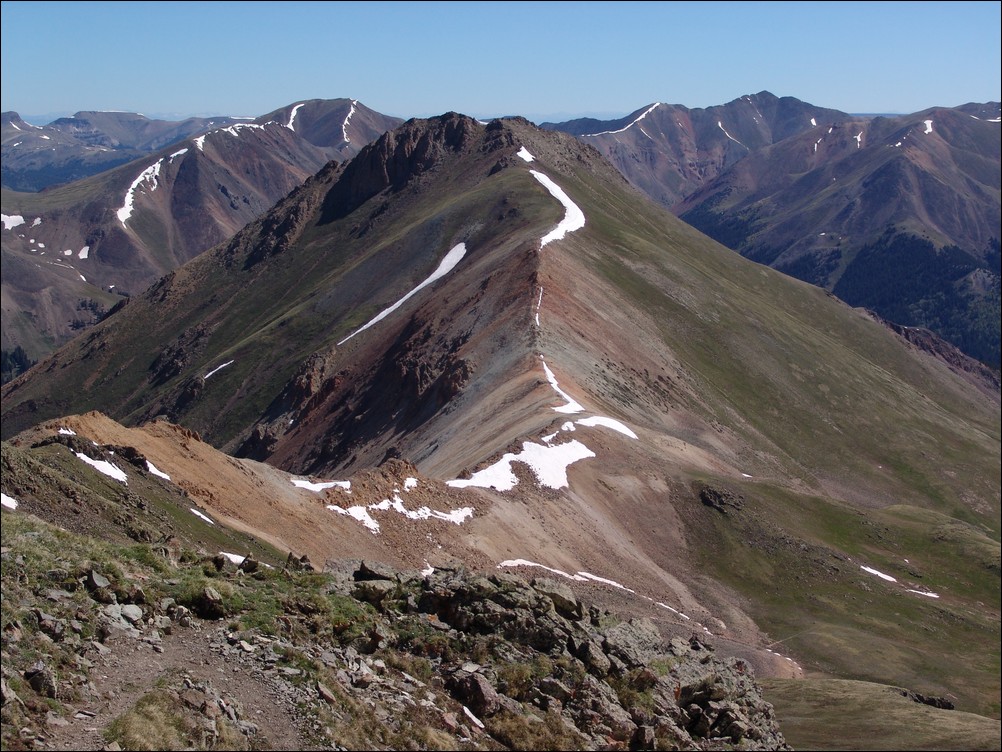
Whitecross Mountain's traverse terrain
By this point, we could look back at Handies and get a really nice profile of it from the north side.
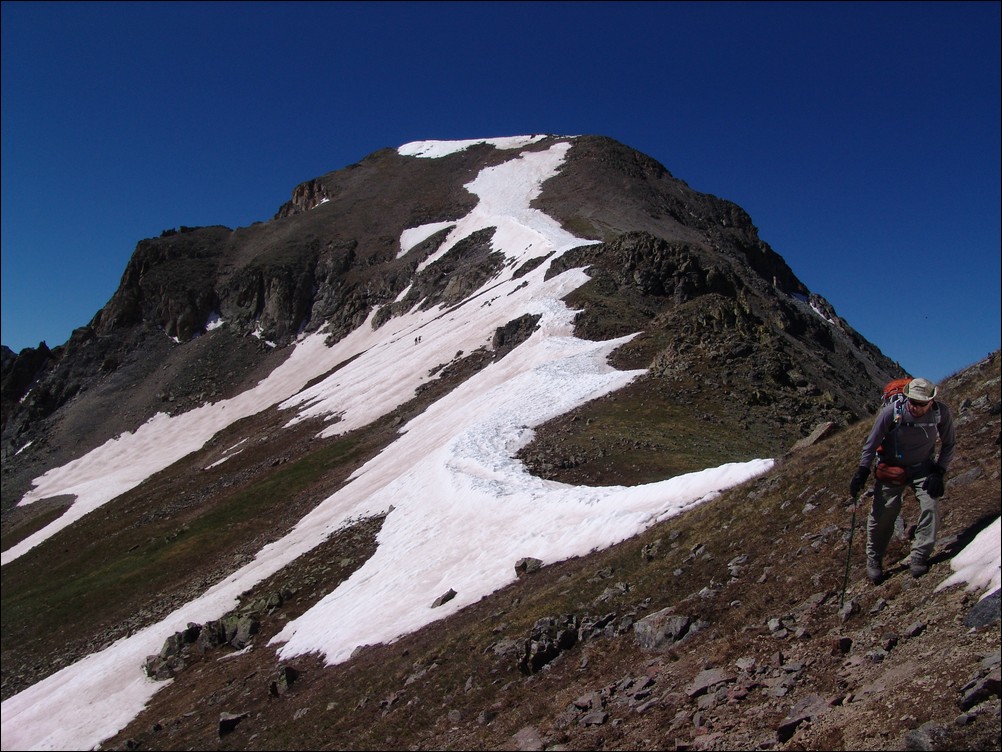
Ray Payne traversing towards Whitecross Mountain away from Handies Peak
Being mid-June still, we encountered some difficult snow on the traverse and at one point I fell up to my hips into a snow bank. This was rather uncomfortable, being on a quite steep section with about 100 feet of run-out below me. I decided to pause to gather my wits and to get out my ice axe. I used the ice axe as a safety device as I faced into the mountain and slow kicked steps into the snow while heading down at an angle towards the saddle. Ray followed in my footsteps and we both decided that it would have been smart to just stay high above on the ridge proper instead of angling around the side of the saddle near PT 13,577.
After successfully making it past the snowy sections, I once again stumbled upon a ptarmigan. This time, it let me get very close to it before I even noticed.
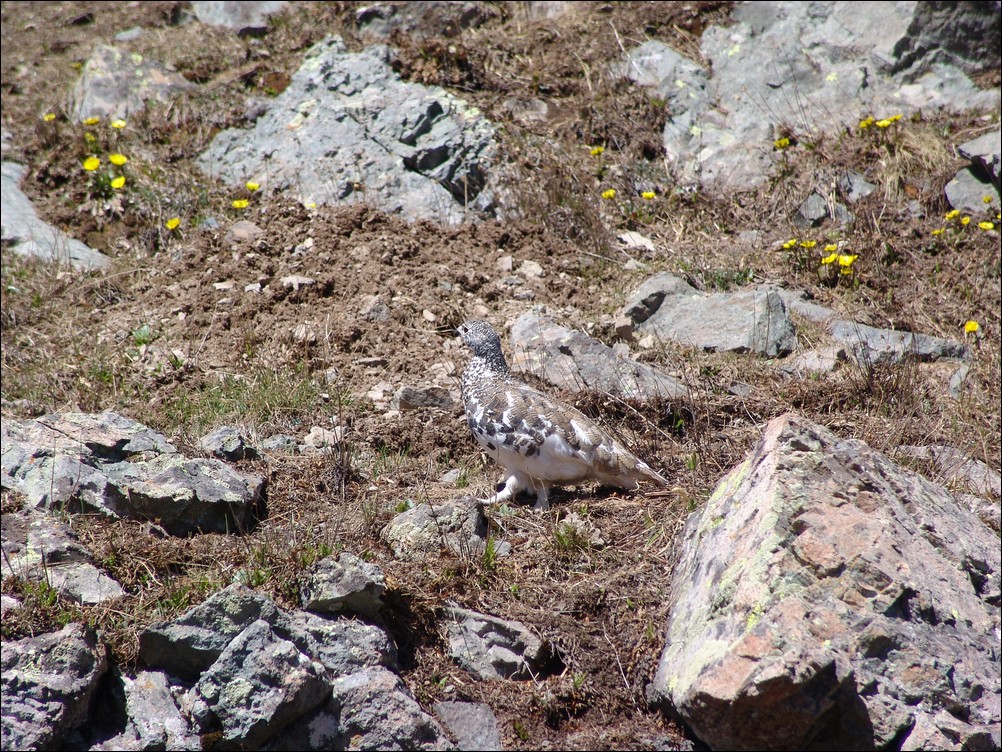
A Ptarmigan feeds upon the tundra near the saddle between Handies and Whitecross
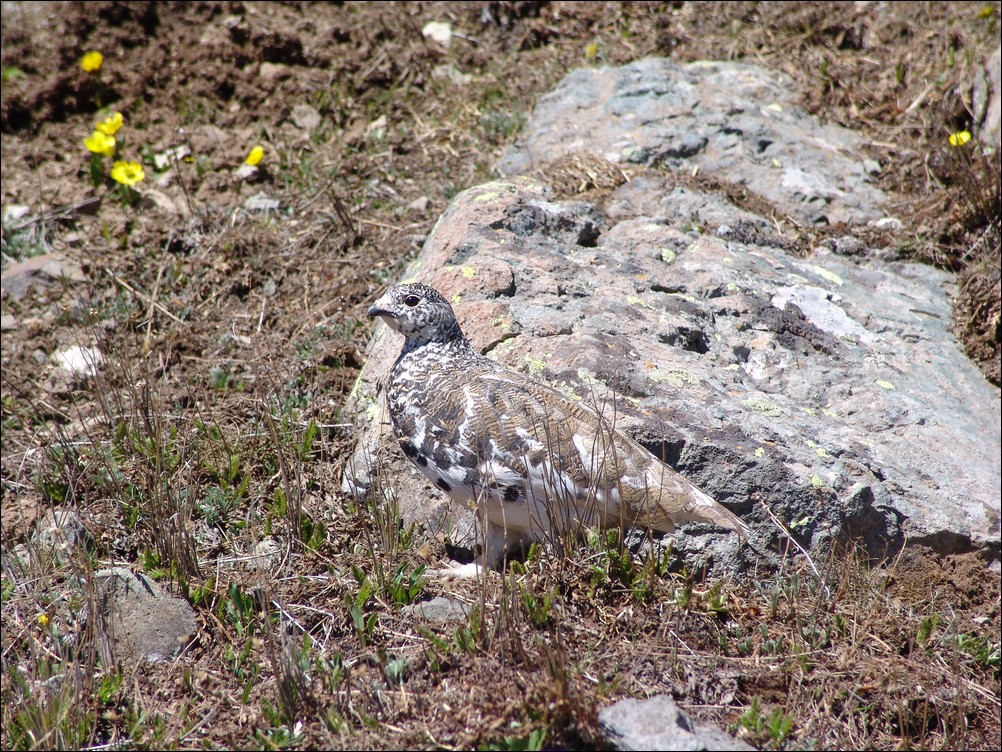
The views down into Grizzly Gulch were great during the traverse and I paused several times to get photos of the area.
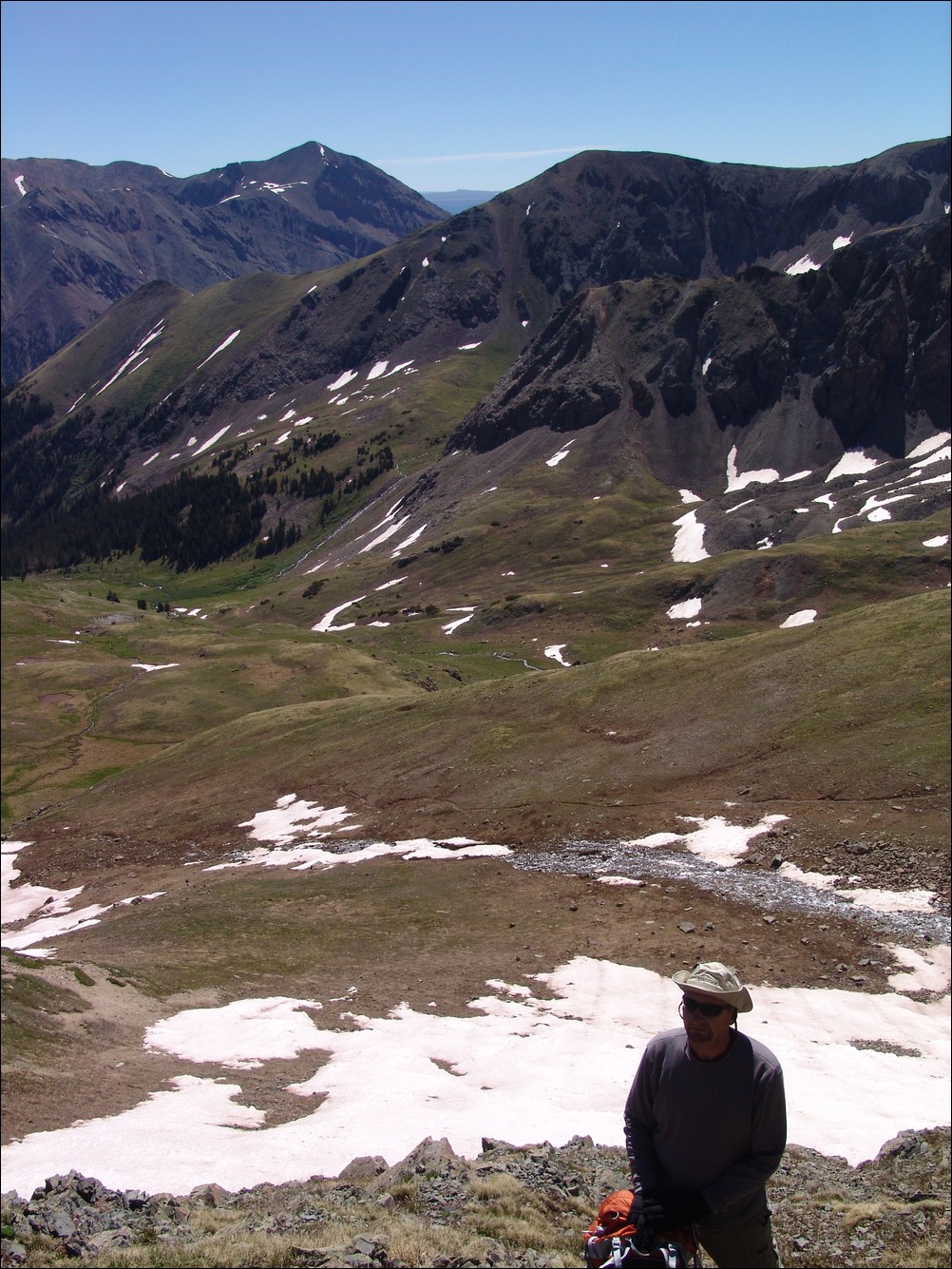
Ray Payne, traversing towards Whitecross Mountain, with Redcloud Peak left of center.
Most of the way to the saddle between Whitecross and Handies, we encountered some nasty scree below the ridge that we were forced to cross. The rock was the kind that when you stepped on it, huge sections of rock would slide above and below your feet. While this terrain is rather fun when down-climbing, it was not so fun while going across it.
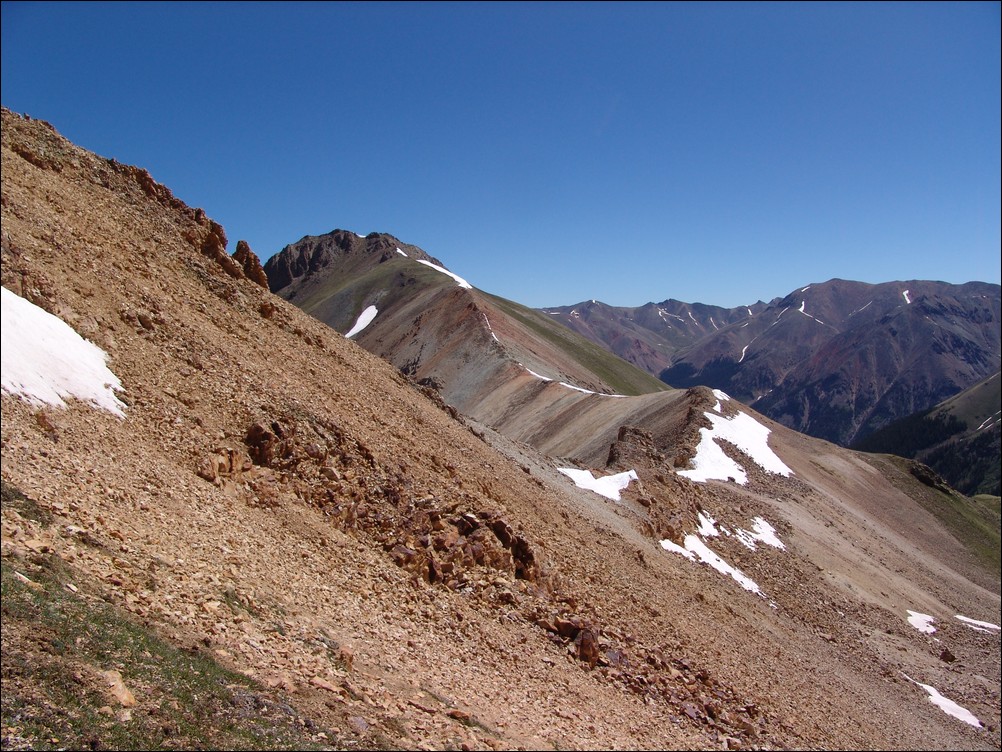
Scree with a red hue made for an interesting traverse to Whitecross Mountain.
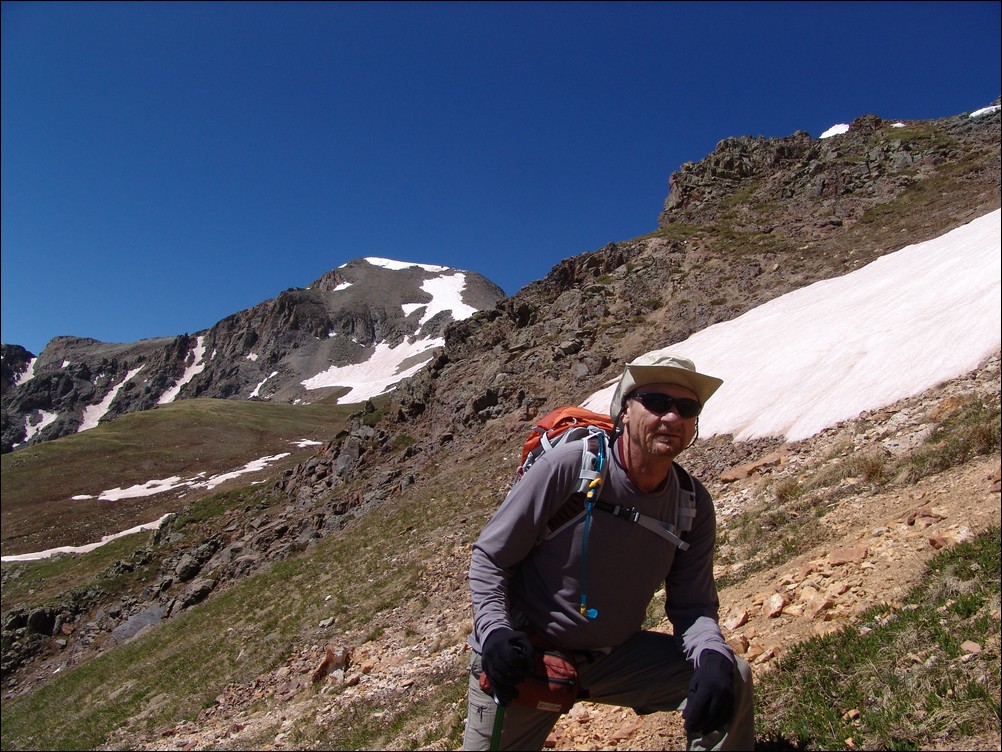
Looking back towards Handies Peak - Ray Payne welcomes the break in crossing the awkward terrain.
Ray and I reached the saddle near some fun rock outcroppings and discussed my plans for heading to Whitecross. I told Ray to "send the cavalry if I'm not back by midnight." I took off most of my gear and left it with Ray so that I could increase my speed for the traverse.
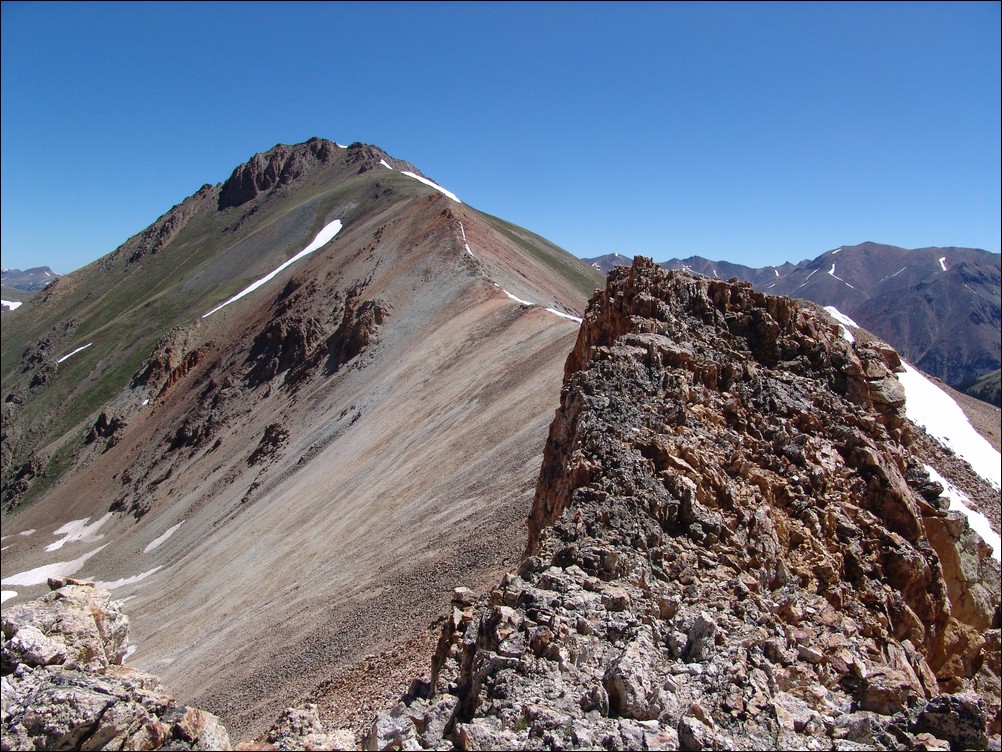
Whitecross Mountain sits above interesting terrain
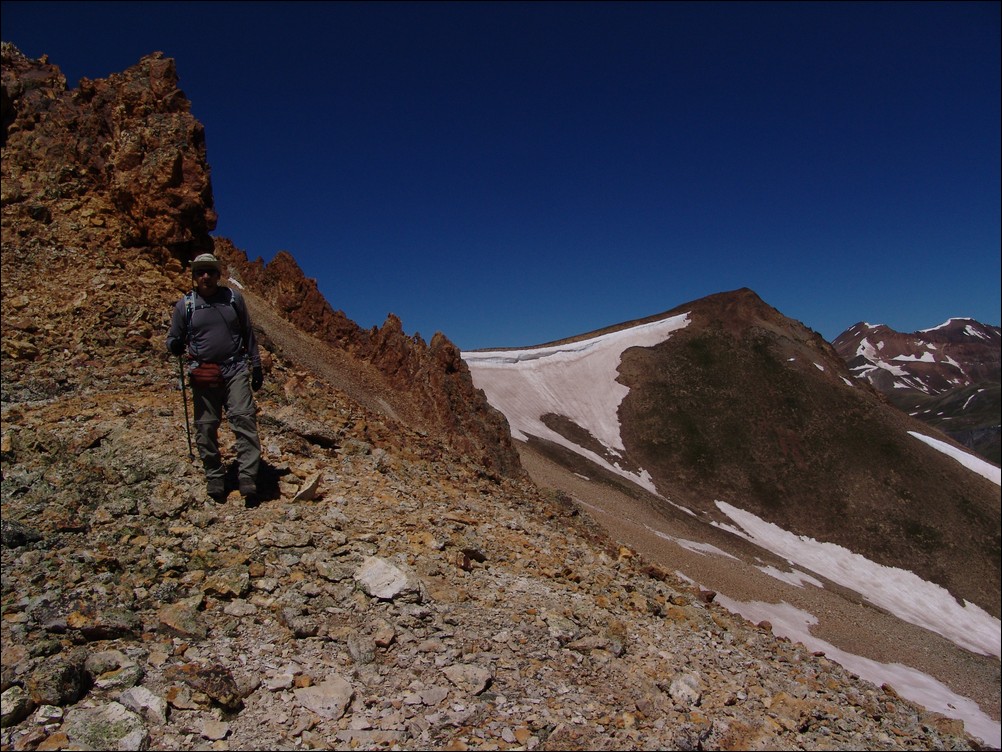
Ray Payne nears our meeting place
I started my traverse over to Whitecross at 11 AM. There were no threatening clouds and I felt solid.
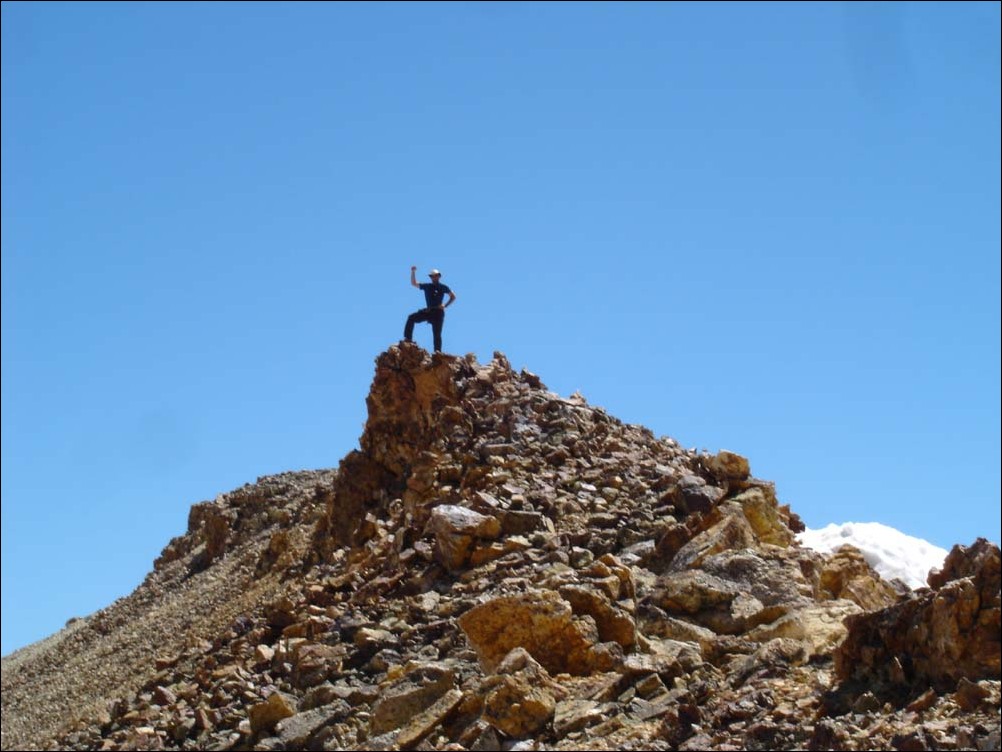
Matt Payne poses on top of a rock formaton on the way up Whitecross Mountain
About halfway up Whitecross, I was able to get a better view of the cornice across the way and Golden Horn (ranked 116) behind it in the distance.
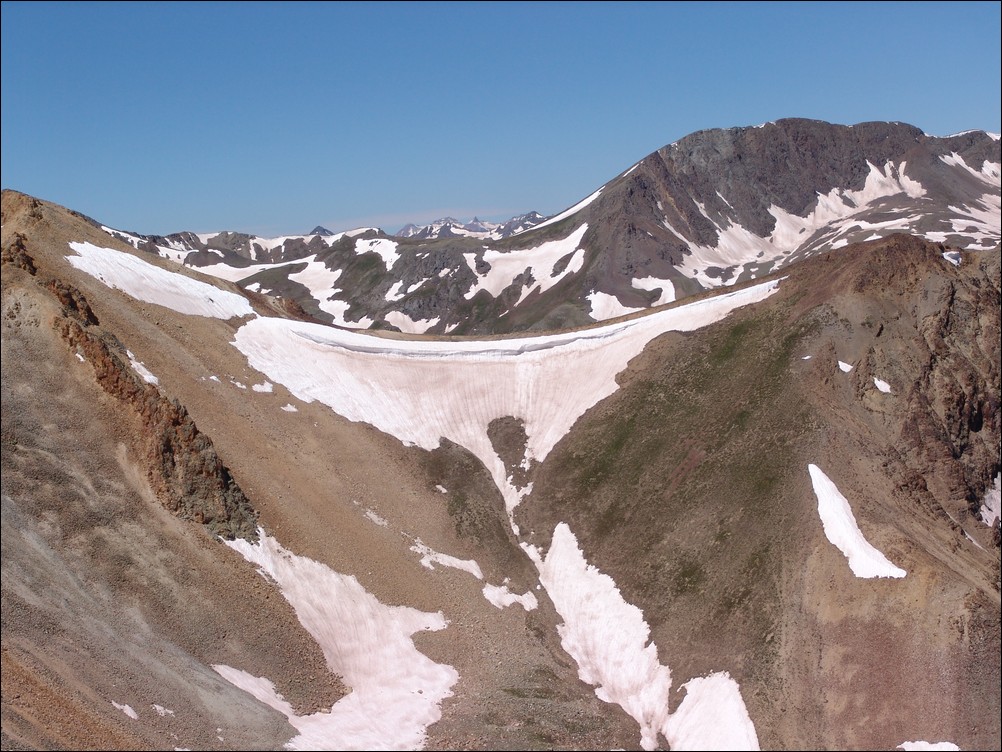
Cornice with Golden Horn behind it.
I made my way up Whitecross quite steadily and quickly. I made great time to the tundra field below it and could see the route up the summit block.
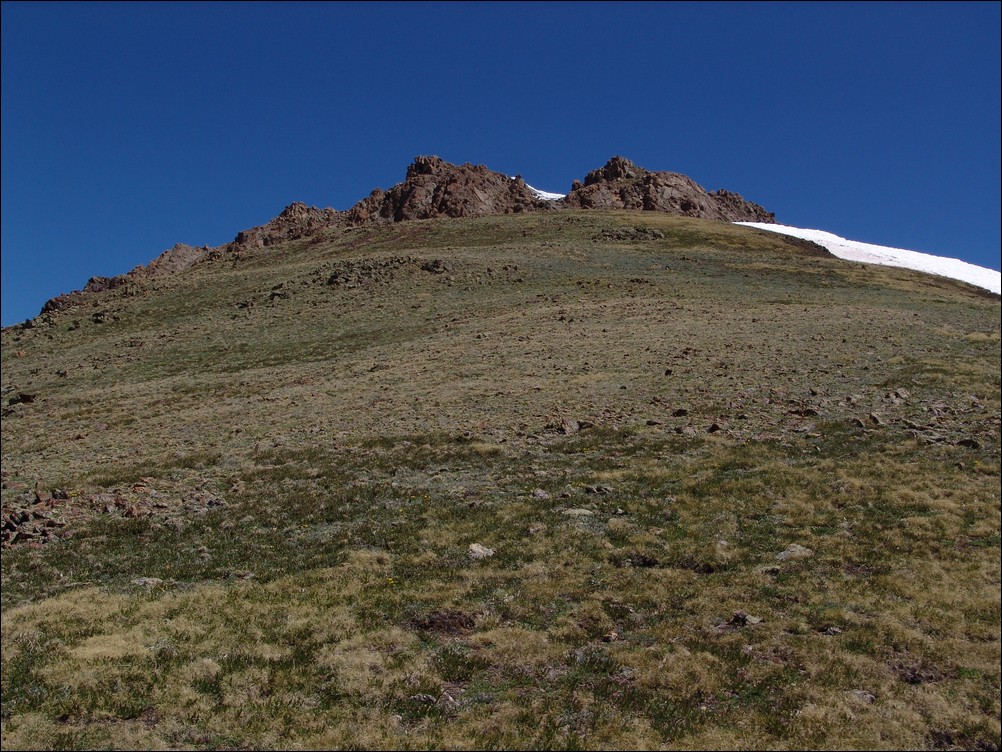
Whitecross Mountain's summit block
I also could see some amazing views of the western ridge of Handies and a couple lakes below it.
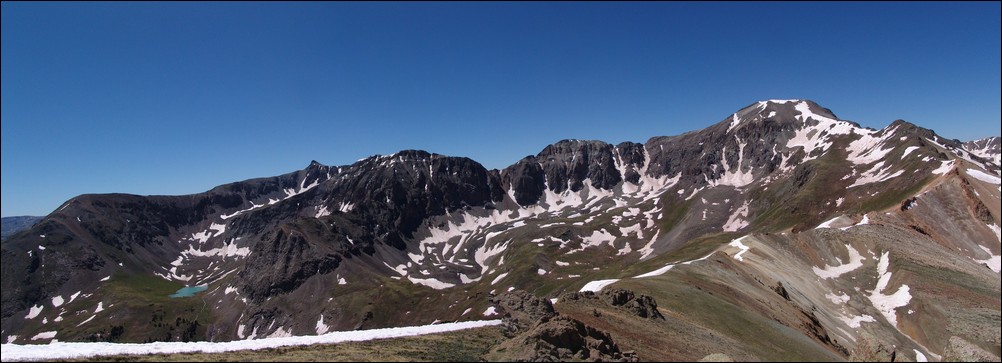
A small lake rests in the basin below the western ridge of Handies Peak.
I made my way up towards the top of Whitecross rather quickly and was greeted with views of another neat cornice sitting in front of Uncompahgre Peak and Whitecross (to its left).
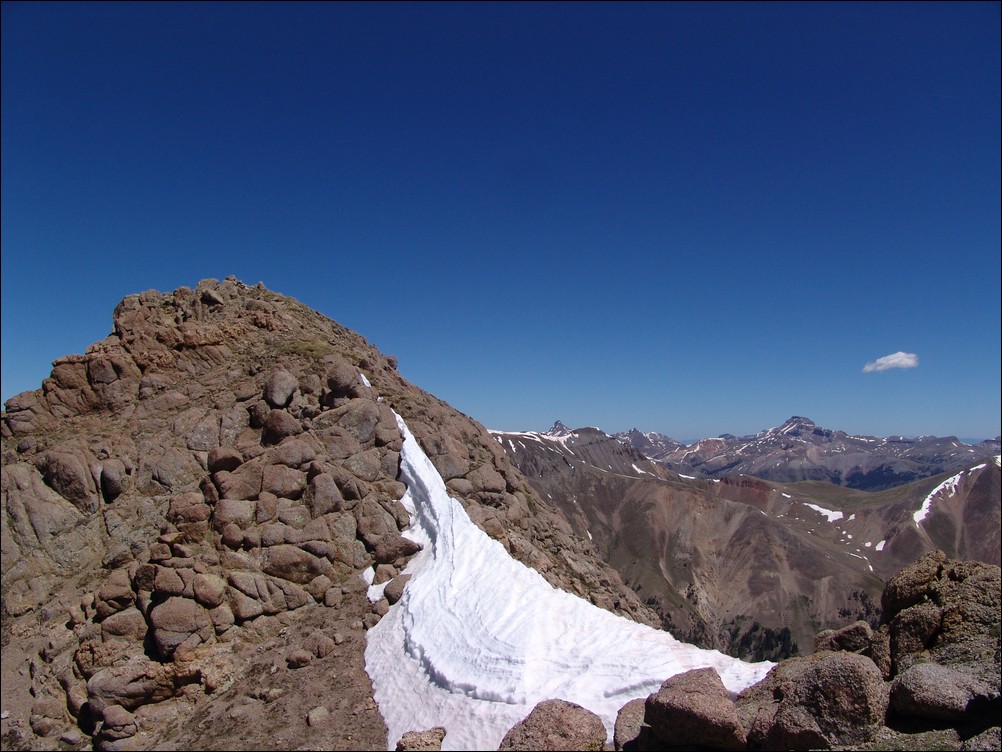
A cornice sits below the summit of Whitecross with Uncompahgre and Wetterhorn in the distance.
I finished up the climb up Whitecross and enjoyed views of Handies and the valley below Whitecross which was obscured before. The traverse from the saddle took 30 minutes on the mark.
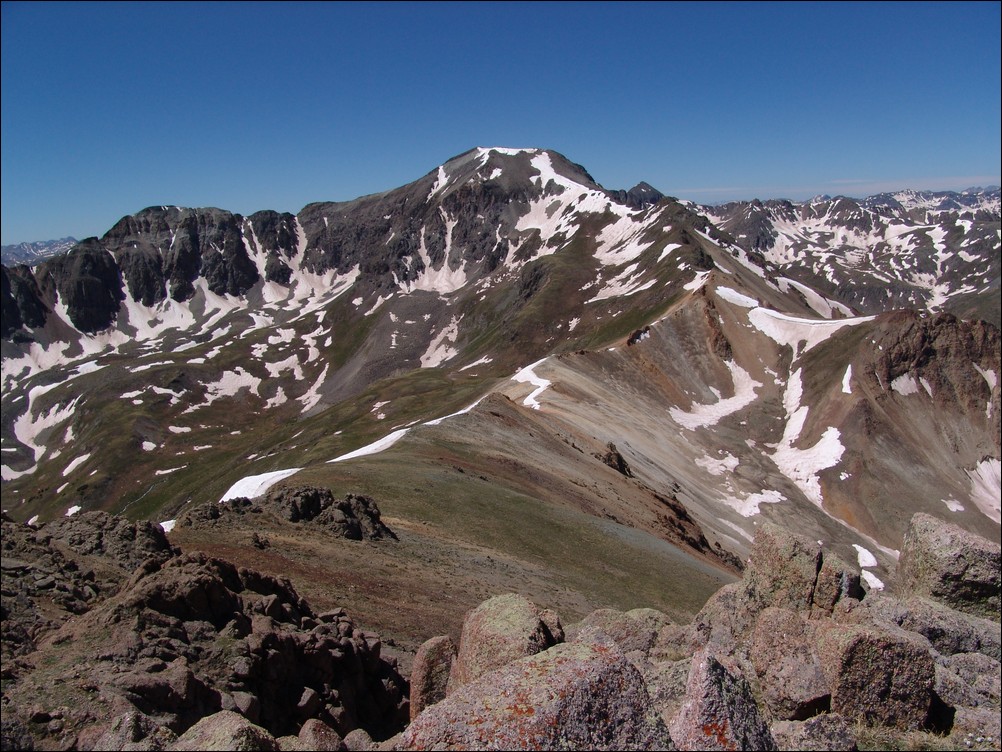
Handies as seen from the summit of Whitecross
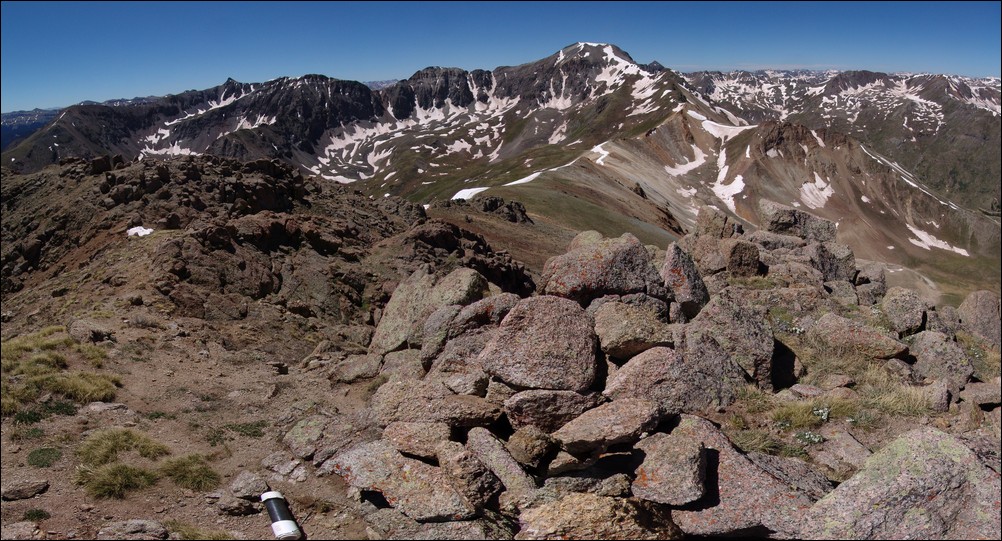
The summit register lays out on the summit of Whitecross.
I signed the summit register (first to do so in 2010), and gathered a few more photos for a panoramic photo and a self-timer summit photo.
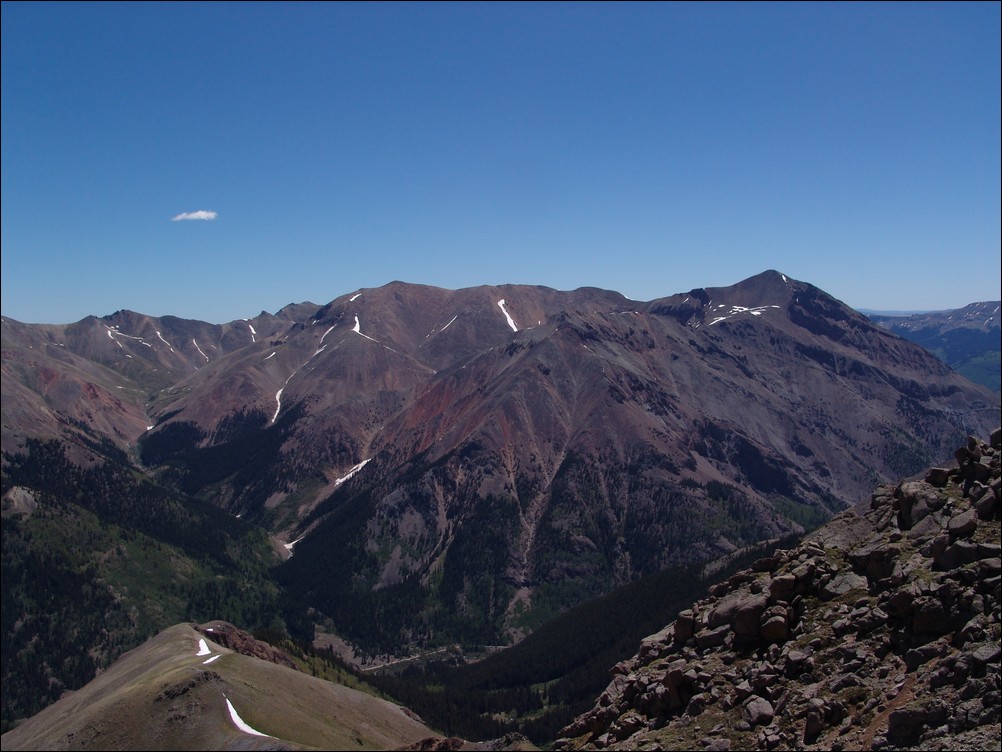
Redcloud and Sunshine are seen in better detail from Whitecross Mountain.

A view north, east, and south from Whitecross Mountain.
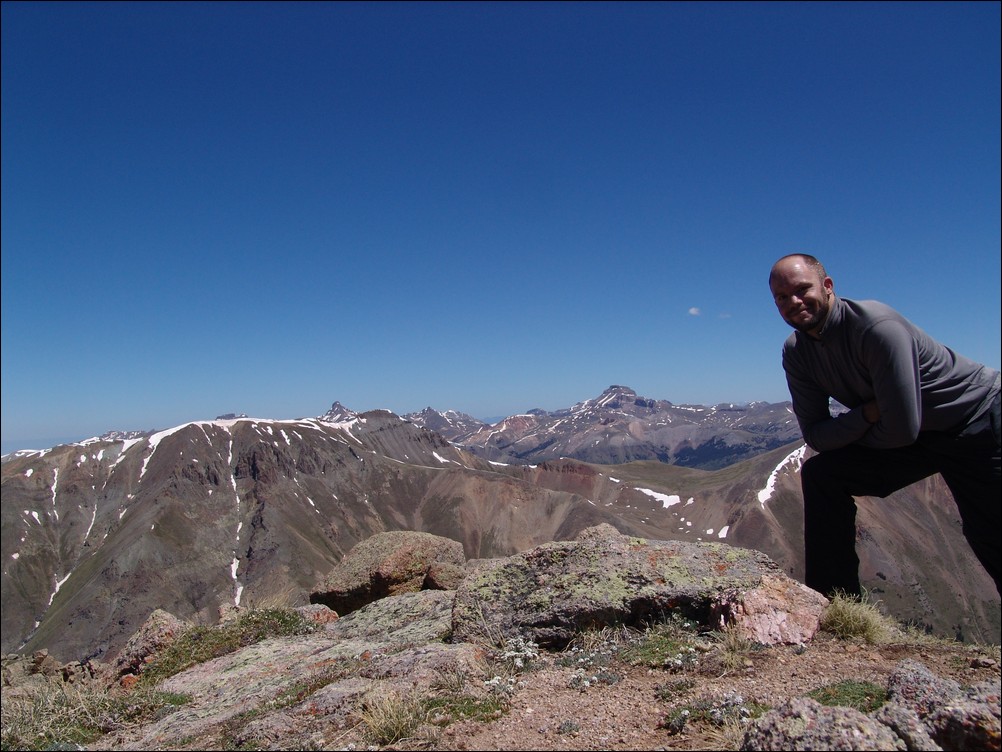
A self-timer summit shot on top of Whitecross Mountain.
After spending a few minutes on top, I headed back down the ridge towards Ray, stopping once on the way to capture a shot of some wildflowers on the ridge.
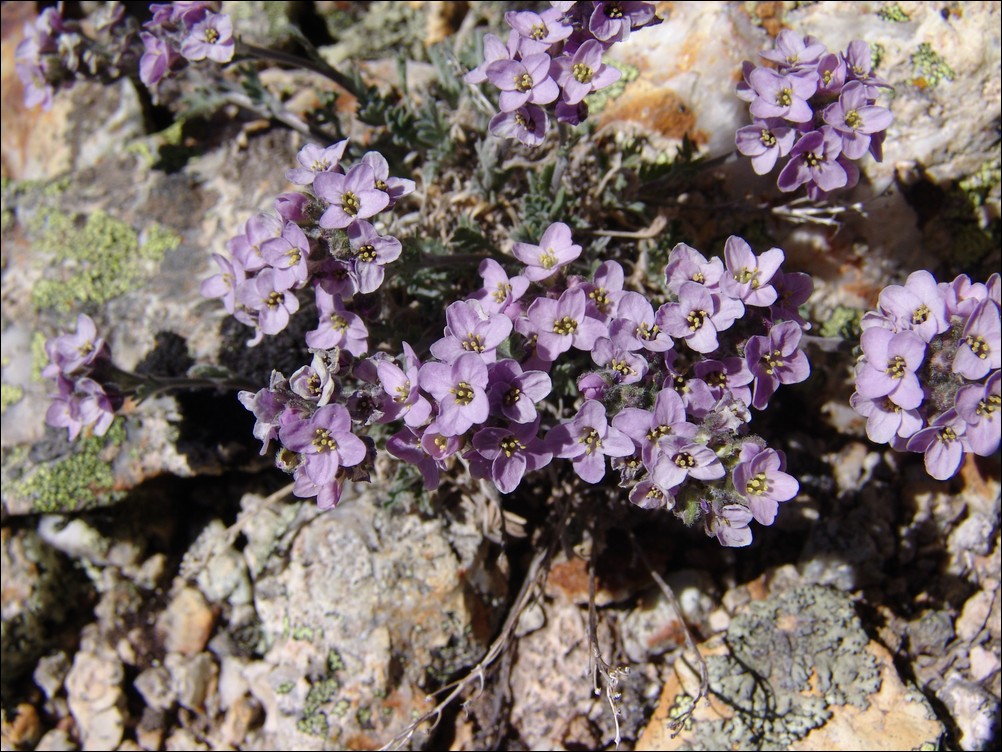
A macro shot of some purple flowers on the ridge between Whitecross and Handies.
After 20 minutes of down-climbing, I reached Ray again, having spent a total of 50 minutes on the traverse from the saddle and traveling a distance of 1.11 miles with 558 ft. of elevation gain. Ray and I packed our belongings and headed down the steep scree to the north of the saddle. We had studied our maps and determined that this route would get us back to the road eventually and that it was the safest descent route. The only downside was that we would be required to hike back up the road to my car. A small price to pay for a great traverse.
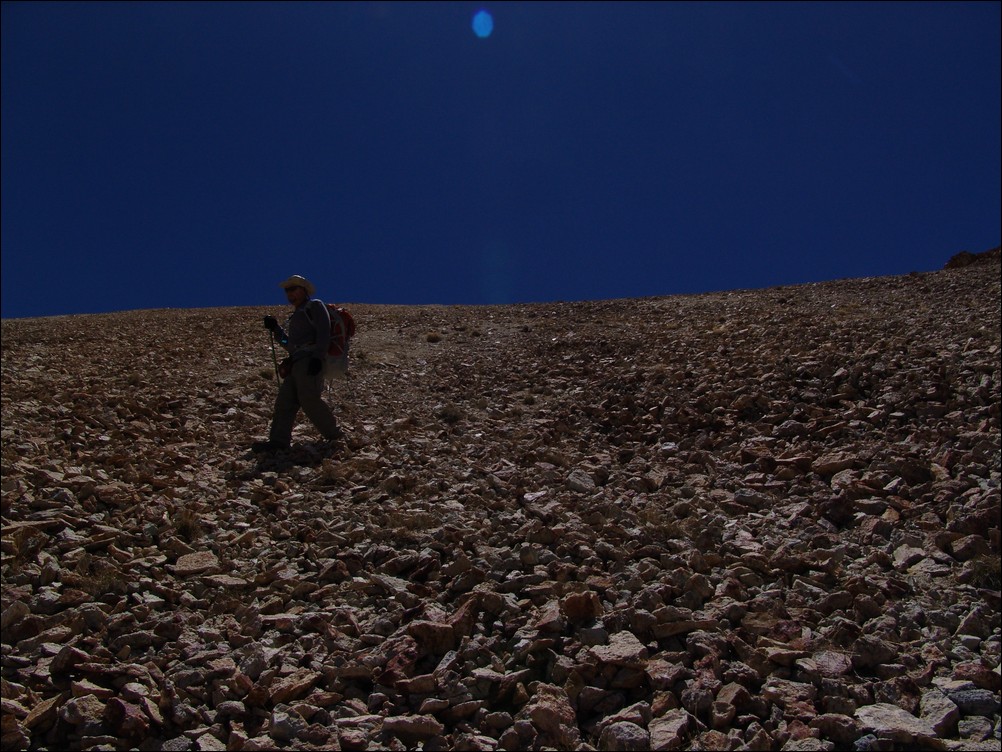
Ray descends the steep and loose scree below the Handies-Whitecross saddle.
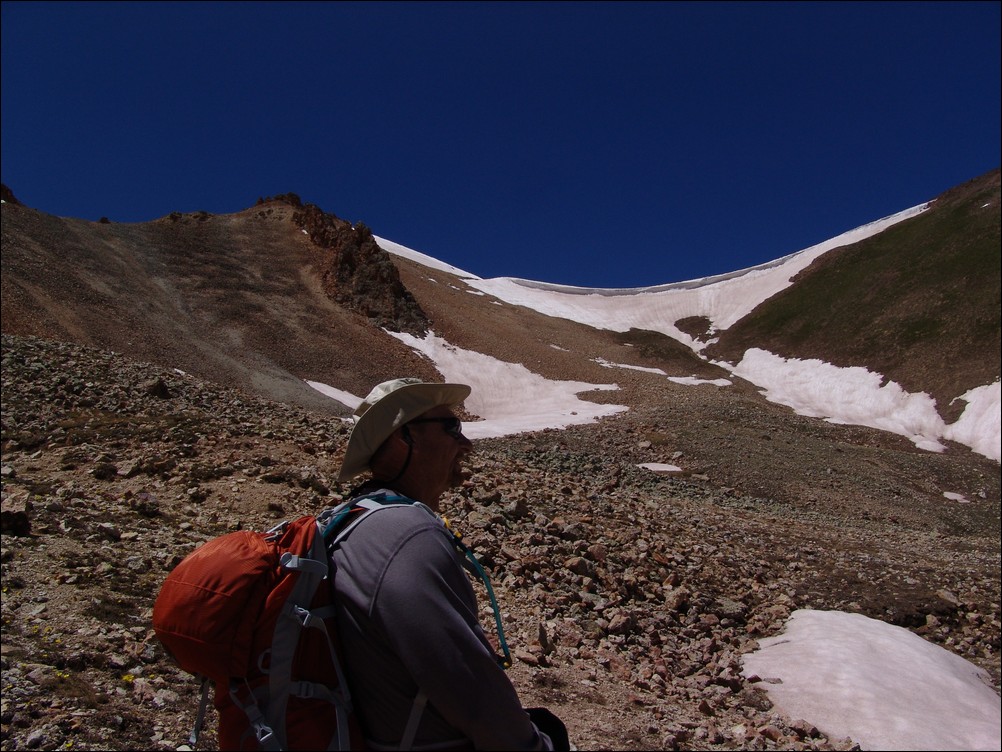
Ray Payne with the Whitecross-Handies saddle above
On the way down, we captured one last view of Uncompahgre.
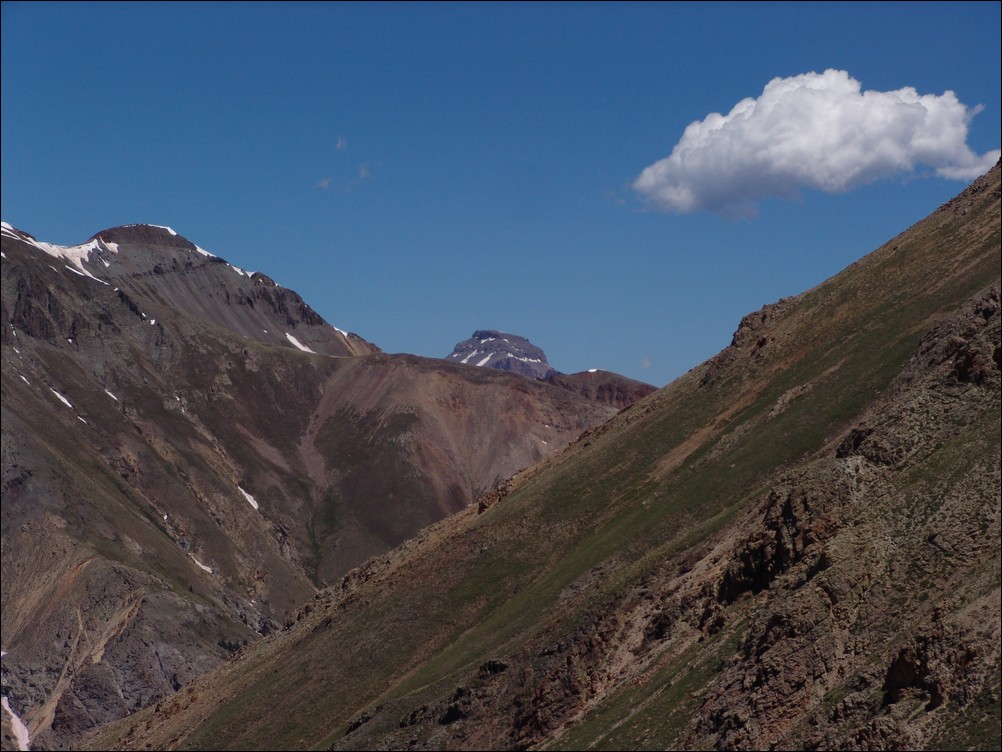
Uncompahgre Peak pokes above the surrounding ridges.
The route down towards the road was straight-forward and enjoyable. We made awesome time down towards tree-line.

A look back towards the Whitecross-Handies saddle and the steep terrain negotiated on the way down from Whitecross.
We made quick time to tree-line, and after less than an hour, we were entering the trees and much steeper terrain.
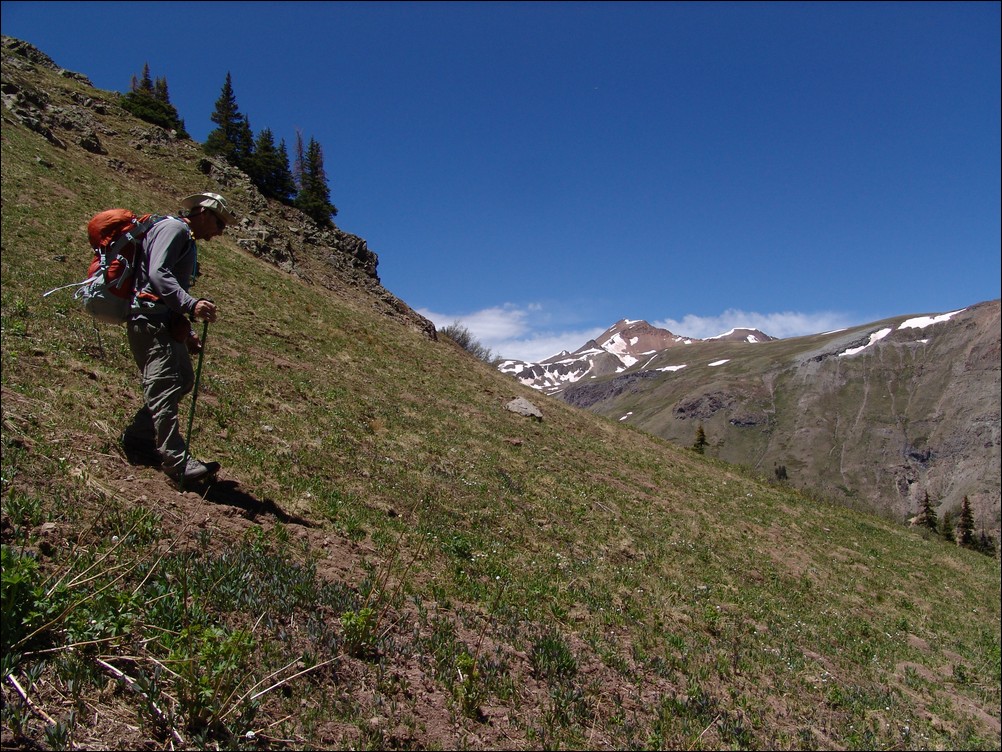
Ray Payne down-climbs from the Whitecross-Handies saddle.
The wildflowers on the fridge of the forest were amazing -yellow flowers were blooming everywhere on the mountainside.
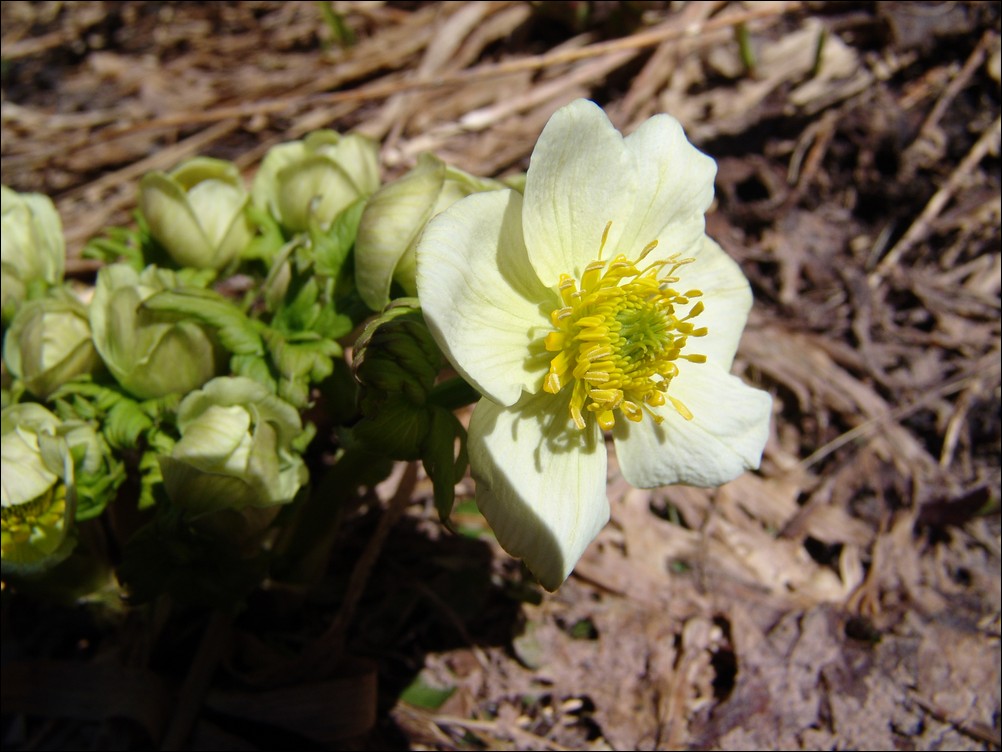
A yellow flower blooms in this macro shot near tree-line.
Soon after entering the trees, the terrain became much steeper and was littered with huge deadfall and other fun obstacles. We negotiated through the deadfall for about 20 minutes until reaching somewhat of a clearing.
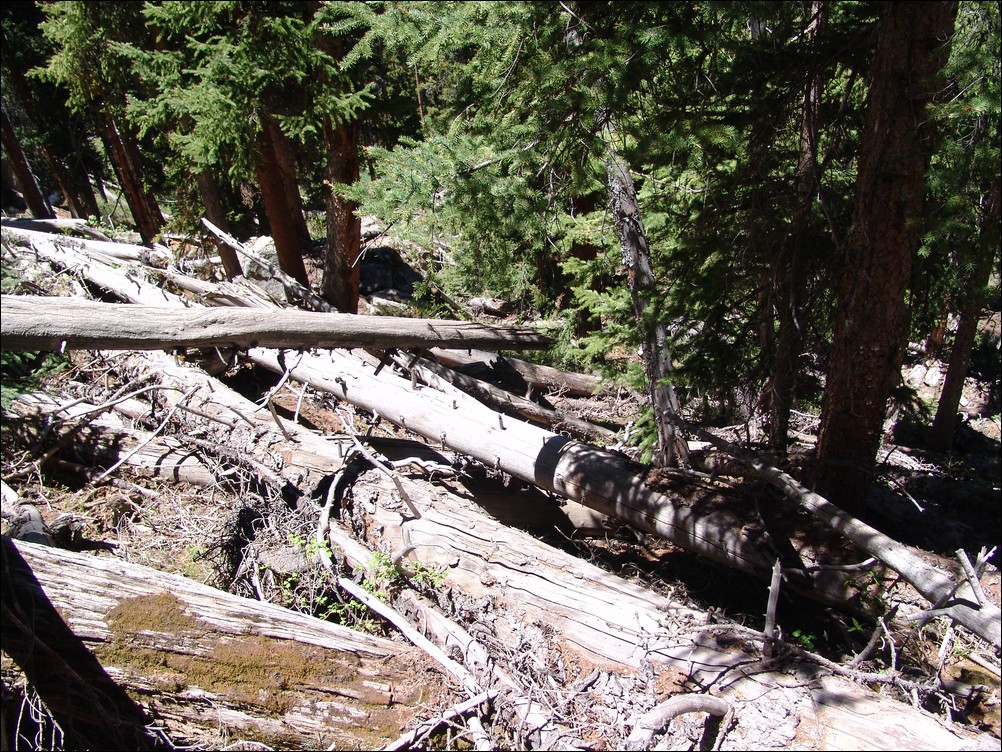
Deadfall on the descent of Whitecross and Handies.
From this clearing, we were able to find a small service road on the mountain side. We aimed for this road, hoping we were not trespassing on private property, and followed it down. We were grateful for finding the road, as it had a bridge across the Lake Fork Gunnison River where it connects with the main American Basin road.
We also saw a large mine shaft with railroad tracks leading into it - evidence of that at one time this region was heavily mined.
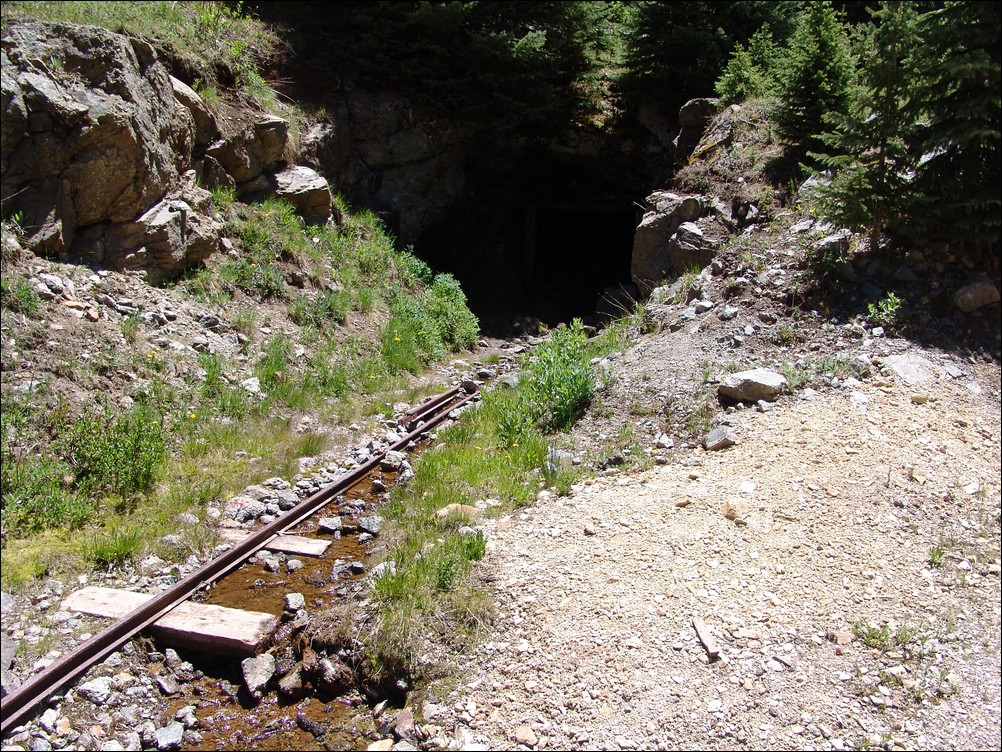
Railroad tracks lead into the darkness of an abandoned mine shaft.
Once back on the main road, we were able to get a good view of the valley and mountainside we had come down.
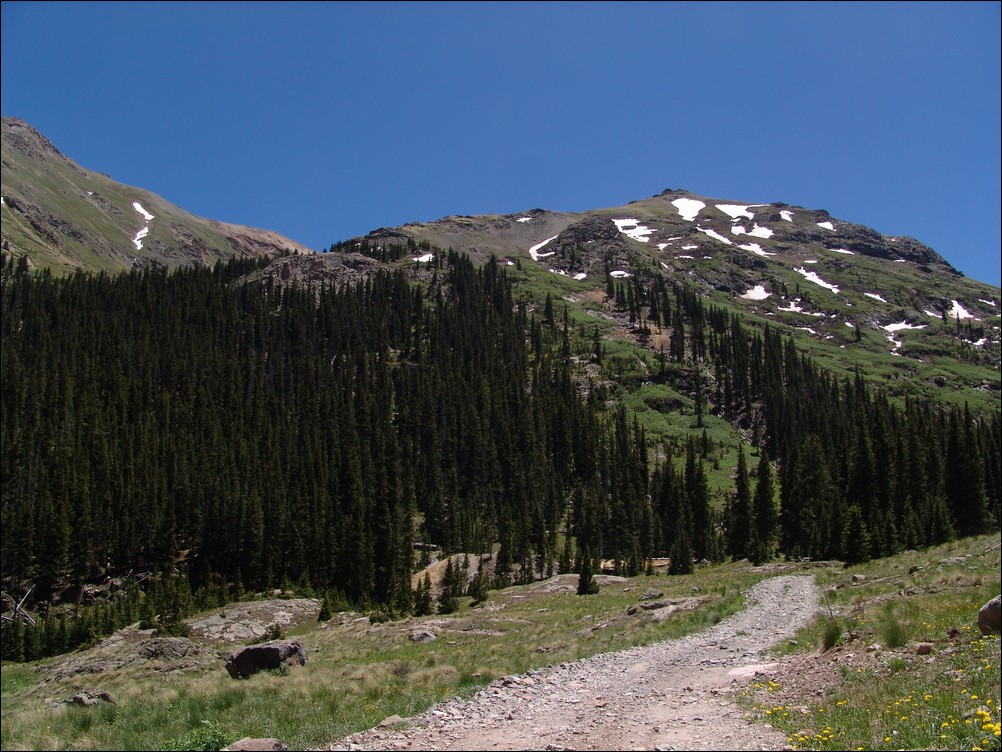
Ray and I hiked back up the road towards my Jeep. The road was pretty long and we needed to hike about a mile or so. American Basin was looking impressive in full sunlight.
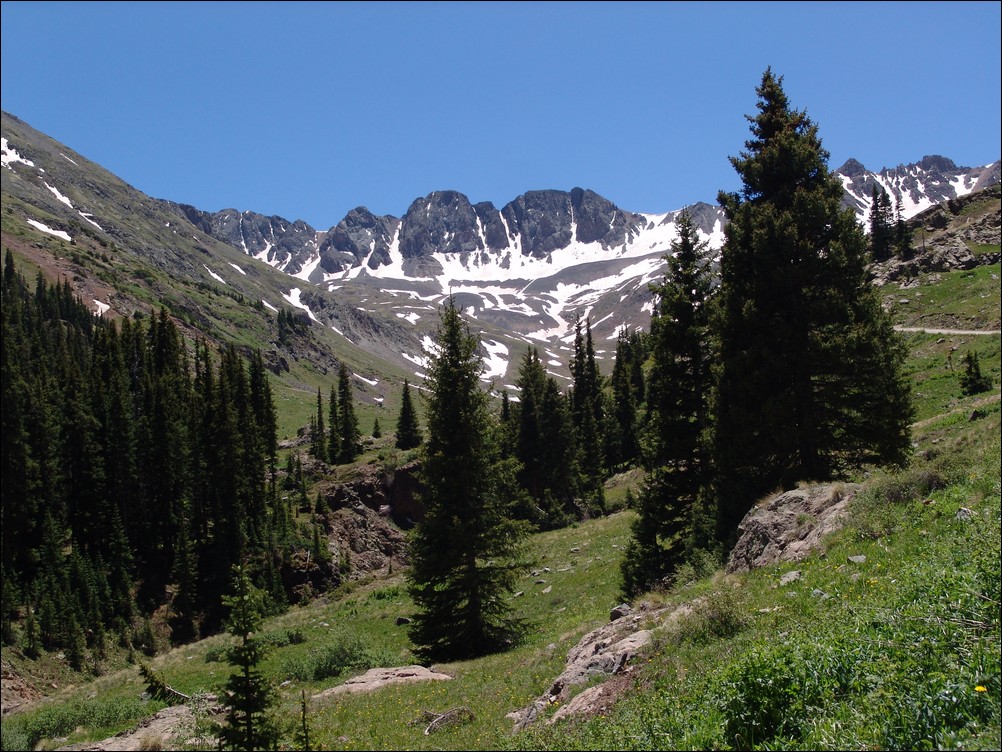
American Basin
We crossed the head of the river near a large snowbank we had noticed on the way up the night before.
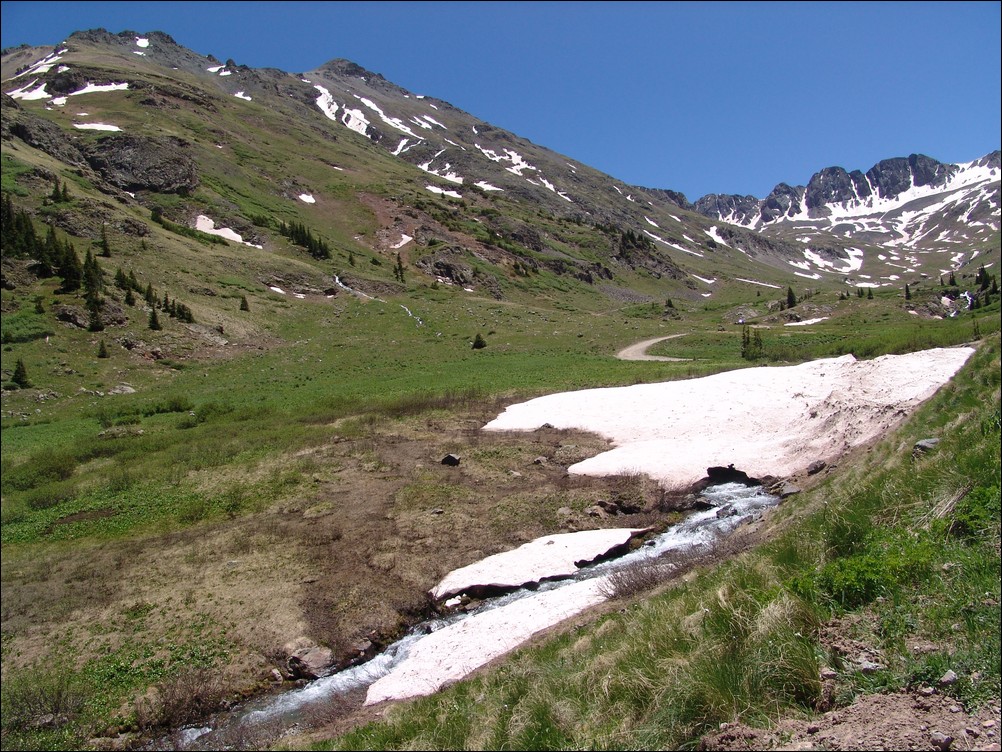
I took one more photo of the American Basin on the way back up to my Jeep. The waterfalls and surrounding terrain were very aesthetically pleasing after the long day of hiking.
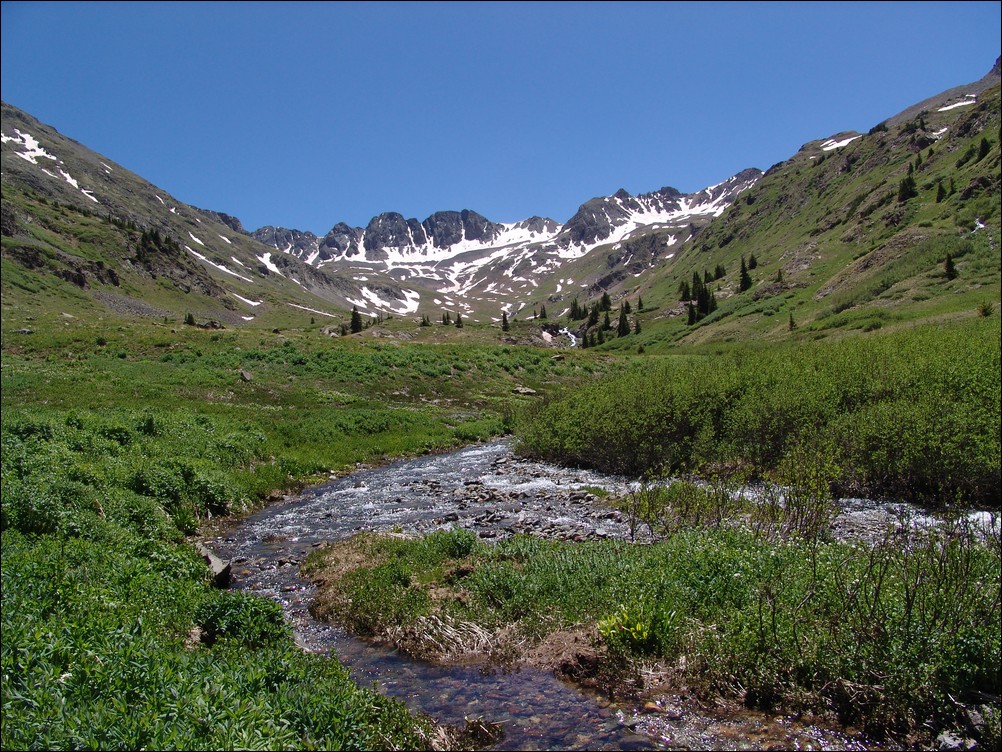
We finally made it back to the Jeep at 2:30 PM and I took one final set of photos to illustrate the daytime views from where we camped.

We packed up our gear after eating some snacks and headed back down the road in my Jeep. This is one of the best hikes up a relatively easy 14er with highly rated views. Given the ease of climb and the rewarding views, I would say that Handies Peak should be on all beginner and serious hikers' to-do lists.
I hope you enjoyed this trip report for Handies Peak and Whitecross Mountain. Next weekend: Missouri Mountain, Iowa Peak and Emerald Peak with my friend, Ethan Buete.
San Juan Mountains
The San Juan Mountains span approximately 6,000 square miles in the southwestern portion of Colorado and contain several sub-ranges, including the Grenadier Range, Needle Mountains, West Needle Mountains, La Garita Mountains and the La Plata Mountains. The San Juans are home to some of the most rugged and breathtaking mountains in the continental United States.




